February in Spain: Weather, What to Pack, and What to See
Spain may be Europe's best-kept winter secret. This Mediterranean country enjoys a much more temperate climate compared to the rest of Europe, much of which is blanketed in snow throughout February. Spain is also the only European country that you can visit during this season where you can hit the ski slopes and lay out on the beach, so it truly has it all.
Many people think of Spain and imagine a warm sandy beach on a hot summer day, perhaps with a refreshing pitcher of sangria nearby. But winter is also a great time for visiting, as temperatures are cooler and crowds are less overwhelming than during the summer months. It's also the off-season for traveling to Spain, meaning you could potentially save money on cheaper-than-normal flights and hotels.

Spain Weather in February
Spain has an area larger than California, so the weather varies significantly across the country. In general, February is chilly, but most major cities don't reach the sub-zero temperatures that other parts of Europe are concurrently experiencing.
As the highest capital city in Europe and located deep in Spain's interior, Madrid's climate often feels more continental rather than the Mediterranean. It's relatively dry and snow is rare, but nights and mornings can be bitterly cold. Barcelona is further north but on the coast, so the sea keeps the city from getting as cold as Madrid.
The southern region of Andalusia , which is unbearably hot in the summer, stays relatively comfortable during the winter. Average temperatures in major cities like Seville and Malaga are significantly higher than in the rest of Spain, although still not warm enough to sunbathe on the famed Costa del Sol. If you're truly craving some time on the beach, then you'll have to catch a flight to the Canary Islands. Located off the coast of Africa but part of Spain, these islands are the only place in Europe where you can truly lay out in the sun this time of year.
In Northern Spain, not only do temperatures drop but it rains constantly. Occasionally, it does get cold enough for it to snow as well, especially if you're visiting higher elevations. Once or twice a year, the coastal city of San Sebastian gets snowfall on the beach, making for an unforgettable sight.
What to Pack
Unless you're planning to visit the mountains on a ski trip, you won't need heavy snow gear on a winter vacation to Spain, but you'll still want to bring at least one warm jacket that you can wear with other layers depending on the weather. Also, be aware that many of the country's older buildings have poor insulation and winter nights can be chilly. To start, a good packing list should include:
- Short-sleeve shirts for layering
- Long-sleeve tops or blouses
- A sweatshirt or cardigan
- A winter jacket, such as wool or down
- A lightweight scarf or pashmina
- A dress or slightly more formal outfit for evenings out
February Events in Spain
Without a doubt, Spain's biggest event that (usually) falls in February is Carnival. It's celebrated across the country, and each city typically holds its own special celebration, although a few cities really stand out with their annual festival. Round out your trip with other major events that highlight food, art, and history.
- Carnival : You'll need a costume and lots of stamina to keep up with this week-long festival. You're likely to find some type of celebration regardless of where you are, but if you're seeking out the best Carnivals that Spain has to offer head to Tenerife in the Canary Islands, Cadiz in Andalusia, or Sitges near Barcelona. Carnival celebrations across Spain were canceled in 2021.
- Festival de Jerez : Flamenco is a long-held tradition with roots in the province of Andalusia, and this annual flamenco festival celebrates that heritage in the town of Jerez (also famous for its sherry production). Witness some of the world's greatest flamenco artists right in their own backyard. The 2021 Festival de Jerez was canceled.
- ARCOmadrid International Contemporary Art Fair : Art buffs flock to Madrid for its many museums, but only in February can you visit this renowned fair of contemporary art featuring over 1,300 artists from around the world. It's typically held in February at the massive IFEMA Convention Center, but the 2021 Art Fair was postponed to July 7–11.
- Madrid GastroFestival : Madrid celebrates culinary culture each year as cocktail bars, restaurants, and cafés all over the city come together and highlight the many dishes of Spain. Hundreds of eateries typically take part in this festival, allowing visitors to try everything from the most traditional tapas to original creations that you won't find anywhere else. However, the GastroFestival was canceled in 2021.
- Los Moros Y Cristianos : Many cities across Spain celebrate a historic festival called Los Moros y Cristianos , which literally translates to "Moors and Christians." One of the most famous is always on the first weekend of February in the small town of Bocairent, located in the province of Valencia . Citizens dress up in old garb and reenact epic battles from the Reconquista period, in this interactive event that brings out the entire local community. Most festivities, including the one in Bocairent, were canceled in 2021.
February Travel Tips
- Skip the Alps and hit the slopes in either one of Spain's acclaimed ski regions , the Pyrenees in the north or the Sierra Nevada mountains in the south. Both offer world-class runs and frequent powder snow for skiers and snowboarders.
- The Canary Islands seem far, but since February is the low season you can often find very affordable flights from Spain's mainland. The two biggest islands and best for visiting in the low season are Tenerife and Gran Canaria.
- Trains are a comfortable way to travel around Spain, but airlines often have off-season deals throughout February. Keep an eye out for domestic flights at insanely low prices.
The Best Time to Visit Spain
December in Spain: Weather, What to Pack, and What to See
Winter in Spain: Weather, What to Pack, and What to See
Weather in Spain: Climate, Seasons, and Average Monthly Temperature
May in Spain: Weather, What to Pack, and What to See
June in Spain: Weather, What to Pack, and What to See
The Best Time to Visit Johannesburg
The Best Time to Visit Madrid
April in Madrid: Weather, What to Pack, and What to See
How to Travel From Madrid to Seville by Train, Bus, Car, and Plane
The 10 Best UNESCO World Heritage Sites in Spain
May in Canada: Weather, What to Pack, and What to See
The 20 Best Things to Do in Spain
August in Spain: Weather, What to Pack, and What to See
November in Europe: Weather, What to Pack, and What to See
Best Cities to Visit in Spain in November

Weather in Spain in February: A Comprehensive Guide to Spain’s Regions
By: Author Laura Bronner
Posted on Last updated: November 7, 2023

As February dawns upon Spain, the Iberian Peninsula undergoes a captivating transformation. From the frosty peaks of the Pyrenees to the sun-kissed shores of the Costa del Sol, the weather in Spain in February promises a diverse array of climates.
In this comprehensive guide, we’ll unravel the meteorological tapestry of Spain during February, equipping you with the insights needed to plan your travels.
From average temperatures and precipitation patterns to the likelihood of snow and sea temperatures, we’ll explore what each region has in store. Whether you seek winter adventures or Mediterranean escapes, Spain’s weather in February has something for every traveler.
A Quick Overview of Weather in January in Spain
February in Spain brings a diverse array of climates. You might be asking yourself: “Is Spain cold in February?”. But the answer is complex and you can expect everything from the chilly Pyrenees to the mild Costa del Sol as the country offers a range of weather experiences.
If you are planning to come closer to the start of the year, check out our guide to January in Spain .
To help you plan your February visit, here’s an overview of the key weather metrics for Spain:
- Average Temperature : In February, Spain experiences a continuation of cooler temperatures, with the inland regions frequently being colder than the coastal areas. Typical daytime temperatures in February span from 8°C to 16°C (46°F to 61°F).
- Precipitation : February sees the rainy season drawing to a close although some northern regions are still seeing many downpours with light drizzles along the east coast.
- Snow : Snowfall is common in northern and mountainous regions such as the Pyrenees. In the south, snow is a rare occurrence.
- Sea Temperature : Sea temperatures along the Spanish coast range from 11°C (52°F) in the north to 16°C (61°F) in the south.
Now, let’s further explore February weather in Spain and specific details from various Spanish cities.
Barcelona in February is a wonderful time of year to explore some of the viewpoints which will have fewer tourists and won’t be nearly as hot as during the summer months.
Barcelona: It’s Comfortable in Catalonia
Nestled on the northeastern coast of the Iberian Peninsula, Barcelona , the crown jewel of Catalonia, beckons visitors in February with open arms. This vibrant metropolis, steeped in history and culture, offers a delightful respite from the winter chill.
As the rest of Europe grapples with the cold, Barcelona welcomes travelers with its mild climate and a unique blend of offerings that cater to a diverse range of interests.
Whether you’re an art enthusiast, a history buff, looking to explore some food tours , or someone simply yearning for relaxation under the sun, Barcelona promises an alluring and comfortable winter escape along with plenty of wonderful day trips from Barcelona to enjoy the countryside as well.
- Average Temperature : February daytime temperature averages around 13°C (55°F) and nights cool down to approximately 4°C (39°F).
- Precipitation : Expect around 40mm (1.5 inches) of rainfall and there are about 6 rainy days in February.
- Snow : Snowfall is a rare sight in Barcelona during February.
- Sea Temperature : The sea hovers at around 13°C (55°F).
- Activities : Barcelona in February invites you to wander through its historic Gothic Quarter, admire the artistic brilliance at Park Güell, and indulge in cultural delights within its museums and theaters. You can also get out to places like Girona or Zaragoza from here with ease for a day or two.
Spain in February is a wonderful time of year to enjoy the pintxos bars around northern Spain.
Northern Spain: A Chilly Charmer
Northern Spain, encompassing cities like Bilbao , Santander, and San Sebastian, experiences a cooler February compared to the rest of the country. While the weather may not be ideal for sunbathing, the region boasts its own unique charm. Expect a refreshing escape from the intense winter cold found in other parts of Europe.
- Average Temperature : Daytime temperatures range from 10°C to 15°C (50°F to 59°F), while nights can drop to 5°C to 8°C (41°F to 46°F).
- Precipitation : Northern Spain sees a fair amount of rain, with around 80-100mm of rainfall during February and approximately 10-12 rainy days.
- Snow : Snowfall is not uncommon in the mountainous areas, providing an opportunity for winter sports enthusiasts.
- Activities: This region offers a perfect setting for nature enthusiasts. Explore rugged coastlines, lush green landscapes, and charming coastal towns. Don’t miss out on indulging in the local cuisine, including delectable seafood and pintxos. It’s a great time of year in Northern Spain to visit the cities or enjoy the moody views out over the Bay of Biscay.
Málaga and the Costa del Sol: Winter Sun Haven
Málaga, a picturesque coastal city situated on the renowned Costa del Sol , is nothing short of a winter haven for those in pursuit of a sun-kissed escape. As February unfolds, this Mediterranean gem unveils its splendid climate, inviting visitors to bask in the gentle warmth of the sun and embrace a sense of tranquility.
The city’s allure lies not only in its pleasant temperatures but also in the seamless blend of historical charm and modern-day leisure, making it an ideal destination for those yearning for a generous dose of sunshine, relaxation, and cultural exploration.
Whether you want to dabble in the art scene (it is after all the home of Picasso!) or learn more about Roman and Moorish history. There are truly endless things to do in Málaga .
- Average Temperature : Expect daytime temperatures around 17°C (63°F) with nighttime temperatures staying mild at 8°C (46°F).
- Precipitation : February brings occasional rain, with around 40mm of rainfall and about 6 rainy days.
- Snow : Snowfall is exceptionally rare in this Mediterranean paradise.
- Activities : Embrace the sunny days by strolling along the beautiful Málaga beaches , visiting historical landmarks like the Alcazaba, wandering through the different Málaga neighborhoods , and savoring local Andalusian cuisine.
Valencia in February is absolutely amazing. Blue skies, fewer tourists, and still all of the great museums and markets to enjoy.
Valencia: The Perfect Blend of Warmth
Valencia enjoys a comfortable climate in February, offering a perfect blend of warmth and cool breezes. The city exudes a welcoming atmosphere, making it an attractive destination for travelers seeking a mix of relaxation and cultural experiences.
The city is well known as one of the sunniest places in Spain in winter. If you want to go for long runs along the sandy Valencia beaches , cold dips in the Mediterranean Sea, or enjoy dining al fresco at one of the many tapas bars in Valencia, life in this part of Spain in February is just better. This is a wonderful time of year to visit the city and enjoy all of the different things to do in Valencia .
- Average Temperature : Daytime temperatures hover around 16°C (61°F), while nights are pleasantly cool at 7°C (45°F).
- Precipitation : Expect around 22mm of rainfall, with about 4 rainy days during the month.
- Snow : Snow is virtually unheard of in Valencia during February.
- Activities : Explore the futuristic City of Arts and Sciences, stand in awe of La Lonja de la Seda, indulge in a paella feast (Valencia’s signature dish), and soak in the relaxed Mediterranean ambiance.
Madrid in February is chilly but crisp and great for exploring the hot chocolate shops and museums.
Madrid: Winter Charm in the Capital
Madrid, the regal heart of Spain, dons a captivating winter coat in February, offering a distinctive allure that sets it apart from its coastal counterparts. It is without a doubt one of the most beautiful cities in Spain no matter what time of year you want to visit.
While the climate may not rival the balmy shores, Madrid beckons visitors with a unique charm, a refreshing absence of crowds, and an exclusive opportunity to explore the city through the lens of a local. In this winter wonderland, the Spanish capital unveils its hidden treasures, exuding a certain magic that captivates the soul.
You will want to spend at least 3 days in Madrid to enjoy all of the wonderful sights there are to explore and all of the cool Madrid neighborhoods .
- Average Temperature : February days are crisp, with temperatures around 10°C (50°F), and nights can get chilly, dropping to 2°C (36°F).
- Precipitation : Madrid experiences around 20mm of rainfall and approximately 4 rainy days during the month.
- Snow : Snowfall is a possibility in February, turning the city into a picturesque winter wonderland.
- Activities : Explore the historic Royal Palace, and art museums, and savor hearty Spanish dishes in cozy, local restaurants.
Spain in February in places like Alicante and Seville allow you to spend a lot more time outside in spring-like weather.
Alicante: A Sunny Winter Escape
Alicante, nestled along the radiant Costa Blanca, allows travelers in February to bask in the glory of abundant sunshine and warm, azure skies.
This picturesque city transforms the winter blues into an inviting haven of sunlight and relaxation. As Northern Europe grapples with chilly temperatures, Alicante extends a warm and hospitable hand to those seeking a delightful contrast and a rejuvenating escape from the frosty grasp of winter.
It is consistently ranked as one of the warmest places in Spain in winter and people from all over the country flock here for its sunny microclimate.
- Average Temperature : Daytime temperatures reach approximately 17°C (63°F), and nights remain mild at 8°C (46°F).
- Precipitation : Expect around 20mm of rainfall and about 5 rainy days in February.
- Snow : Snow is a rarity in Alicante, allowing for a sun-soaked vacation.
- Activities : Enjoy the beautiful Alicante beaches , explore Santa Barbara Castle, and sample fresh seafood at the local restaurants. There are plenty of fun things to do in Alicante to keep you busy if your trip falls on one of the month’s 5 rainy days.
Almeria: A Mediterranean Gem
Almeria, often referred to as a hidden gem on Spain’s southern coast, reveals its captivating allure in February. This coastal city proudly boasts a Mediterranean climate, making it an ideal destination for a pleasant winter getaway.
As the crisp air of winter touches the region, Almeria remains a sanctuary of warmth and serenity, inviting you to explore its unique landscapes and immerse yourself in its rich history and cultural mosaic. Here, the Mediterranean magic thrives even in the heart of winter, promising an enchanting and comfortable experience.
- Average Temperature : Daytime temperatures average around 18°C (64°F), and nights stay mild at 9°C (48°F).
- Precipitation : Almeria experiences minimal rainfall, with approximately 15mm, and only 3 rainy days during February.
- Snow : Snowfall is almost unheard of in this warm region.
- Activities : Discover the unique landscapes of the Tabernas Desert , visit historic sites like the Alcazaba, and savor local dishes with an Arabic influence.
Seville is a great place to visit in February in Spain.
Seville: Andalusian Elegance in Winter
Seville, the radiant jewel of Andalucia, unfurls its welcoming arms to visitors in February, offering a climate that blends mildness with exquisite Andalusian charm. This enchanting city is the ideal destination for immersing yourself in rich history and cultural heritage while enjoying the caress of a gentle winter breeze.
As the rest of Europe shivers, Seville remains inviting, beckoning you to explore its picturesque streets, historical marvels, and vibrant soul, all amidst an atmosphere of comfortable warmth.
Whether you want to explore all of the best things to do in Seville or you want to head out to explore some of the nearby cities of Córdoba or Cadiz for a Seville day trip , there is so much to enjoy about this region of Spain in February.
There are significantly fewer tourists around at this time of year and the normally steaming hot city is a pleasant temperature that allows for things like bike rides and boat tours without sweating like crazy.
- Average Temperature : Expect daytime temperatures around 18°C (64°F) and nighttime temperatures at 8°C (46°F).
- Precipitation : February sees around 40mm of rainfall and approximately 6 rainy days.
- Snow : Snow is virtually non-existent in Seville during February.
- Activities : Visit the magnificent Alcazar, explore the Barrio Santa Cruz, and savor traditional tapas while enjoying flamenco performances.
Ibiza in February is a wonderful place to spend some warmer days.
Ibiza: Off-Season Tranquility
Ibiza, world-famous for its electric summer parties, gracefully metamorphoses into a tranquil, off-season sanctuary in February. During this quiet interlude, the island’s pristine natural beauty and serene tranquility shine through, creating an entirely different kind of allure.
With the absence of the summer crowds, Ibiza invites you to explore its untouched landscapes, savor its peaceful ambiance, and embrace the natural splendor that weaves its own unique charm throughout the winter season.
- Average Temperature : Daytime temperatures average around 15°C (59°F), with nights staying mild at 8°C (46°F).
- Precipitation : Expect around 40mm of rainfall and approximately 7 rainy days during the month
- Snow : Snowfall is exceedingly rare on the island.
- Activities : Discover the serene Ibiza beach clubs , explore Ibiza Town’s historic sites, check out some of the cool things to do in Ibiza , and enjoy local cuisine in cozy restaurants.
Canary Islands: A Subtropical Paradise
The Canary Islands, encompassing the enchanting realms of Tenerife, Gran Canaria, Lanzarote, and more, stand as perpetual paradises, offering a taste of eternal subtropical bliss.
In February, while much of the world shivers through winter’s grasp, these idyllic islands remain steadfast in their commitment to providing an oasis of warmth and serenity.
As you step onto their shores, you’ll find a welcome escape from the winter chill, with year-round sunshine and an invitation to bask in the embrace of an ever-present, gentle warmth. The Canary Islands, a treasure trove of natural wonders, await your discovery.
- Average Temperature : Daytime temperatures range from 20°C to 23°C (68°F to 73°F), and nights remain pleasantly mild at 13°C to 15°C (55°F to 59°F).
- Precipitation : February is relatively dry, with around 15mm of rainfall and only 4 to 5 rainy days.
- Snow : Snowfall is virtually unheard of in the Canary Islands at any time of year.
- Activities : Explore volcanic landscapes, relax on stunning beaches, and indulge in water sports and outdoor adventures. The islands offer year-round opportunities for hiking and water-based activities.
Seville in February is such a wonderful time to explore the city.
What Else Is Happening in Spain in February?
February in Spain is a month of unique charm, offering festivals, food, and activities that reflect the country’s rich cultural heritage.
Despite the cooler temperatures, this is a time when Spain comes alive with celebrations and culinary delights. Here are some of the most enticing things to do in Spain during February.
Carnival Celebrations
Carnival in Spain during February is a time of vibrant, exuberant celebration that embraces the spirit of indulgence before the onset of Lent. Streets come alive with parades, colorful costumes, and joyful music, with cities like Tenerife and Cadiz hosting some of the most famous and extravagant Carnival festivities.
It’s a time for revelers to don masks, disguises, and celebratory outfits, providing an opportunity to temporarily shed their identities and engage in playful and mischievous behavior. The air is filled with the infectious rhythms of samba and other upbeat music, enticing people to dance in the streets with an unbridled spirit.
In Cadiz, satirical songs known as “chirigotas” add humor to the celebrations. Traditional sweets like “orejas” and “buñuelos” are savored, and festive cocktails and punch are enjoyed.
As part of these festivities, Carnival often crowns a King and Queen of Carnival, selected through spirited competitions and parades. Carnival in Spain is a dynamic, cultural extravaganza that showcases the country’s rich tradition of revelry and merriment, making it a must-visit event for those seeking a lively and unforgettable experience in February.
Andalusian Almond Blossom
In southern Spain, particularly in the Andalusian region, February marks the beginning of almond blossom season. The countryside is adorned with delicate white and pink flowers, creating a stunning backdrop for leisurely strolls and one of the best places in Spain in February for photography.
In various parts of Spain, including Mallorca and the Jerte Valley , almond and cherry blossom festivals take place in February. These festivals celebrate the blooming orchards with parades, traditional dances, and tastings of local products.
Calçotada
In Catalonia, the Calçotada festival is a February tradition. Locals gather to enjoy calçots, a type of green onion, grilled over an open flame and dipped in romesco sauce. It’s a delicious and communal food experience.
Semana de Flamenco
The city of Jerez de la Frontera, in Andalucia, hosts the Semana de Flamenco , the week of Flamecio, in late February. It celebrates the art of flamenco with performances, workshops, and exhibitions. It’s a fantastic opportunity to immerse yourself in the passionate world of Spanish music and dance.

Visit Spain in February: Cities, Towns, and Festivals
Some of Spain’s most exciting cultural experiences occur in February, making it an ideal time to visit. In this post, we’ll help you discover the best cities to visit during February, the best things to do, and tips to make your February trip just as amazing as any summer trip.

Hi, we’re Timon & Filipa!
We travel across Spain in our motorhome, Speedy, and update TravelSpain24 with fresh content, practical tips, and personal stories from the road. Our goal is to help you experience Spain beyond the typical tourist trails.
Spain in February: The Weather
Given its reputation as a hot summer holiday destination, it is easy to think of the Spanish weather as beach-going weather year-round. It’s important to remember though, that Spain is a large country, at least by European standards.
It has the same land mass as the entirety of Central America, meaning the climate of Spain varies between the country’s different regions as well as with the months of the year. In February, you can choose between hitting the Spanish ski slopes and laying on the pristine famous beaches. You truly do get the best of both worlds.
Madrid and the cities more to the north, like Bilbao and Barcelona , resemble a more continental winter with chillier temperatures, although temps rarely drop below freezing. Due to its drier climate, Madrid rarely sees snow, but once or twice a year, places like San Sebastian, a coastal city near the French border, get snowfall on the beach. However, February brings more rainfall on average to the north of Spain, meaning you will need to pack a good raincoat.
For those hoping for less of a winter getaway and more of a getaway from winter, a trip to the south of Spain may be more appropriate. The southern regions can be unbearably hot during the summer months making the mild February weather a wonderful time to visit, especially when trying to enjoy the great outdoors.
While temperatures on the Costa del Sol might be temperate compared to their continental neighbors, it might still be just a bit too chilly for a day of sunbathing by the beach. Luckily, Spain’s islands make for lovely, warm-weather winter holidays, especially the Canary Islands, located off the coast of Africa. While temperate compared to their summer temperatures, it is still warm enough in February to have a day by the beach.
Spain in February: Top Spanish Cities To Explore
Spain in February has a different allure than during the peak seasons. There are different things to do and, therefore, are different places you should go. The different experiences through the seasons in Spain also make it an amazing place to stay longer-term as well, especially with a family.
Some of the best places to visit in Spain are also some of the best places to live in Spain with family if you do find yourself not wanting to leave so soon. Knowing where to spend your time is key whether you are in Spain long-term or just visiting for a short trip.

Granada, located in Andalusia in southern Spain, is steeped in history and natural beauty. Sat at the foot of the famous Sierra Nevada mountains , Grenada is known for its beautiful medieval architecture dating back to the Moorish occupation.
The most impressive of these structures is the Alhambra , one of the best-preserved palaces of the historic Islamic world. The breathtaking view of the Alhambra against the backdrop of the potentially snowy Sierra Nevada mountains makes February arguably, the best time to visit Granada , especially for skiers.
Since prime-time Spanish ski season runs from January to March , a February ski trip staying at one of the mountain’s many ski resorts would be ideal.
- Hotel Maribel
- Vincci Selección Rumaykiyya
- Melia Sierra Nevada
2. Valencia

Valencia is one of Spain’s largest cities, located along Spain’s eastern coast, and for good reason. Given its location and history, locals living in Valencia year-round really have access to all the best that Spain has to offer. In February, this means temperate climates where you’ll see the almond and orange trees coming into blossom, making it an exceptionally beautiful time to visit.
By taking advantage of the cheaper winter prices, you can stay in the charming Old Town and have access to the city’s best winter activities.
The weather makes it a great time to check out local parks or other outdoor spaces, such as the City of Arts and Sciences or one of the city’s historic medieval markets. It is also worth noting the various February festivals not to miss while in Valencia, such as Carnival or Las Fallas.
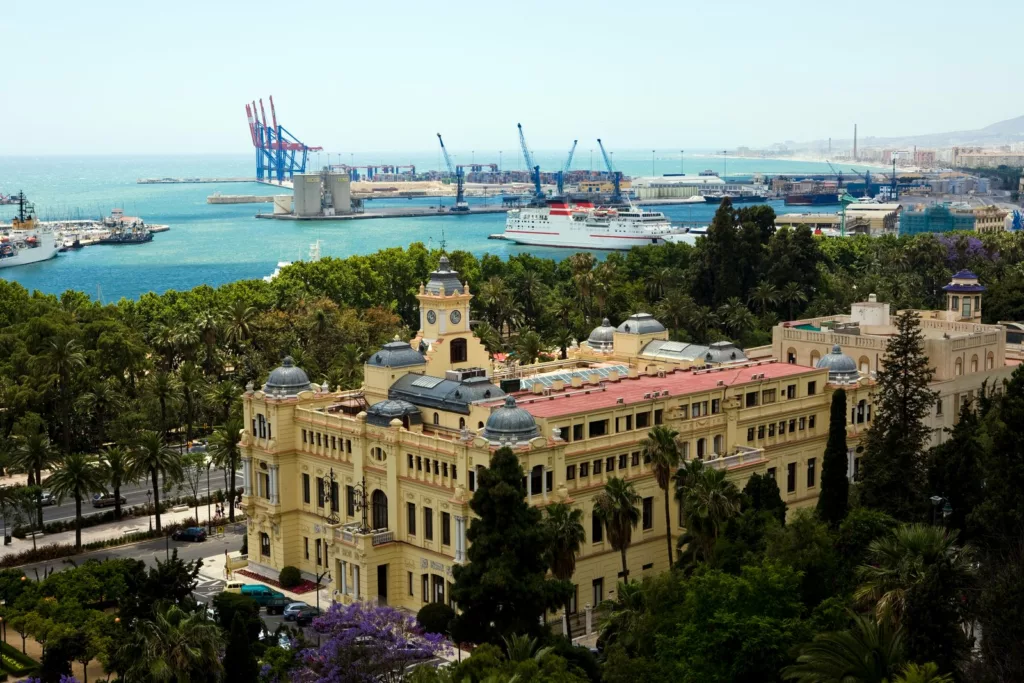
Located along the infamous Costa del Sol, Malaga is an extremely popular summer holiday destination. In the summer, however, temperatures can reach a scorching 110°F/43°C, making a mild February 64°F/18°C seem like a strong contender for the best time to visit Malaga .
The milder climate is also accompanied by quieter beaches, making for a much more relaxing trip as well, away from all the crowds. History lovers will also appreciate Malaga’s ancient Roman and Moorish history, and a stay in the historic city center gives you great access to all the best Malaga winter attractions.
Spain in February: Visit Smaller Towns
One of my favorite ways to embrace the true culture of a place is by visiting smaller towns, away from the commercialized big cities. Visiting smaller towns has a quaint charm that is really impossible to find inside the larger cities and more often represents the true culture of the area.
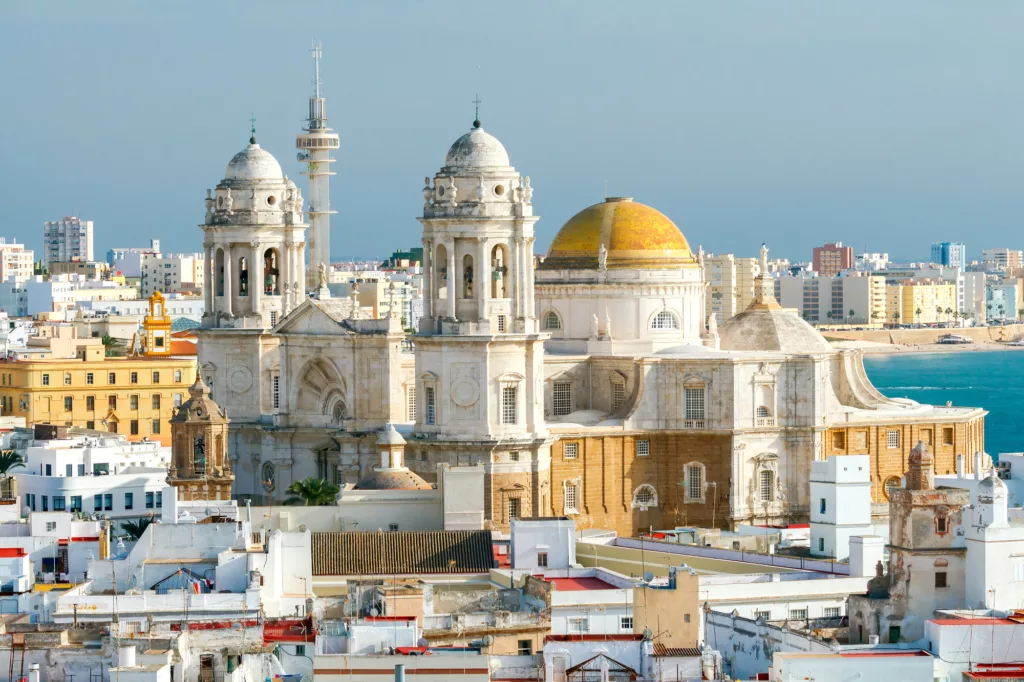
Cadiz is a city steeped in history. Home to the Spanish Navy, the port city is located along the western coast of the southern region of Andalusia. It is one of the oldest cities in Western Europe, having been founded by the Phoenicians, who established a port there in the 7th century BC. The port saw Roman and Moorish rule and served as a vital port during the Spanish Empire.
Given its location along a narrow strip of land jetting out into the Atlantic, the city boasts beautiful historic architecture along the backdrop of stunning sea views. Because the city is packed with the mixing of history and cultures, one of the best ways to see the city is through a guided city tour to make sure you don’t miss anything.
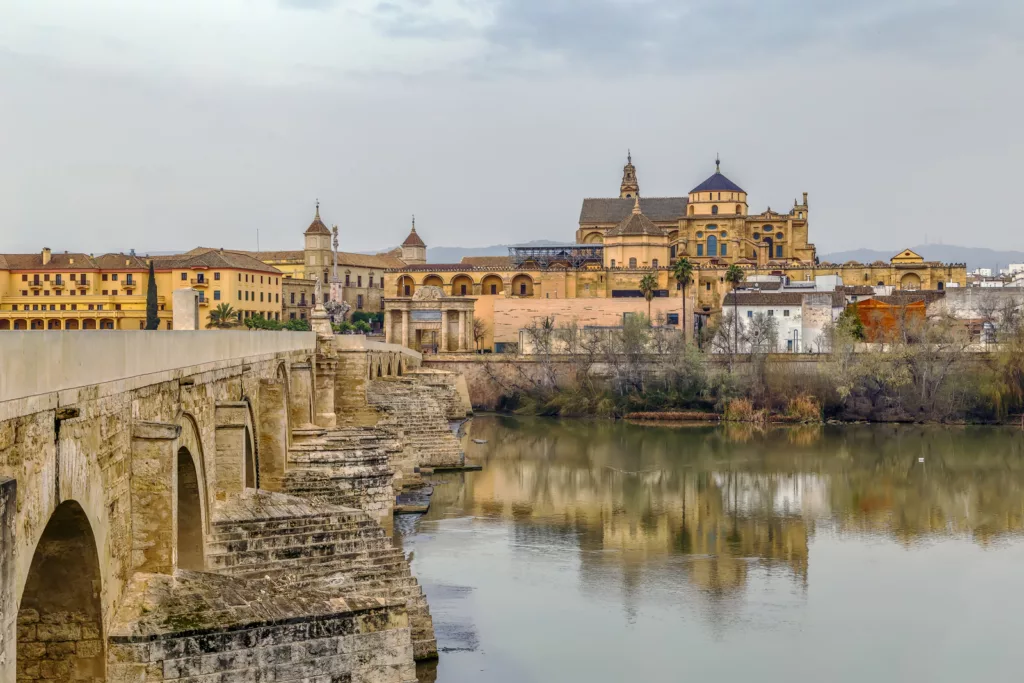
Cordoba is a history lover’s dream. The Andalusian city was originally a Roman settlement before eventually becoming the capital of Moorish Spain . Perhaps the most significant structure in the city is the ancient Mezquita. Originally a mosque built under Cordoba’s Islamic rule, the Mezquita, a UNESCO World Heritage site, was later transformed into a cathedral and even today holds a daily Mass.
Nearby, the Jewish quarter can also be found, boasting its own impressive religious structure, the Córdoba Synagogue. There is so much to see, so booking a historical tour from Viator with skip-the-line tickets can help you make sure you see all the cultural sites.

Carved into the mountains of east-central Spain, Cuenca’s picturesque architecture is as dazzling as its history. With its proximity to Madrid, Cuenca is one of the best day trips from Madrid being less than a two-hour drive away.
Founded by the Moors, Cuenca retains its historic city walls and medieval cobbled streets in its charming old town. The unique hanging houses perched precariously along the town’s cliffsides make for some stunningly beautiful and rather unique views.
To make the most of a day trip to Cuenca, we recommend booking a day trip to Cuenca tour since they will show you around and get you there and back via coach bus.
Spain in February: Things To Do
Given the milder temperatures, a beach day probably isn’t going to be suitable for your Spanish winter getaway . Luckily, Spain is much more diverse than just its beaches, and visiting in February is a great way to indulge in other aspects of the Spanish way of life.
1. Almond Blossom Viewing
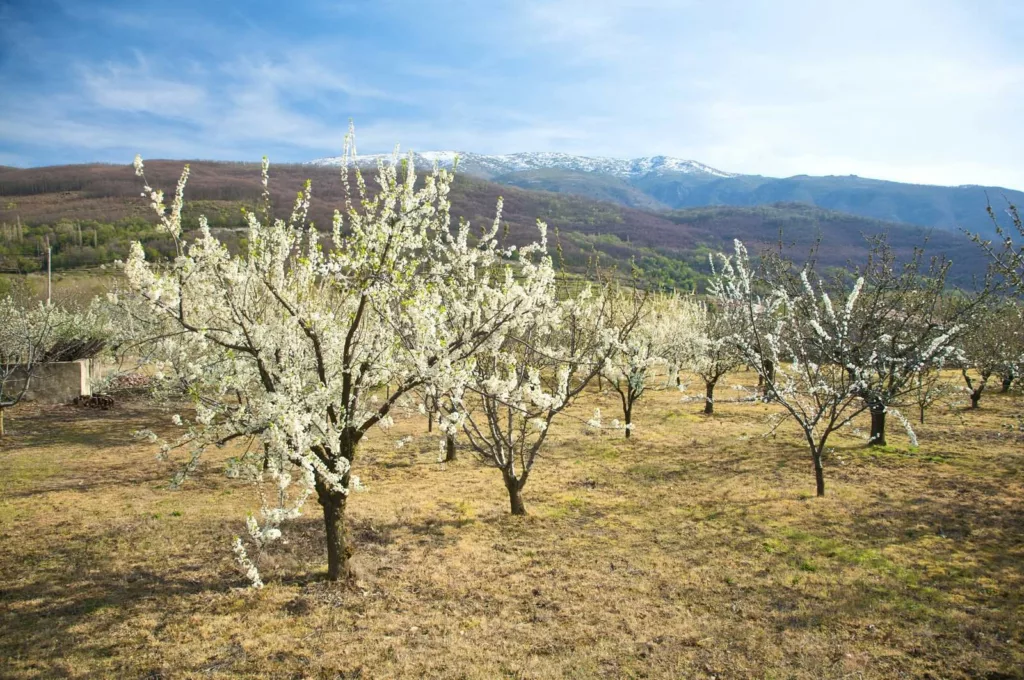
You may be surprised to know that Spain produces about 16% of the world’s almonds. You may also be surprised to know that almond trees produce a beautiful flower, so beautiful in fact that Van Gogh has a painting dedicated to their beauty. Especially in the region of Andalusia, almond blossom viewing is an annual event.
Blossoming generally begins at the beginning of February, but depending on the weather and temperatures, some areas can blossom sooner or later than others. One of the best ways to see the blossoms is by taking a nature tour from Marbella to show you through the Andalusian countryside, which will be dotted with almond orchards blooming in the February sun.
2. Visiting Art Museums
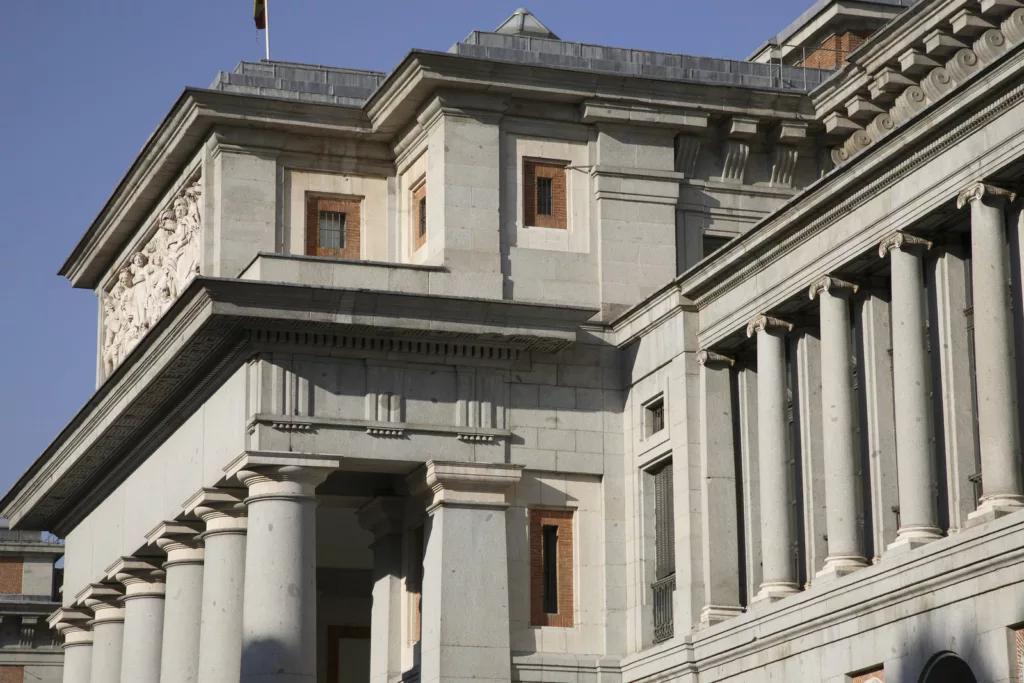
Spanish art museums, like Madrid’s Prado Museum , are world-renowned and can be extremely crowded during the busy summer period, making February a great time to plan a visit. It can also be a great way to make the most of a rainy day, given that much of Spain’s annual rainfall happens during the winter months.
Given the sheer size of the collections in these museums, it can be hard to know what not to miss since there is realistically almost no way to see it all. Even general tours are often crowded and not specific to what interests you, so booking a private tour of The Prado Museum can ensure you see exactly what you want to see and can actually hear the tour guide.
3. Enjoying Traditional Tapas

Of course, no Spanish holiday would be complete without tapas; luckily, summer or winter, rain or shine, tapas are always on the menu. One of the many food facts about Spain is that tapas are meant to be enjoyed as an accompaniment to drinks and should be shared amongst the group. This means a tapas crawl can be a fun way to try popular drinks like vermouth or tinto de verano while eating all your favorite tapas.
4. Skiing in the Sierra Nevada
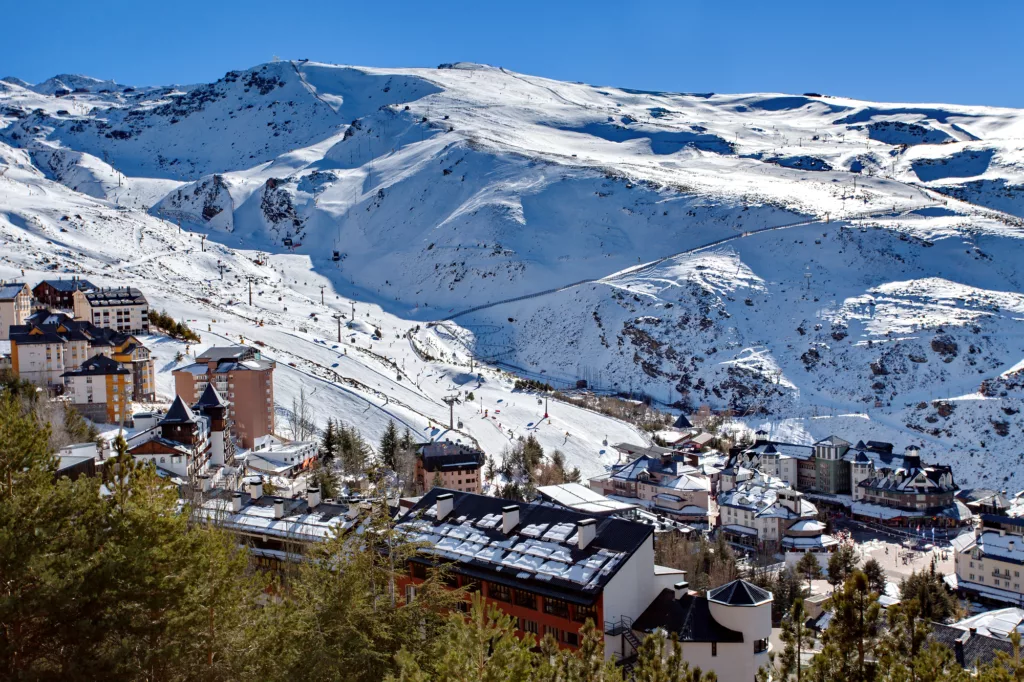
Having only skied a couple of times myself, the stunning Sierra Nevada mountains would be a fantastic place to give it another go. Never fancied myself much of a winter-weather-sport type of person. Ski holidays in northern Europe never appealed to me, but a ski holiday to the south of Spain? Sign me up.
If you are wondering ‘ Does it snow in Spain ’?, you wouldn’t be alone, and you might be delighted to know that the Sierra Nevadas receive an ample amount of snowfall in the early months of the year, making it an ideal place to try skiing for the first time or to enjoy a sport you are a pro at.
While Grenada is certainly not one of the coldest cities in Spain , the elevation of the nearby mountains makes it a haven for some of Europe’s best ski resorts. For my first ski trip, I’d want to mark the event with a more luxurious stay at El Lodge , which gives skiers Alpine vibes with the flavor of Spanish luxury.
Spain in February: Festivals and Events
February is arguably one of the most exciting months in the Spanish cultural calendar. With too many festivals to count, we can be sure that the Spanish know how to throw a good party. Taking care to line up your February trip with a local festival can ensure you don’t miss any of the exciting festivities.
1. Carnival Celebrations

Carnival is a vivacious festival celebrated all around the world. For most of the world, Carnival is the celebration of the beginning of the season of Lent, a traditionally Catholic event in which some level of fasting is carried out until the final day of the season, Easter.
These celebrations leading up to Lent have traditionally been a time when Catholics would indulge themselves in all that was about to be fasted for the Lent season, which in turn evolved into the big, elaborate festivals we know today. Because of its long history, it can also be one of the best places to find amazing food and traditional clothing in Spain .
Several Spanish cities, including Tenerife and Cadiz, are known to have especially exciting carnival celebrations. While you may know of the many reasons Tenerife is worth visiting , you may not be so familiar with Cadiz. In fact, Cadiz has one of the best-known carnival celebrations in Spain.
2. Almond Blossom Festival, Mallorca

The Almond Blossom Festival of Mallorca, locally known as the Fira de la Flor d’Ametler, is one of the best things to do in Mallorca for winter visitors to the island. With over 5 million almond trees on the island, Mallorca turns into a sea of delicate pink and white blossoms from late January through February.
Some of the best places to see the blossoms are in some of the more rural areas of the island, but if you’re wondering where to stay in Mallorca , we’d recommend the 18th-century town of Son Servera to have access to the festival’s markets where you can try all of the local food and participate in the traditions.
3. Jerez Flamenco Festival
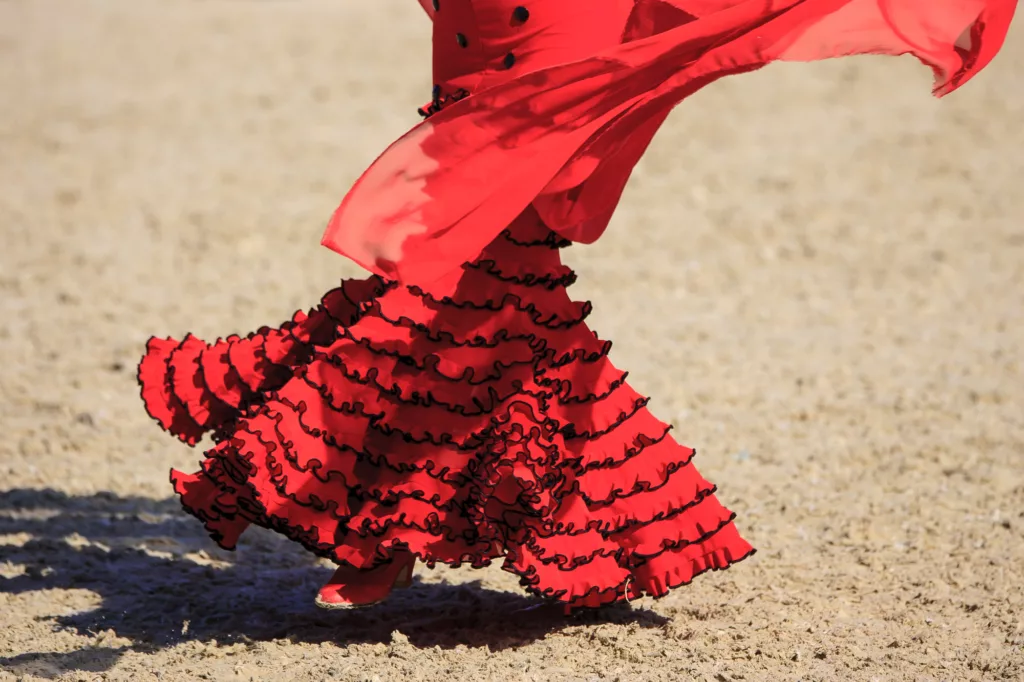
Flamenco lovers flock to the south of Spain in late February to experience the flamenco event of the year. Jerez in Cadiz is said to be the home of flamenco, and February sees the best flamenco artists from around the world descend on Spain.
With performances celebrating the history of flamenco, the festival is the perfect place to experience traditional Spanish dances , traditional Spanish music, and, of course, traditional Spanish food. You can even take part in the fun yourself with classes and workshops, but you’ll have to be quick as tickets are bought up fast.
Spain in February: Costs and Planning
One of the most alluring aspects of traveling to summer destinations like Spain in the winter is the cost savings. Summer premiums can make prices during Spain’s off-peak season look like an absolute bargain–because they are! Traveling to Spain in February is a fantastic way to experience all that Spain has to offer (except for the summer heat) without the hefty price tag.
Like with any trip, however, budgeting can still be very important and a great tool to make sure you leave with more than just memories. The biggest costs, like accommodation and flights, make this fairly easy as they are generally prepaid ahead of time, so you don’t necessarily have to worry about overspending in those categories on your trip. A bit of time spent researching ahead of time can also help you ensure you save as much money in those categories as possible.
If you are renting a car, again, you will likely pay for the majority of this ahead of time, but be sure to account for gas that might be needed along the way. While you could use taxis, using Uber in Spain is great for budgeting as it gives you the option to see prices and lock them in with scheduled rides before ever committing to the ride. This way, you can decide where you want to go and know about how much a trip like that might cost before you even arrive in Spain.
As for budgeting activities, I try to plan as many activities as I can in advance, making sure to book anything I can ahead of time as well. I will even have a look at potential restaurant choices ahead of time and get an idea of the prices so I can budget per meal. Even if you never eat at these restaurants or attend any non-prebooked activities, they still can be useful in giving you an idea of how much what you want to do might cost, as this will vary depending on the interests of the person.
Spain in February: Tips and Precautions

While Spain in February can be enjoyable as it is much less crowded, it is still worth being vigilant. Pickpocketing and street scams are very popular in Europe, and when there are fewer people to victimize, you might find yourself more of a target.
Luckily, it is also easier to be vigilant due to the lack of crowds where petty crimes like this thrive. Knowing how to protect your belongings, what to look out for, and what to do if you are a victim can help you feel prepared.
Conclusion: Spain in February
In short, February can be a serene yet vibrant time to explore Spain. Understanding that it will be different than a summer holiday, embracing Spain’s winter charm can make for a wonderful trip all the same. You will probably find you have much more of a truly Spanish experience. And once you do embark on your Spanish winter holiday, we’d be delighted for you to share your stories with us!
Search the site
Popular destinations.

Barcelona is a fantastic holiday destination! This city has a special place in our hearts. See more

Madrid, the heart of Spain, is a city where every corner buzzes with life and history. See more
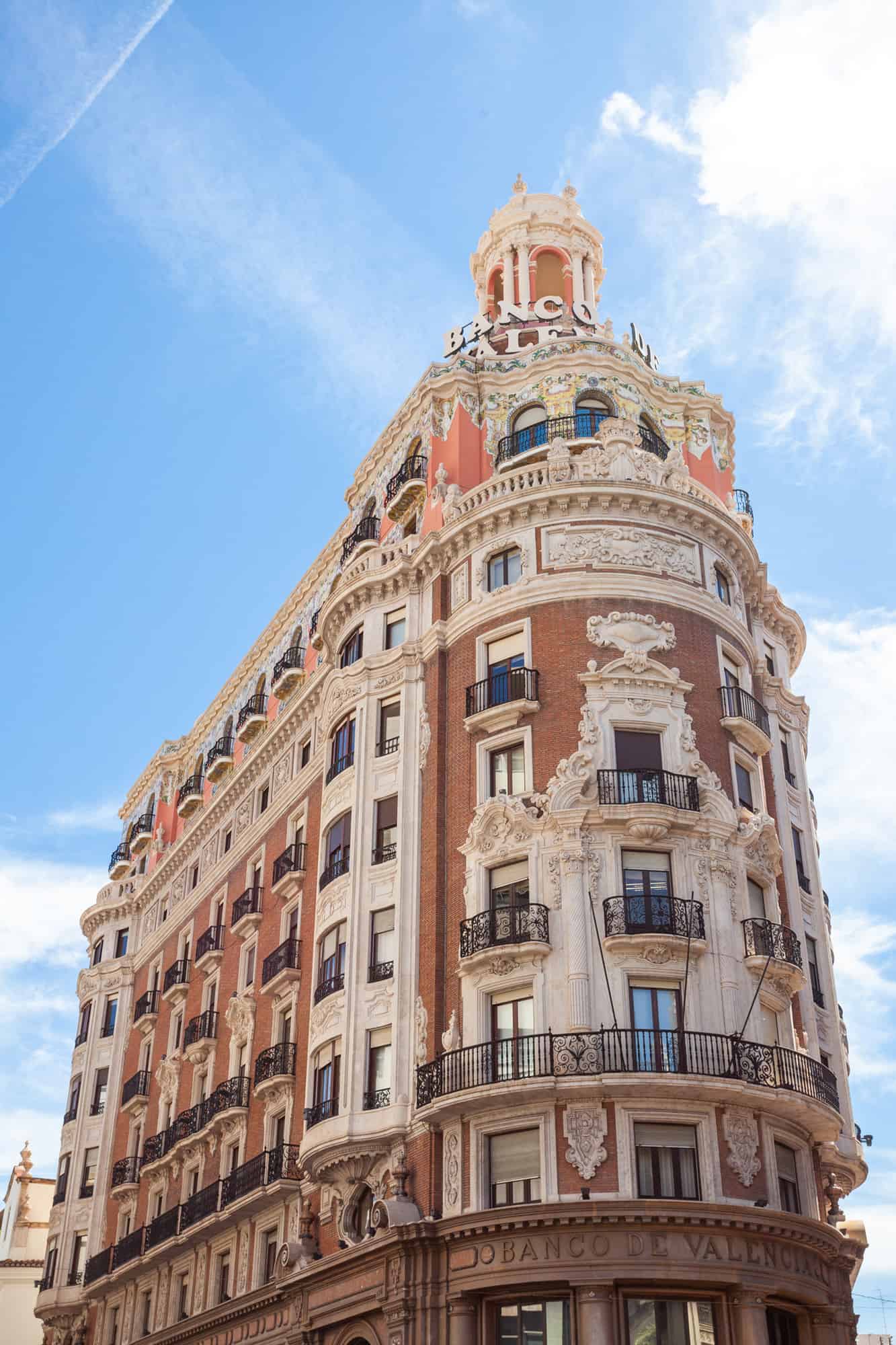
Valencia is a popular tourist destination with fantastic accommodation options. See more
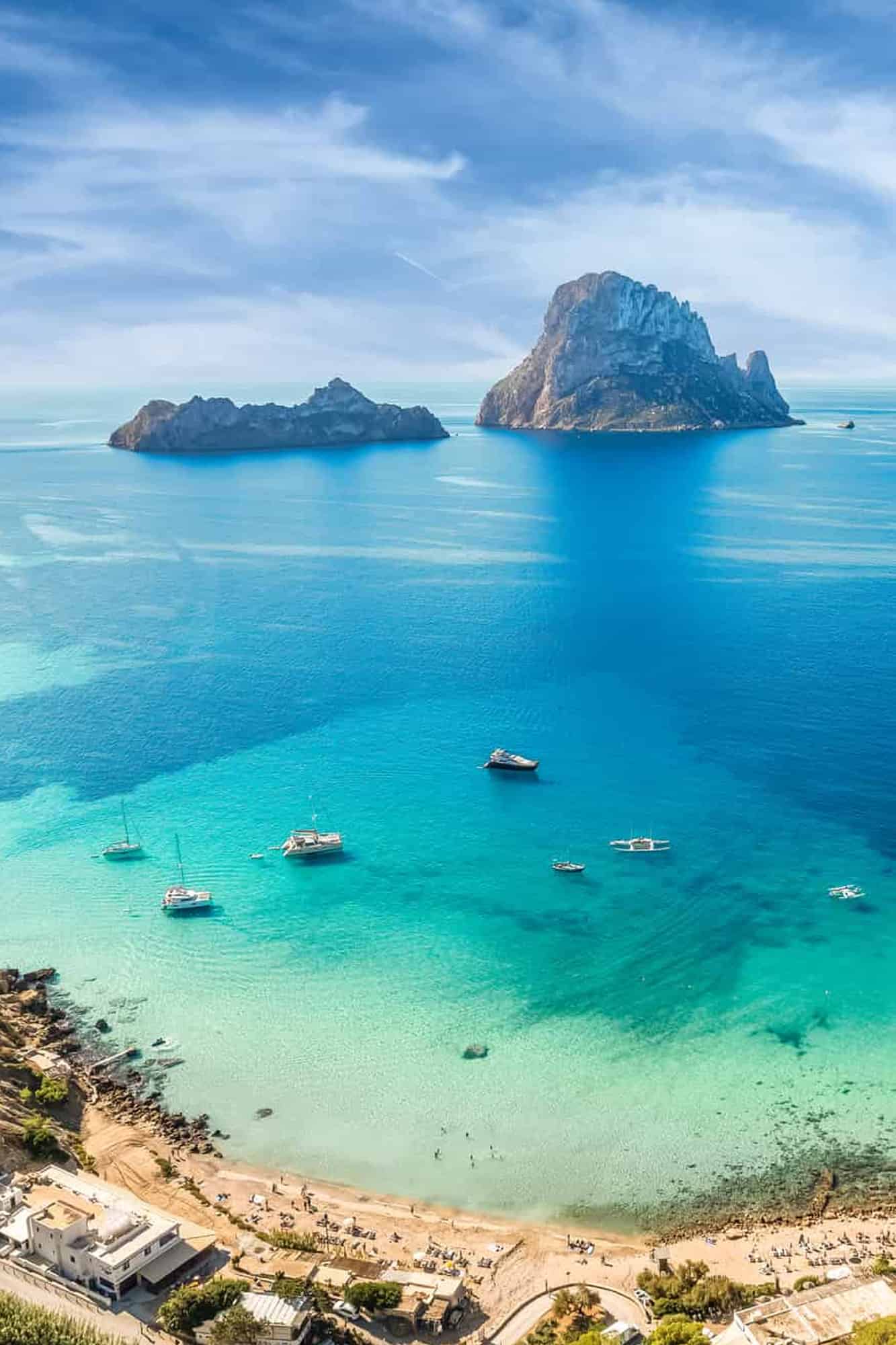
Mallorca is one of the Balearic Islands, a holiday paradise with Europe’s finest beaches. See more
Just letting you know When you buy something through our links, we’ll earn a small commission—don’t worry, it won’t cost you any extra! It’s a win-win, right?
Discover Hotels With Booking.com
Book Exciting Tours With Viator.com
Rent a Car With Discovercars.com
Flights with Cashback With WayAway.io
Exclusive Heymondo Travel Insurance Offer
Planning a trip? Make sure you’re covered! We’ve teamed up with Heymondo to give our readers a special deal: 5% off travel insurance . Grab this deal and know you’re looked after on your next trip.
Related Posts
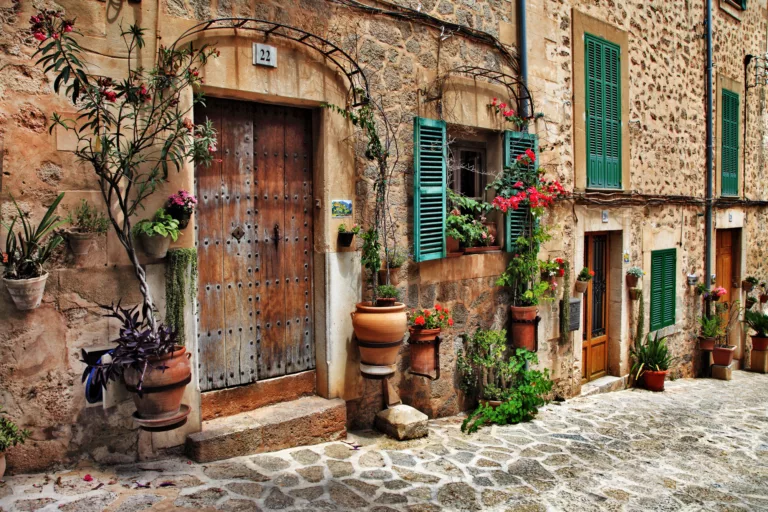
19 Hidden Villages in the Spanish Countryside
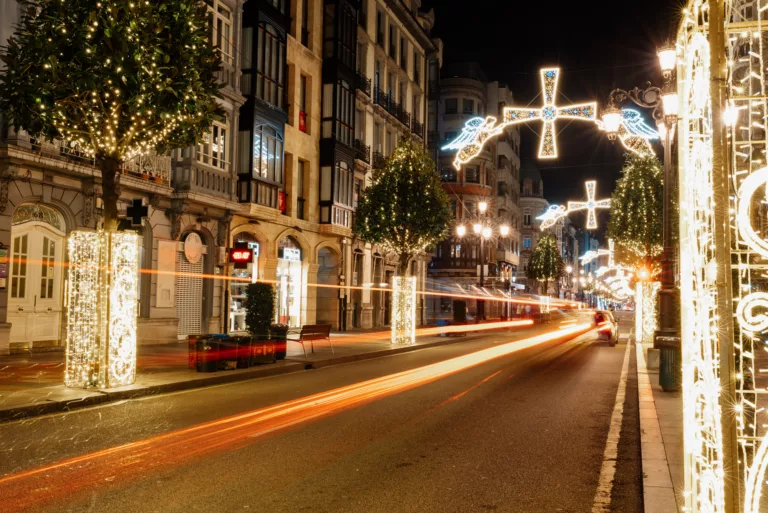
Spain in December: More Than Just Christmas Lights

Grocery Stores in Spain

Spain in February: Weather & Things to Do in Spain
It’s the month of love, and you’ve planned a romantic getaway for you and your partner and have an idea of the best cities to visit , but you’re wondering what the weather is like in Spain in February.
In February, most of Europe is still deep in winter. Because Spain has regions like the Mediterranean coast, you get to experience the best of both worlds, whether skiing in the snow or sun tanning at the beach. The month of love in Spain has romance and relaxation to offer.
Before you pack your bags, let’s take a closer look at the weather in Spain in February and the best places to visit.
Weather in Spain in February
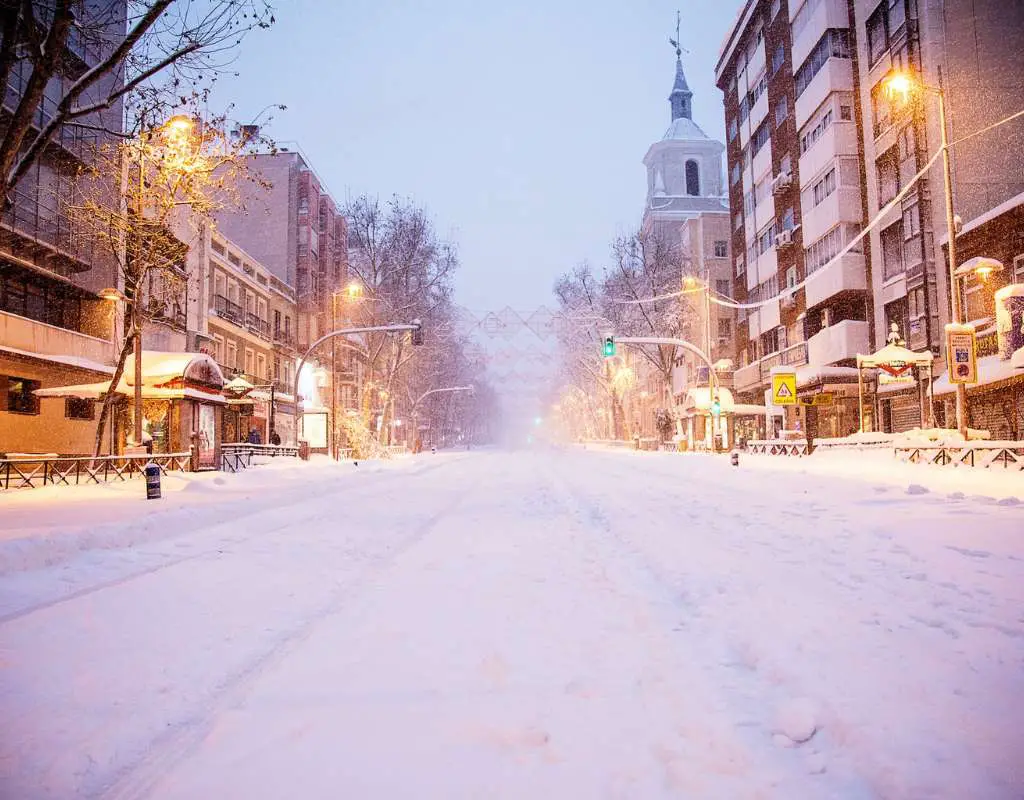
Spain’s weather in February is chilly. However, the temperature can vary depending on where you are in the country. Overall, the temperature in Spain in February can range between 4℃ to 18℃.
Although the country is cold, Spain’s temperature in February does not reach sub-zero temperatures like other European places. Winters in the capital city, Madrid, are usually dry and snow is rare, but mornings and nights can be utterly freezing.
If you’re looking for sunshine in the winter, fear not, as coastal Barcelona in February has sunny winters and isn’t as bitterly cold as, say, Madrid in February , for example. Cities like Malaga and Seville also have higher average temperatures but not enough to allow you to sunbathe.
So, when packing for your trip, you only need to pack heavy, thick clothing if you spend most of your journey in a ski resort. Pack warm but casual like your sweatshirts, long-sleeve tops, stylish jackets or hoodies, bottoms, or scarves.
Things to Do in Spain in February
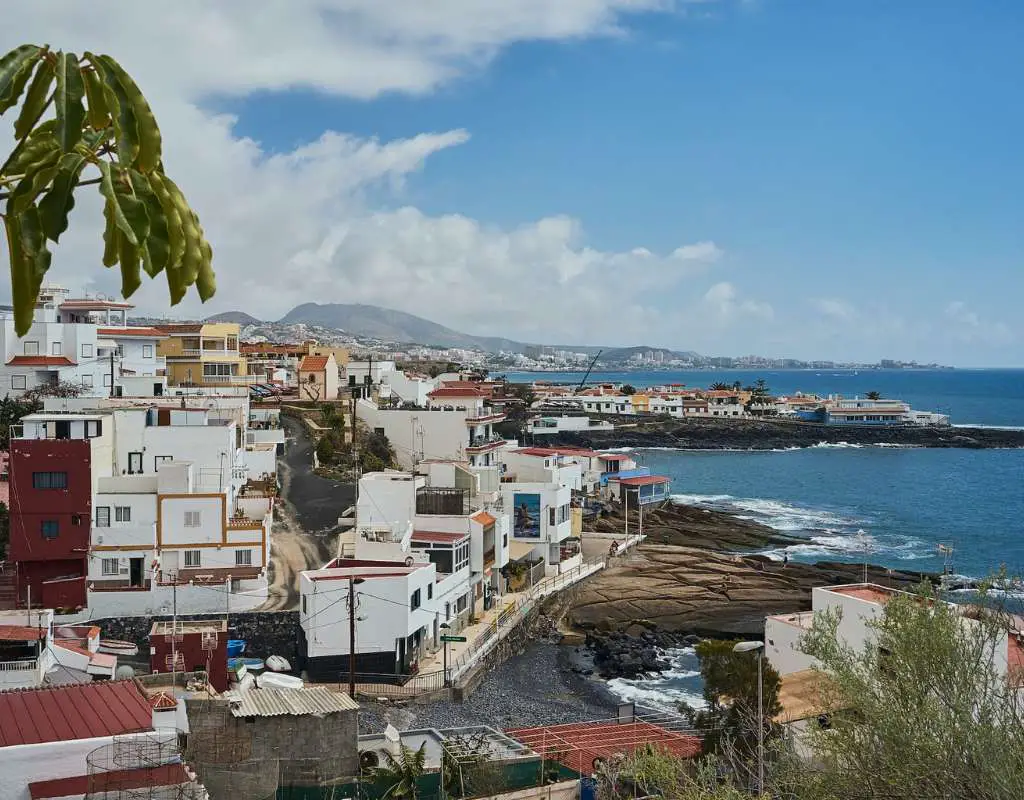
Here are five of the best places to visit in Spain in February.
1. Visit the Barcelona Aquarium
If you love life under the sea, head to the Barcelona Aquarium . This aquarium in Moll d’Espanya del Port Veli costs 21€ (22.40$) per adult. There are 450 sea species of Mediterranean sea creatures in more than 35 exhibits. Watch and learn more about tropical sea life and also have the opportunity to attend various interactive programs.
2. Explore the Sagrada Familia
When visiting Spain in February, one of the best things to do is to visit the iconic Sagrada Familia . This is the world’s largest unfinished church, and it’s one of the most striking and sensational works of neo-Gothic architecture with ornate structures and double aisles. You can enjoy the less crowded Sagrada in February by exploring the museum and Nativity steeples.
3. See the Canary Islands
Just because it’s winter doesn’t mean you cannot picture yourself walking on the sandy shores of white beaches under the clear sky. Winters in Spain can be sunny, allowing the cool breeze to caress your skin and soothe your mind. If there’s one place that cannot be left out of your itinerary, it’s the white beaches of the Canary Islands.
4. Tour the Alhambra
The Alhambra complex is 600 years old. When visiting this historic site, learn about its rich history and admire the splendid architecture. When you experience this moment, take in the tower’s breathtaking views of Granada and the surrounding mountains. You also have the opportunity to stroll through the beautiful Generalife Gardens and treasure the history of the Spanish-Muslim architecture of the Alcazaba Fortress and Nasrid Palace.
5. Get a thermal spa retreat
When in Spain in February, take the opportunity to pamper yourself into relaxation and spoils. Spain’s thermal spas are perfect for winter cold weather. You can visit the famous hot springs of La Garriga near Barcelona, or if you love luxury, visit Hammam al Amdalus spa in Andalucia and be prepared to be pampered.
Festivals and Events in Spain in February

Festival de Jerez
The Festival de Jerez is a flamenco and Spanish dance festival held over two weeks from mid-February. During this festival, every street corner and plaza echoes the sound of guitars and people singing. Then there’s a spontaneous parade of flamenco and the town erupts with a unique atmosphere. Enjoy the streets and take your partner dancing.
Andalucia Day
Andalusia Day is a public holiday in the region. It commemorates the referendum in which Andalucian citizens approved the Statute of Autonomy of Andalucia that took place on 28 February 1980. It is celebrated with music concerts, parades, and cultural and sports activities.
FAQs About Spain in February
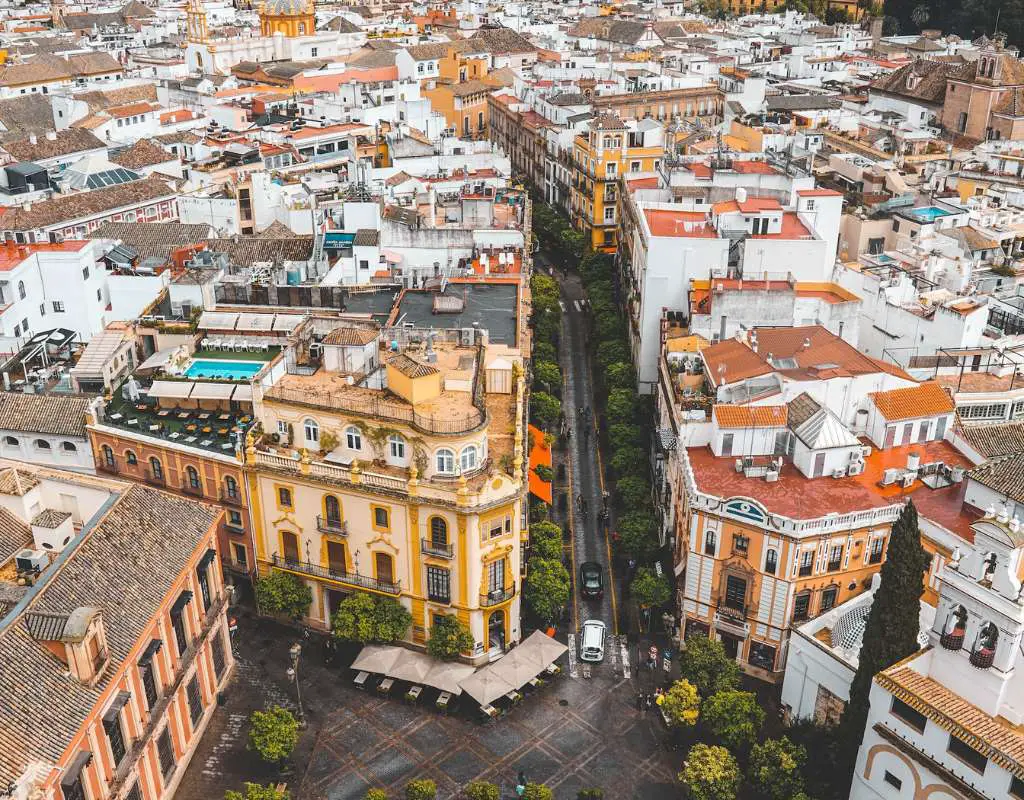
Is it Worth Visiting Spain in Winter?
It is worth it. Winters in Spain are mild compared to the rest of Europe. There are fewer crowds, and numerous unique festivals that you can enjoy. And even though it’s winter, you can still be sunkissed on the beach and have a ski day. There is so much to do in winter in Spain.
Is February a Good Time to Visit Spain?
Yes, February is an excellent month to visit Spain because the weather is cool, and tourist attractions have fewer crowds as it is off-season in Spain. The advantage here is that tickets are cheaper and you’re hassle-free to tour attractions.
What is the Warmest Part of Spain During Winter?
Spain’s temperature varies during winter. However, the southern region of Spain is most likely the warmest. Andalusia has the warmest temperatures in winter. Barcelona is also another warm area during winter; if you’re feeling island vibes, the Canaries are the warmest.
What Can I Eat in Spain in February?
Winter has seasonal delicacies, including plenty of seafood, comforting roasts, and winter veggies. Try something meaty like gammon, shellfish, and polvoron. There are so many mouth-watering Spanish meals for you to try out.
Final Thoughts on Spain in February
In closing, Spain in February is chilly however, regardless of the weather, there are so many activities you can enjoy. Thankfully, certain parts of Spain experience sunny winters, so you can still go skiing in the chilly morning and then end your day getting a sun tan on the beach.

Spain in July: Weather, Activities, & More

Spain in December: Weather & Things to Do
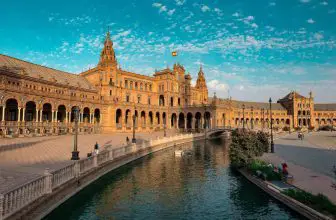
Spain in March: Activities, Climate, and More
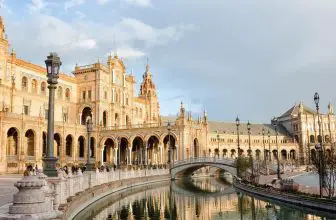
Spain in April | Weather, Festivals & Things to Do When Visiting
Leave a reply cancel reply.
Save my name, email, and website in this browser for the next time I comment.
- 8 Luxury Hotels in Gran Canaria | Boutiques, 5-star, & Resorts
- Málaga To Ronda Day Trip | Is It Better By Train, Plane, or Car?
Traveling in Spain aims to help tourists and locals find the best adventures, and tours in Spain. We collect live prices from trusted tour and ticketing operators. We’ll sometimes link out to our affiliate partners, such as Amazon LLC, and make a small commission at no extra cost to you.
Privacy Overview

Shopping cart

Weather in Spain in February (2025): The Ultimate Guide
The weather in Spain in February gives a full buffet of options. This means that visiting here this month isn’t just about avoiding the cold – it’s about discovering a country that’s slowly waking up to spring.
You’ll find a mix of chilly mornings and unexpectedly warm afternoons, which probably leaves you to wonder just where you should go in Spain based on your ideal weather!
As someone who lives in Spain, I’ve learned to embrace its February weather. Whether you’re keen to explore the historic alleys of Granada or catch some early sun in the Canary Islands, I’ve got some tips and tricks on how to pack and what to expect more generally.
Table of Contents
Weather in Spain in February
Spain’s weather in February is characterized by variability across the country, blending cool and mild temperatures with a chance of rain. Depending on the region, you can experience everything from sunny beach days to chilly urban explorations.
Andalusia , including the Costa del Sol and cities like Seville and Granada , experiences relatively mild winters with daytime temperatures around 16°C (61°F) and nighttime temperatures that can drop to 6°C (43°F).
In contrast, the northern regions, including cities such as Bilbao and Santander , have cooler temperatures and higher chances of rain.
The Canary Islands , a popular holiday destination, boast enjoyable weather even in February. You can expect daytime temperatures to hover around 20°C (68°F) in places like Tenerife and Gran Canaria .
The south of Tenerife , including areas like Santa Cruz de Tenerife , is particularly pleasant and has its famous Carnival during this month, adding festive spirit to the warm climate.
Valencia and the Mediterranean coast generally have mild winters, with average temperatures in February ranging from 11°C (52°F) to 17°C (63°F). Precipitation in coastal areas averages around 20 ml (0.79 inches), while the southern region tends to be drier.
Although predominantly sunny, Spain’s weather in February can be unpredictable, sometimes bringing sudden showers or, in higher altitudes, snow. You won’t typically encounter beach weather, but it’s comfortable for exploring cities and attending diverse festivals.
Not sure exactly when you’re coming to Spain? If you might be coming slightly earlier, take a look at what the weather is like in Spain in January .
Maybe planning to visit a bit later? Check out the weather in March in Spain to see what you can expect.
How Hot Is Spain in February?
In February, Spain doesn’t typically experience “hot” conditions. Average temperatures range from 5°C (41°F) in the north to about 18°C (64°F) in the southern regions. Coastal areas are milder than the inland areas, with average highs in cities like Málaga reaching up to 17°C (63°F).
For example, some of the temperatures you can expect are:
- Madrid: Expect average highs around 12°C (53.6°F) and nightly lows near 2°C (35.6°F).
- Barcelona: Daytime temperatures average at about 14°C (57.2°F), with nights around 5°C (41°F).
- Seville: You’ll enjoy warmer days with averages up to 18°C (64.4°F), and cooler nights at 6°C (42.8°F).
Northern parts of Spain tend to be cooler, with cities like Santiago de Compostela averaging daily highs of just 12°C (53.6°F) and lows around 5°C (41°F). On the Mediterranean coast, cities like Alicante boast milder conditions with average highs of 17°C (62.6°F).
Despite these temperatures, you should be aware that February can still be quite cold, especially in the evenings. It’s a smart idea to pack layers, including a warm jacket.
Rain isn’t uncommon either, so an umbrella or waterproof clothing could come in handy, especially in the North where you’re likely to encounter more frequent showers.

Which Part of Spain Is Warmest in February?
In February, the warmest areas of Spain are typically the Canary Islands, followed by the southern coast of mainland Spain. You’ll find the Canaries enjoy mild temperatures, generally warmer than the rest of Spain. The southern region of Andalusia also tends to have pleasant weather during this time.
In the case of the Canary Islands , this archipelago off the coast of Africa has a subtropical climate, meaning you can expect the warmest weather in Spain during February here. Tenerife, Gran Canaria, and Lanzarote are particularly noted for their warmer climates.
Similarly, coastal cities in Andalusia like Málaga and Almería are known for their relatively warm winters. You’ll see temperatures around 17°C (63°F) in Malaga, while in Almeria, they’re often a tad higher.

What’s your perfect destination for your dream trip to Spain?
Want to discover a city or live your island dreams?
Embrace the food scene or step through the pages of history?
Whatever your travel style, discover the perfect Spanish city to add to your trip here!
It’s worth noting that while the Canaries have low rainfall in February, mainland Spain, particularly the southern coast, will have more variability. The Canaries receive about 30ml (1.18in) of rain, whereas the Costa del Sol in Andalusia can expect about 54ml (2.13in).
Keep in mind that while the days are warmer, nights in Southern Spain can still be quite cool. You’ll need to pack a mix of light daywear and warmer clothing for the evenings, ensuring you’re comfortable no matter the time of day.
Which Part of Spain Is Coldest in February?
The coldest part of Spain in February is typically the mountainous regions, such as the Pyrenees and the Sierra Nevada. In these areas, you’ll experience the lowest temperatures during this winter month. You can expect snowfall and often freezing conditions, especially at higher altitudes.
In the Pyrenees, temperatures can drop to an average low of -2°C (28°F), with certain areas getting colder as altitude increases. The Sierra Nevada mountain range, particularly around the Mulhacén peak, which is the highest point on the Spanish mainland, also sees very low temperatures.
Here, it’s not uncommon to find average lows around -10°C (14°F), with the possibility of it getting even colder.
Besides the mountains, the northern interior of Spain can get quite cold too. Regions such as Castilla y León have continental climates that lead to cold winters. Here, you’ll find cities like Burgos where average temperatures in February hover around 0°C (32°F) for lows and 8°C (46°F) for highs.
Remember to pack your warm clothes if you’re visiting these chilly areas in February. Since you’re dealing with mountain climates, it’s vital to be prepared for rapid changes in weather, including heavy snowfall and strong winds.
It’s also worth checking out local weather forecasts for specific regions, as conditions can vary from year to year.

Weather in Different Regions of Spain in February
Weather in southern spain in february.
In February, you’ll find Southern Spain experiencing mild winters, especially when compared to other regions of Europe. Cities like Seville and Granada offer pleasant days and cooler nights. You can expect an average of 7 hours of sunshine per day along the Costa del Sol.
- Temperature: The maximum temperature usually sits around 18°C (64°F), with minimums around 6°C (43°F).
- Average days of rainfall: Expect around 7 days of rain this month.
- Average amount of rainfall: The average is about 60 ml (2.36 inches).
- Sea temperature: The sea temperature averages at about 16°C (60°F).
Weather in Northern Spain in February
In February, Northern Spain experiences a mild but variable climate. You’ll find that cities like Bilbao and Santander can be quite rainy during this month. Snow isn’t uncommon in the mountainous regions, while the coast sees milder temperatures.
- Temperature: Maximum temperatures average at 11°C (52°F), with minimums dropping to 3°C (37°F).
- Average days of rainfall: Northern Spain has roughly 14 rainy days in February.
- Average amount of rainfall: The rainfall amount can average 100 ml (3.94 inches).
- Sea temperature: The average sea temperature is about 14°C (57°F).
Mountainous areas away from the coast are where you’re more likely to encounter snow. With Northern Spain’s oceanic climate, temperatures are generally cool and the weather can be quite damp.

Weather in Barcelona in February
Barcelona enjoys a typical Mediterranean climate with mild winters, making February a cool but pleasant month. You can expect average temperatures to hover around 8-15°C (46-59°F) during this time. Although it’s not beach weather, it’s often comfortable for sightseeing and exploring the city.
- Temperature: Maximum daytime temperatures hover around 14°C (57°F), while nights can cool down to 8°C (46°F).
- Average days of rainfall: There are usually around 5 days of rain.
- Average amount of rainfall: Rain averages around 25 ml (0.98 inches).
- Sea temperature: Sea temperatures average at 13°C (55°F).
Remember, the weather can be quite variable, so it’s wise to check the forecast ahead of your trip and be prepared for a mix of sunny, overcast, and rainy days. Despite the chill, you’ll find that Barcelona maintains its lively vibe with plenty of indoor and outdoor activities tailored to the cooler weather.
Weather in the Canary Islands in February
The Canary Islands offer mild temperatures and a generous amount of sunshine in February. You’ll find that it’s a pleasant time to visit if you’re seeking a break from colder climates. The archipelago’s location off the coast of Western Africa ensures a subtropical climate that can provide a warm escape during the winter months.
- Temperature: Daytime highs average 21°C (70°F), while the lows are typically around 15°C (59°F).
- Average days of rainfall: Rainfall occurs on about 3 days.
- Average amount of rainfall: The average rainfall is around 18 ml (0.71 inches).
- Sea temperature: The sea is warmer here, averaging 19°C (66°F).
Tenerife’s southern resorts are usually drier and warmer than the more verdant north. Days are often sunny, boasting up to 7 hours of sunlight, allowing ample time for your holiday activities.
Sun protection is still advised, as UV levels can be moderate to high. A light jacket or sweater may be useful for evenings when it gets cooler, especially if you’re by the sea where it can be breezy.

Weather in Mallorca in February
Mallorca sees mild winters, and February is no exception. You’ll typically find daytime temperatures hovering around 14°C (57°F), though nights can be cooler. You’ll want a jacket, as the island can feel quite fresh, especially when the sun sets.
- Temperature: Expect maximum temperatures of about 15°C (59°F) and minimum temperatures around 8°C (46°F).
- Average days of rainfall: February sees around 7 days with some rainfall.
- Average amount of rainfall: The average monthly rainfall is approximately 37 ml (1.46 inches).
- Sea temperature: The sea temperature is around 14°C (57°F).
Weather in Ibiza in February
February in Ibiza brings cooler temperatures, with averages ranging from 8°C (46°F) at night to 15°C (59°F) during the day. You’re unlikely to experience extreme cold, but you should pack a jacket for the evenings. Rainfall is moderate, so consider bringing an umbrella.
- Temperature: Ibiza sees daytime highs around 15°C (59°F) with nighttime lows near 8°C (46°F).
- Average days of rainfall: Expect about 5 days of rain during this month.
- Average amount of rainfall: The rainfall totals to about 38 ml (1.5 inches).
- Sea temperature: The sea is relatively mild at 15°C (59°F).
The island of Ibiza has a Mediterranean climate, which means winters are relatively mild compared to other European destinations. Despite this, it’s the off-season, and many beach resorts and outdoor activities may have limited hours or be closed.
Nevertheless, it’s a great time for coastal walks and enjoying the quieter side of Ibiza without the summer crowds.

Weather in Madrid in February
In February, Madrid experiences cold winter weather with moderate rainfall. You can expect average daytime temperatures to range between 10°C (50°F) and 15°C (59°F). Nighttime brings cooler temperatures, often dropping to around 2°C (35.6°F) to 5°C (41°F).
- Temperature: Madrid has average maximum temperatures of about 12°C (53°F) and minimums down to 2°C (35°F).
- Average days of rainfall: Rain fallson average for 5 days during the month.
- Average amount of rainfall: The rainfall is about 35 ml (1.38 inches).
The city’s lows at night underscore the need for a good coat, gloves, and a hat, especially if you plan to explore Madrid’s vibrant nightlife or enjoy an evening stroll.
Weather in Tenerife in February
You can expect mild temperatures in Tenerife during February, with the south being generally warmer. Santa Cruz de Tenerife, the capital, holds a vibrant carnival this month. The climate remains moderate compared to the rest of Spain, providing a pleasant winter escape.
- Temperature: Daytime highs often reach 20°C (68°F), and the lows don’t typically fall below 16°C (61°F).
- Average days of rainfall: There are roughly 4 days of rainfall.
- Average amount of rainfall: Rainfall can average 27 ml (1.06 inches).
- Sea temperature: The average sea temperature is about 19°C (66°F).
Weather in Costa Del Sol in February
In February, the Costa Del Sol offers mild weather conditions. You’ll find the temperatures relatively comfortable, averaging 13°C (55°F). There’s a chance for occasional showers, with average rainfall around 60 ml (2.36 inches).
The region sees about six to seven hours of daily sunshine, making outdoor activities possible. Nights can be cooler, so you’ll need a jacket when you go out.
- Temperature: Expect highs around 17°C (63°F) and lows at approximately 8°C (46°F).
- Average days of rainfall: Generally, there will be around 7 rainy days.
- Average amount of rainfall: Average rainfall is near 60 ml (2.36 inches).
- Sea temperature: The sea temperature averages 16°C (61°F).

Weather in Valencia in February
In February, Valencia experiences mild winter weather, characteristic of its Mediterranean coast location. You’ll find daytime temperatures averaging 17°C (62°F), while nights can cool down to about 7°C (45°F). Rain isn’t very frequent, but you can expect around 37 ml (1.46 inches) throughout the month.
- Temperature: The temperature during the day can reach 17°C (62°F), while at night it may drop to 7°C (45°F).
- Average days of rainfall: Valencia has about 4 days of rain in February.
- Average amount of rainfall: The region sees about 37 ml (1.46 inches) of rain.
- Sea temperature: The sea temperature holds steady at around 14°C (57°F).
Is February a Good Time to Visit Spain?
February can be a great time to visit Spain if you’re looking for cooler temperatures and smaller crowds. While it’s off-peak season for tourism, you’ll find more affordable travel and accommodation prices. Some regions offer pleasant weather, while others might be quite chilly, making it ideal for different types of holidays.
As mentioned above, February in Spain presents a variety of climates. In the south, such as Andalucia, Costa del Sol, and the islands of Gran Canaria and Tenerife, temperatures are mild, averaging around 16°C (61°F) during the day.
The Mediterranean regions experience similar mild temperatures, making it pleasant for sightseeing. However, if you’re visiting the north of Spain or Madrid, prepare for cooler weather with averages around 10°C (50°F) and the possibility of rain.
If you love winter sports, the Sierra Nevada and the Pyrenees mountains are ideal for skiing in February. Conditions in these areas are usually perfect for winter sports, with the ski season in full swing.
One of the big advantages of February travel in Spain is that it’s way less crowded than other times of the year in tourist hotspots. This also often means that you’ll get better deals on flights and hotels.
Visiting Spain in February is well-suited if you’re looking for a quieter holiday, interested in winter sports, or eager to experience Spanish cultural events firsthand.
Which Part of Spain Is Best to Visit in February
You’ll find southern regions like Andalusia are best for mild temperatures and sunshine in February. Cities like Seville, Granada, and Malaga can provide a comfortable winter escape. The Canary Islands are especially inviting at this time, offering a spring-like climate.
Gran Canaria and Tenerife are known for their pleasant climates. Average temperatures lie around 18°C (64°F), which makes them great for exploring the outdoors or simply relaxing on the beach.
Both islands receive minimal rainfall in February, typically less than 25 ml (1 inch), ensuring most days are sunny and dry.

The Costa del Sol lives up to its name, boasting ample sunshine even in the heart of winter. The temperature here averages around 13°C (55°F), with little rainfall, generally under 60 ml (2.36 inches). It’s an ideal time for golfers and outdoor enthusiasts to visit.
Andalusia is fantastic for visitors with its rich cultural history and mild weather. Seville, its capital, sees average temperatures around 16°C (61°F), allowing you to comfortably meander through its historic streets and marvel at the architecture without the oppressive heat that comes later in the year.
Moving north to the Mediterranean coast, the weather is cooler and more unpredictable, but the drop in tourist numbers might make this a tempting option. You’re likely to experience a mix of sunny and overcast days, with average temperatures ranging from 10°C to 15°C (50°F to 59°F), which can be quite enjoyable for those who prefer less intense warmth.
Is It Hot in Spain in February?
Spain isn’t typically hot in February as, in winter, the temperatures are moderate to cool in most parts of the country, with some areas experiencing heavy snow. However, in the southern regions and the Canary Islands, you might enjoy more temperate weather that’s suitable for outdoor activities.
Here are the average temperatures you can expect in different regions:
- Northern Spain: You can expect average highs of around 10°C (50°F) and lows of 3°C (37°F).
- Central Spain: In central areas, including Madrid, average highs are approximately 12°C (53.6°F), while lows can dip to 2°C (35.6°F).
- Southern Spain: This region tends to be warmer, with average highs of 17°C (62.6°F) and lows of 8°C (46.4°F).
- Mediterranean Coast: Here, temperatures average between 14-18°C (57.2-64.4°F) for highs and 6-12°C (42.8-53.6°F) for lows.
Since February is still in the winter season, it’s wise to pack a mix of warm clothing and perhaps a lighter jacket for the afternoons if you’re traveling to the southern or coastal areas. While the south and Mediterranean regions may offer some sunny days, it’s not beach weather, and swimming is generally off the table due to the cooler sea temperatures.

Is It Cold in Spain in February?
In February, you can expect cooler temperatures across Spain, though the climate varies by region. In the north of Spain, you’ll encounter chillier weather compared to the rest of the country. Cities like Madrid experience mild cold, with an occasional sharp drop in temperature evenings.
You should prepare for the possibility of rain and snow, particularly if you plan to visit higher elevations or inland cities, like the following:
- North of Spain: Here, winter is usually more pronounced, so you’ll need your warm clothing. Average temperatures hover around 7°C (44°F) during the day, but can fall near freezing at night.
- Madrid: The capital city sees average highs of 10-12°C (50-53°F) and lows that can drop to 2-3°C (35-37°F). It’s certainly brisk, but generally not too severe, so a good coat and layers should keep you comfortable.
- Sierra Nevada Mountains: Expect colder weather still, due to the high altitude. If you’re into skiing, you’ll be pleased with the conditions – just bundle up tight!
- Pyrenees: Similar to the Sierra Nevada, cold and snowy conditions are normal, perfect for winter sports enthusiasts.
What to Pack When Visiting Spain in February
When you’re planning a trip to Spain in February, it’s important to pack for a variety of weather conditions. You’ll need a mix of layers for varying temperatures, which range from cool to mild. Don’t forget to pack for the possibility of rain, as February can be wet in some regions.
Bascically, layers are your friend in this season. Start with a base of long-sleeve shirts or blouses, adding sweaters or cardigans for warmth.
You’ll appreciate having a versatile, waterproof jacket, as February can bring unexpected showers, averaging around 40 ml (1.57 inches) throughout the month. Packing a lightweight, foldable umbrella or a rain-resistant hat can keep you dry during occasional downpours.
Here’s a basic packing list for the weather in Spain in February:
- Long-sleeve tops: Base layer for warmth and sun protection
- Sweaters/Cardigans: Additional warmth for cooler days and nights
- Waterproof jacket: Protection against rain and wind
- Comfortable pants: Versatility for walking and exploring
- Scarf, Gloves, Hat: Extra warmth, especially in the evening
- Umbrella: For those few rainy days
- Sturdy walking shoes: For exploring cities and possibly uneven terrain
- Sunglasses: Protection from glare on sunny days
- Sunscreen: To protect your skin, the sun can be strong even in February
- Clothing for snow activities : Heading to ski resorts means packing thermal wear, ski gear, and protective sunglasses or goggles.
Remember, Spain’s weather is regional, so tailor your packing list to your itinerary. Whether you’re strolling through Cordoba’s historical streets, lounging on Marbella’s beaches, or hitting the ski slopes in the Pyrenees, being adequately prepared will ensure you enjoy your Spanish travel experience.

Main Events in Spain in February
February in Spain is a time of vibrant festivals and cultural celebrations. You’ll find a blend of traditional and modern events across the country. From the thrilling beats of Carnival to local festivities, there’s something to pique your interest.
- Carnival : Shimmering costumes and lively parades fill the streets. Carnival is Spain’s pre-Lenten festival, brimming with music and dance. The most famous celebrations are in Santa Cruz de Tenerife and Cadiz.
- Dia de Andalucia : On February 28th, Andalusia commemorates its status as an autonomous community. Expect regional flag displays and cultural events.
- Jerez Flamenco Festival : A must-visit for flamenco enthusiasts. Late February sees Jerez de la Frontera hosting top flamenco artists.
- Almond Blossom Festivals : In the Balearic Islands, almond trees bloom, prompting local celebrations of nature’s beauty.
- Fiesta de Santa Agueda : February 5th marks a day where women often take on traditional men’s roles, celebrated in Basque Country with singing and marching.
- Lleida’s Agrarian Fair : An important event for agricultural professionals, it showcases machinery, livestock, and regional products.
- Arco Madrid : A leading international contemporary art fair that attracts artists, collectors, and galleries worldwide.
- Drum Festival : In towns like Mula, drumming events occur around the clock, culminating in the week leading up to Ash Wednesday.
- Snow Festivals : In mountainous regions like the Pyrenees, you can enjoy skiing competitions, snow sculpture contests, and winter sports.
- San Blas Festivals : Celebrating the patron saint of wool workers, these festivals feature local traditions in Benaocaz and Villar del Arzobispo.
- Gastrofestival Madrid : A celebration of Madrid’s culinary scene where you can enjoy tastings, special menus, and gastronomy-themed exhibits.
- International Festival of Fantasy and Horror Films : In Malaga, film fans are treated to screenings of genre films often overlooked by mainstream audiences.
- Mobile World Congress : Barcelona welcomes tech enthusiasts with one of the biggest mobile technology fairs in the world.
These highlights represent just a fraction of what Spain has to offer in February. So whether you’re dancing at a carnival, savoring local flavors, or enjoying the arts, Spain’s array of events this month are sure to create lasting memories.

Where to Go in Spain in February
February in Spain offers a diverse range of climates, from the mild temperatures of the Canary Islands to the cooler weather in the mainland’s interior. You’ll experience a mix of winter and early spring weather depending on where you choose to visit.
Some places you may wish to travel in Spain in February based on the good weather are the following:
- Seville : The Andalusian capital boasts mild winters, making outdoor exploration quite pleasant. You can visit the iconic Plaza de España and the Seville Cathedral with fewer tourists around.
- Granada : Witness the Alhambra palace against a backdrop of snowy Sierra Nevada peaks. Granada’s unique blend of cultures and history is even more accessible in the quieter month of February.
- Valencia : Known for its futuristic City of Arts and Sciences, Valencia also has a large urban park that was once a riverbed. Enjoy the milder temperatures as you stroll through the garden or sample the city’s famous paella.
- Madrid : Spain’s capital offers a range of indoor and outdoor attractions, from the Prado Museum to the bustling El Rastro market. With crisp but not too cold weather, city walking tours are comfortable.
- Barcelona : Gaudí’s architectural wonders, like Sagrada Familia and Park Guell, are less crowded. Plus, the Mediterranean climate keeps the weather milder than in the interior parts of Spain.
- Malaga : As a coastal city in southern Spain, it offers warmer temperatures, perfect for meandering through historic streets or enjoying waterfront dining.
- Cordoba : Explore the Mezquita and the city’s historic center with ease in the off-peak season. The weather remains mild enough for enjoyable sightseeing.
- The Canary Islands : For a beach-oriented holiday with warmer weather, this archipelago is ideal. You can hike, sunbathe, or join in the Carnival celebrations if you visit in late February.
- The Balearic Islands : Although it’s off-season for beachgoers, Mallorca and Ibiza provide tranquil beauty and mild weather for those looking for a peaceful retreat.
- Sierra Nevada : If you’re into winter sports, this is one of Spain’s top spots for skiing and snowboarding, with February being one of the best months for snow conditions.

What to Do in Spain in February
February in Spain offers a unique blend of winter climates with the promise of early spring. You’ll find a variety of indoor and outdoor activities to experience the country’s rich culture and delicious food. Museums, festivals, and even some beach opportunities are available, depending on where you are and the weather.
- Discover the Carnivals : February is carnival season in Spain – from the famous Santa Cruz in Tenerife to Cadiz, these colorful events are marked by parades, music, and dance.
- Hit the Ski Slopes : The Pyrenees and Sierra Nevada offer great skiing conditions in February. Enjoy the snow-capped mountains with fewer tourists than during peak season.
- Visit Museums and Galleries : Take advantage of shorter queues to see famous artworks at the Prado Museum in Madrid or explore the Guggenheim in Bilbao.
- Enjoy Warm-Weather Retreats : The Canary Islands provide a warm escape with average temperatures perfect for beach-going and outdoor pursuits.
- Explore Historic Cities : Stroll through the streets of Seville, Granada, or Toledo and discover the rich history of these cities.
- Take a Wine Tour : Visit La Rioja or Priorat regions and sample Spanish wines right at the vineyards.
- Attend a Football Match : Experience the passion of Spanish football by catching a game, with clubs like FC Barcelona or Real Madrid.
- Celebrate Valentine’s Day : Enjoy a romantic evening at one of Spain’s fine dining restaurants or cozy tapas bars.
- Join Almond Blossom Tours : In regions like Mallorca, the almond trees bloom in February, offering beautiful landscapes.
- Participate in Hiking : With cooler weather, it’s an ideal time to hike the trails of Picos de Europa or the Camino de Santiago.
- Stroll through Botanical Gardens : Places like the Royal Botanical Garden in Madrid are less crowded and maintain their beauty during winter.
- Experience Hot Chocolate and Churros : Warm up with this traditional Spanish comfort food, perfect for chilly February mornings or evenings.
- Attend the Jerez Flamenco Festival : Witness authentic flamenco performances in Jerez de la Frontera, a city renowned for its contribution to the art form.
- Go Bird Watching : February is a great time to visit Doñana National Park or other nature reserves for bird watching activities.
Remember to check local listings and event schedules as dates and availability may change. While some outdoor activities may be weather-dependent, Spain offers plenty of opportunities to enjoy shopping, dining, and cultural experiences indoors as well.
Anna is the founder of Spain Inspired, where she shares insider tips and hidden gems to inspire thousands of visitors each month to take the road less traveled and explore Spain like a local. Having lived in Spain for some time now, Anna's made it her mission to help fellow travelers experience the very best of this stunning country - with some great wine and tapas along the way, ideally!
Leave a Reply Cancel reply
Your email address will not be published. Required fields are marked *
Save my name, email, and website in this browser for the next time I comment.
Spain in February

- The Seville Tapas Fair is held throughout the month of February. The city of Seville devotes itself completely to catering for lovers of this way of eating by hosting the annual Tapas Fair. Although as many as 50 restaurants and bars officially participate in the Festival, all over the city other ‘unofficial’ establishments will be offering their own individual specialties for people’s delight.
- La Candeleria , a celebration of when Mary and Joseph took Baby Jesus to the temple in Jerusalem, forty days after his birth. Nationwide but especially popular in Madrid, La Candaleria is celebrated on 2 and 3 February.
- The biggest Spain festival in February is the Sitges carnival . The big gay community in Sitges has made it one of the most anticipated events in Spain with the flamboyant displays and crazy partying popular with people of all sexualities. Jueves Lardero (“Fatty Thursday”) begins the festivities, with a humungous feast of local dishes. On Sunday and Tuesday the parade comes through town, while on Tuesday there is also a big drag queen show.
- February is also the month for love. Valentine’s Day in Spain is celebrated in pretty similar ways to the rest of the world. You’ll see street venders selling roses, florists stocked full of flowers and shopping malls bursting with gift ideas. One thing that differs however, is that Valentine’s Day in Spain is largely celebrated by the younger generation. It is after all an imported festival.
- Spain Tours
- Spain Travel Guide
- When to Visit Spain
Spain in February: A Unique Perspective
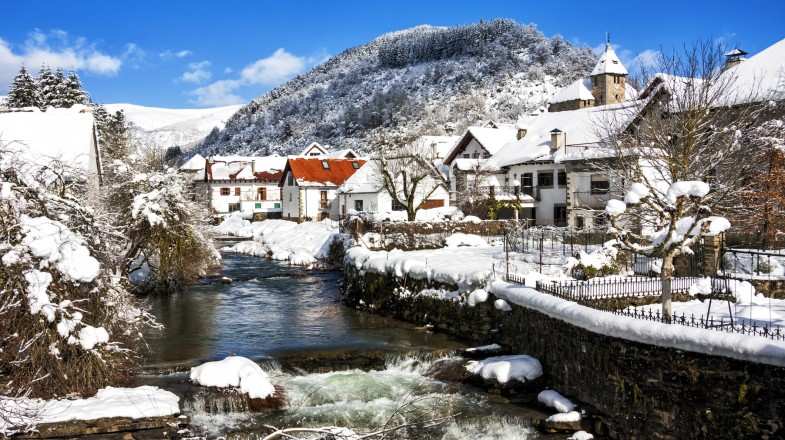
- 6.09K views
- ~ mins read
February, most definitely, is an underrated month for traveling to Spain . The winter season along with hardly any public holidays are the reasons why most people spend February at home. But booking a holiday to Spain in February can be a rewarding experience. Lesser foot traffic means a drop in room prices at hotels and plenty of opportunities to have the attractions for yourself and a select few.
Spain Weather in February

In comparison to other European countries, temperatures in Spain are mild during February. Cities on the south coast, such as Seville and Malaga , experience a warm winter with highs of 18℃ and lows of 8℃. Barcelona, given its Mediterranean climate, experiences a slightly colder but milder winter compared with other European countries. However, winters are colder in inland cities such as Madrid. The mercury in the Spanish capital generally hovers between 12℃ and 5℃ during this time of year. The temperature on the north coast is much more bearable, although the rain can hinder your outdoor plans in that region during February.
For in-depth information, check out our travel guide on the best time to visit Spain .
Weather in Spain in February - Rainfall and Temperatures
Why visit spain in february.

Most people visit Spain in the summer months to soak up the sun. But Spain also has a lot to offer during winter. If you have already been to Spain in summer, you will be surprised by how different the country feels during winters. Below are some reasons why you should travel to Spain in February.
Milder temperatures: Spain has a handful of winter escapades. Even though inland cities, such as Madrid, can get frigid, other places like Andalucía , Catalogna, and Valencia are still warm and sunny.
Fewer crowds: February falls in the low season when it comes to Spain tours, and unlike July and August, the country is not overcrowded with tourists. This has quite a few advantages for travelers. You will not only be able to skip the endless queues at main tourist attractions, but you will also have plenty of opportunities to interact with the locals.
Cheaper prices: Another great advantage of visiting Spain in February is that prices are way more affordable compared to the high season. You will surely get cheaper rates for your accommodation and other services, such as city tours, during this time of year.
Plenty of festivals: February also sees lots of festivals and celebrations in Spain. If you are heading to Spain in November, you must participate in the Sitges Carnival. This LGBTQ event is known all over the country for its crazy drag queen parade and night parties. Another great option is to take part in the Jerez Flamenco Festival , where you can watch beautiful shows and even enroll in flamenco classes.
Where to go and what to do
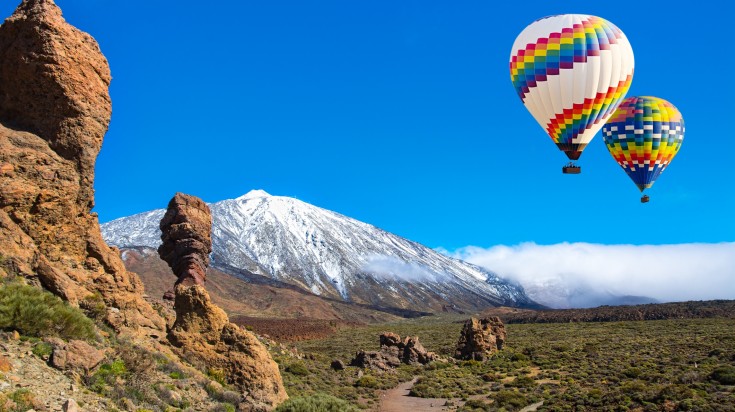
In addition to numerous festivities, there are plenty of things to do in Spain in February. For instance, you can visit Granada and ski in the nearby mountains. The Sierra Nevada, which is close to this historic city, sees snow cover for the whole month, making this the perfect destination for winter sports lovers. There can be no destination better than the Canary Islands for those wanting to escape the cold of the winter. Temperatures in these islands in February easily reach 20℃, seldom falling below 15℃. While in the islands, make sure that you visit Teide National Park , a UNESCO World Heritage site, where you can explore the crater of a volcano. If you are interested in the culture of Spain, make sure to include historic cities like Barcelona, Seville, or Granada in your itinerary. See the monumental Alhambra while in Granada, witness spectacular flamenco shows in Seville, and gaze at the architectural masterpieces of Gaudí in Barcelona.
February has always been an underrated month when it comes to Spain tours. However, this month has its fair share of advantages. From the snowy peaks of the Sierra Nevada to the beautiful national parks of the Canary Islands and the many historical cities in the country, Spain in February will surely not disappoint you.
Wondering how long does it take to cover it all? Check out our travel guide on how many days to spend in Spain for more ideas and insights. If you are in the process of planning your custom trip to Spain and need some help, feel free to reach out to our local travel experts in Spain . You can also browse through our trips to Spain in February for instant inspiration.
More Information
Spain in January Spain in March
Related Articles
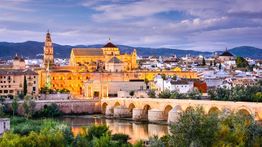
Best Time to Visit Spain
Spain is a country of lovers and adventurers.... read more

Spain in January: Fine Weather, Lower Prices
Spain is a winter paradise as much as it is a... read more
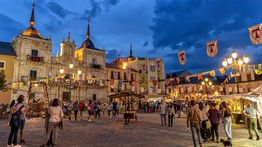
Spain in March: Weather and Travel Tips
Spain comes to life in March after a long win... read more
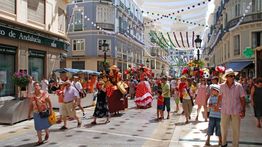
Spain in April: Celebrations and Local Delicacies
As flowers blossom and temperatures rise, the... read more

Spain in May: Weather and Travel Tips
From the beautiful Pyrenees Mountains to the ... read more

Spain in June: All You Need to Know
From the sunny beach of Costa del Sol to the ... read more

Spain in July: Great Outdoors and Warm Weather
From the crowded beaches of Tossa de Mar to t... read more

Spain in August: Summer Festivities with Fewer Crowds
August sees an uptick in tourist activities i... read more

Spain in September: Fewer Crowds, Better Rates
As September makes way for the cooler Mediter... read more

Spain in October: All You Need to Know
A trip to Spain in October is likely to be a ... read more

Spain in November: Exploring in the Rain
November is rarely taken into account when pl... read more

Spain in December: Festivities in Low Season
Spain in December can be a great month to exp... read more
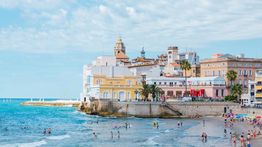
Summer in Spain: All You Need to Know
Boasting a mild, temperate Mediterranean clim... read more
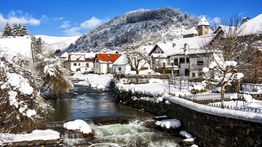
Winter in Spain: Top 5 Destinations
When you think of Spain, you most likely conj... read more
Related Categories
- How Long To Stay In Spain
- Spain Hikes/Treks
- Spain Travel Advice
- Top Spain Attractions
- What To Do In Spain
- When To Visit Spain
- Where To Go In Spain
- Previous Post

Popular Destinations
- Europe Tours
- Everest Base Camp Trek
- Italy Tours
- Argentina Tours
- Canada Tours
- Sri Lanka Tours
- Chile Tours
- Antarctica Tours


- South Korea
- Indonesia (Bali)
- Central Asia
- African Safari
- South Africa
- Itinerary Ideas
- Spain Weather in February: Travel Tips for First-Timers
February is a cool-to-mild time of year in Spain, with mostly dry weather. For visitors, we suggest visiting Madrid, Barcelona, Seville, and Valencia. Read on to find out more about Spain travel and weather in February, including temperatures, rainfall, humidity, and travel tips.
Content Preview
- 1. Weather Overview
- 2. Best Places to Visit
- 3. Crowds and Costs
- 4. What to Wear
Spain Weather in February: Overview
- Temperature range: 7–16°C (45–60°F)
- Rainfall: 4 cm (1 inch)
- Rainy days: 5
- Sunshine hours/day: 6
- Humidity: around 67% (a little damp throughout Spain)
February temperatures range between 7 and 16°C (45 and 60°F) on average throughout the country, slightly warmer in the south than in the north. There are around 6 hours of sunshine per day in February, for mostly sunny "winter" days.
Rainfall is low in Spain in February, at around 4 cm (or 1 inch), and there is rain only approximately 5 days out of the month. Humidity levels are slightly above comfortable, at around 67% on average.
Discover real reviews of Highlights Travel Family 's best-rated service across trusted platforms.
February Climate Comparison (Averages) for Spain's Top Tourism Areas
The best places to visit in spain in february.
February's daytime weather is mild in Spain, making it a great time of the year for lots of walking and sightseeing. We do recommend having a few indoor activities just in case you come across a rainy or a colder day, and also because some of Spain's museums are highly worth visiting.
For visitors in February, we would recommend visiting Madrid in the center of Spain, Barcelona on the east coast, Sevilla in the south, as well as Valencia also on the east coast.
Global Highlights can help you put together the ideal itinerary for your vacation in Spain. Our experts can take your needs and requirements, and turn them into an ideal holiday without any of the stress of planning! Just let us know what you'd like to see in Spain, and our team can make it a reality. Contact us to start planning your Spain trip .
1. Visit Madrid's Incredible Royal Palace
Madrid is the capital city of Spain, and you will likely start your trip in Spain there, since this is where most international flights come in.
We highly recommend spending some time at the Royal Palace, the official residence of the Spanish royal family while they are in Madrid, although the current King Felipe VI has chosen to not to reside there.
It was constructed between 1738 and 1734, in a Berniniesque design, notable for its use of art inside, as well as the wealth of fine materials used. Inside you will be able to see loads of beautiful items including the world's only complete Stradivarius string quartet, and paintings by Caravaggio, Juan de Flandes, and Francisco de Goya.
If you are interested in architecture and art, we do recommend getting a tour guide for your visit to make sure you have someone to ask questions and who can explain its incredible history. We can arrange this for you.
2. See Gaudí's Beautiful Structures in Barcelona
Barcelona is where you'll find Gaudí's beautiful structures, many of which are world famous and built in Neo-Gothic and Art Nouveau styles.
During your time in Barcelona, we recommend heading over to the Sagrada Familia, the world's biggest unfinished Catholic Church. The Sagrada Familia has been under construction for close to 100 years and still has not been completed, but is still a must-see if you are in Barcelona.
Gaudí's other sights include three famous houses, La Pedrera-Casa Milà, Cata Batlló, and Casa Vincens, as well as Park Güell, a park showcasing beautiful tile work and sculptures. You could spend a lot of time visiting all of these amazing architectural feats, and we highly recommend visiting them, since Gaudí only worked in and around Barcelona.
3. Tour the Largest Gothic Cathedral Rooftop in the World in Seville
Seville is home to the Catedral de Santa Maria de la Sede, a beautiful building blending Gothic, Renaissance, and Moorish architectural styles, and the largest Gothic cathedral in the world. The building was originally a mosque, built in the 21st century, and was transformed into a cathedral in the 15th and 16th centuries by Spanish Christians.
During your visit you will be able to explore the rooftop adorned with beautiful gargoyles and stained-glass windows. Inside is Christopher Colombus' tomb, which is an interesting thing to see.
February is also when Seville hosts its annual marathon, on February 18 in 2024 (and 23 February in 2025), so expect there to be some closures if you are in the city on that day. If you are a runner, why not participate?
4. Explore Valencia's Central Market
Valencia is home to a beautiful market that is also Europe's largest fresh produce market. The Central Market is where you'll find a collection of all local produce from Valencia and beyond, and is the perfect place to have some snacks or a drink. Whether you want to sit down and try some local cheeses and meats during your visit, or just want to stock up ahead of your trip back home, this is the place to be.
The building itself is also beautiful, being a modernist architectural building that has stained glass and beautiful tiles.
Other sights in Valencia include the Valencia Cathedral, the Serranos Towers, the Plaça de la Verge, and the Museum of Fine Arts of Valencia (Museo de Bellas Artes) in case you are looking for an activity that is indoors.
Crowds and Costs for Traveling in February
February falls in Spain's low season, with generally fewer crowds and lower costs for accommodation and transportation.
February does also see some celebrations, including La Candelaria, which is celebrated throughout the country, but mostly in Madrid, on February 2. This celebration honors the day on which Mary and Joseph took Jesus to the Temple in Jerusalem to perform the required sacrifice of purification 40 days after his birth. It is celebrated in different ways including a devil parade (in the theme of purification), or other candlelit parades and clowns dressing as farmers bringing out bulls.
February 28 is the Day of Andalucía , commemorating the referendum in 1980 to recognize Andalucía as an autonomous community in Spain. Some smaller shops and restaurants might be closed on this day in Andalucía since it is a public holiday. Andalucía's cities include Seville mentioned above, as well as Malaga, Granada, and Jerez.
What to Wear in February
February's weather is cool to mild, and we would recommend bringing a jumper as well as a coat. For those planning to walk around outside, wearing a scarf, gloves and a hat is a good idea, as well as supportive footwear.
Because February could still see a slight temperature drop before spring really kicks in, but also could see some warmer temperatures particularly in the south of the country, bringing plenty of layers to put on or take off is the best idea.
Why Global Highlights (10,000+ reviews & 98.8% 5-star rating)
- Save Your Time:
- Less research, more enjoyment!
- Real-time 1V1 expert planning
- Maximize Your Flexibility:
- Personal local guide and ride
- Explore at your own pace
- Celebrate Your Journeys:
- Specially-crafted family adventures
- Celebrate milestones with style!
- 7-Day Spain Essence Tour
- 7-Day Madrid and Barcelona Tour for Families
- 7-Day Spain Food Tour around San Sebastian
- 12-Day Morocco and Spain Highlights Tour
- Private Morocco Tours 2024/2025: Personalized and Stress-free
- Middle East Tours 2024/2025: Personalized and Stress-free
- Thailand Tours
- Vietnam Tours 2024/2025: Unique Personalized Experiences
- Top Private Turkey Tours 2024/2025: Personalized and Stress-free
- Spain Public Holidays 2024 — a Full List is Here
- La Tomatina 2024 - Date, Place, Schedule and Travel Tips
- Spain Weather in January: Travel Tips for First-Timers
- Spain Weather in March: Travel Tips for First-Timers
- Spain Weather in April 2024: Travel Tips for First-Timers
- Spain Weather in May 2024: Travel Tips for First-Timers
Get Inspired with Some Popular Itineraries
More travel ideas and inspiration, sign up to our newsletter.
Be the first to receive exciting updates, exclusive promotions, and valuable travel tips from our team of experts.
Why Global Highlights
Where can we take you today.
- Southeast Asia
- Japan, South Korea
- India, Nepal, Bhutan, and Sri lanka

- Travel Agents
- Privacy Policy

Address: Building 6, Chuangyi Business Park, 70 Qilidian Road, Guilin, Guangxi, 541004, China

- Travel to Spain Seasons
Best Time to Visit Spain: Monthly Guide & What to Expect

Win a FREE Trip to Spain!
Exciting Announcement! For the first time, we're thrilled to offer exclusive trips to the heart of Spain - an experience like no other. This isn't your typical tourist journey; it's a unique opportunity to immerse yourself in authentic Spanish culture, alongside real locals and our passionate team.
But there's more! Simply by requesting information about this amazing trip, you'll be entered into a special draw to win a Fully Paid Trip to Spain for Two. And that's not all - everyone who inquires will receive an exclusive bonus gift, valued at $500, available only now.
Click Here ↑ to Request Information & Enter the Draw!
Depending on your cup of tea, your journey through Spain can lead you to explore hidden coves while scuba diving, discover the Pyrenees’ snowy slopes, hike mountain peaks, see volcanic landscapes, or savor the view of spring flowers to the beat of Flamenco. You might even contemplate the bold tradition of running with the bulls among thousands of others!!
So I’m ready to share all my insights about the best times to visit Spain. Whether you’re seeking favorable weather, smaller crowds, or unique experiences, let me guide you to make the most of your trip planning.
Oh, and Spain’s diversity guarantees it’s a destination for everyone any time of the year!! (You’ll soon discover why.) There’s no such thing as a “once in a lifetime” place, well, maybe a few experiences. But Spain will keep calling you back, and you’ll want to return and see it through new eyes every time.
By now, you might swear I am biased (I may be a little) But, as a proud Spaniard and having lived in other countries like Iñigo, I can confirm that Spain ranks among the world’s top-tier destinations, so let’s get into it!
Rating (5 stars = an excellent month to visit, 1 star = consider another time)
Here’s our guide by season , in case you need more especific information:
- 🌸 Spring: 10 Best Spring Destinations in Spain: Weather & Fun Activities
- 🏖️ Summer: Summer in Spain: 10 Best Places To Visit & Weather Info
- 🍂 Autumn: 5 Best Autumn Destinations in Spain: Weather & Fun Activities
- ❄️ Winter: Spain in Winter: Weather, Destinations, Tips & more
Table of Contents ▼ ▶
Spain in January

First, you should expect the weather to change considerably depending on where you travel. Spain’s climate varies significantly from region to region.
- Most of the country has cold temperatures in January, especially in the northern and central areas. If you come to Madrid, for example, it can be pretty cold, with daytime temperatures from 41°F (5°C) to 54°F (12°C). I mean, this is the coldest month after February!
- On the other hand, southern cities in Andalucia, like Málaga Cádiz, enjoy more favorable temperatures, with highs ranging from 59°F (15°C) to 63°F (17°C).
- Also, rainfall is very common, especially in the northern regions along the Atlantic coast, while the south tends to be drier overall.
📌 Read Full Article: Spain in January: 9 Travel Tips, Activities & Weather
As for the activities in that month, the highlight is celebrating the Epiphany, known as “Dia de los Reyes Magos” (or Three Kings’ Day) on January 6th. You have to try the traditional sweet called Roscón de Reyes. It’s delicious!
Lastly, January is one of the lowest seasons for tourism, and prices are usually lower. So you can take your time to get great deals around the country.
Rating: ⭐⭐ (sorry but Spain can do better)
Spain in February

If you plan to visit Spain in February, you’ll take advantage of the off-peak tourist season, which can be better for your sightseeing experience.
However, the weather can be somewhat unpredictable, and cooler temperatures are the norm in the country. So, be prepared for chilly evenings and occasional rainfall, particularly in the northern and coastal regions.
- Southern regions like Andalusia enjoy milder temperatures with daytime highs around 59°F (15°C) to 63°F (17°C)
- The Northern and central parts of Spain are cooler, with daytime temperatures ranging from 41°F (5°C) to 54°F (12°C).
However, January is a beautiful time for winter activities, and prepare to indulge in local flavors such as Fabada Cocido Madrileño, which are enjoyed hot, so it’s worth waiting for this time of year to savor these traditional dishes!
While February may not be the most common time to travel to Spain, it’s a month known for hosting one of the most renowned carnivals in the world (after Rio de Janeiro in Brazil), the Carnaval of Cádiz! ( read more )
📌 For other activities and celebrations, read here: Spain in February: 8 Travel Tips, Activities & Weather
Rating: ⭐ (nope, still not there)
Spain in March
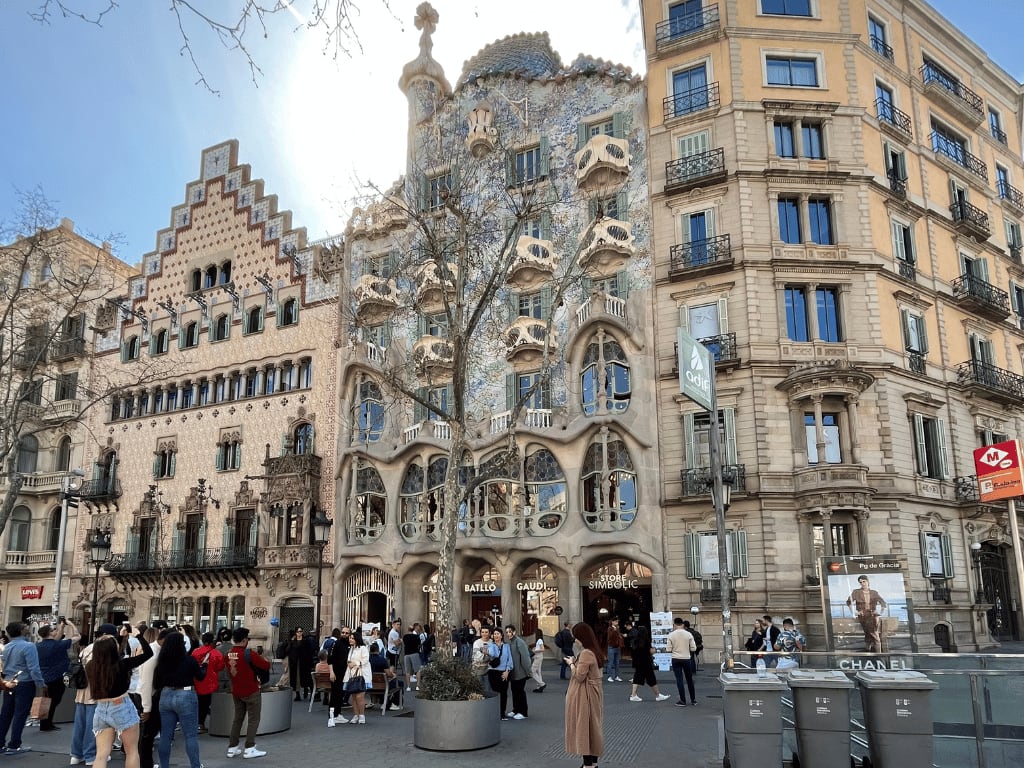
Spain transitions from Winter to Spring in March. This means it dawns much earlier, the nights are longer, and joy returns to the big cities, becoming an ideal destination. But the weather still varies depending on the region:
- Southern Spain enjoys milder temperatures, with daytime highs ranging from 59°F (15°C) to 68°F (20°C).
- The northern and central areas experience cooler temperatures ranging from 48°F (9°C) to 59°F (15°C).
I mean, it is “still winter” until late March, so crowds are not high, and flight prices and hotel rates are usually lower than in the April-May shoulder season.
You can save lots of money on flights and hotels, and it’s a great time to visit the big cities as the crowds for main attractions and landmarks are less packed than in Summer.
Overall, late March marks the beginning of the best months to come to Spain.
📌 Read Full Article: Spain in March: 8 Travel Tips, Activities & Weather
Rating: ⭐⭐⭐⭐ (Almost getting there!)
Spain in April

Traveling to Spain in April is a fantastic decision since you’ll experience pleasant weather, lively festivals, and stunning landscapes. It’s perfect: Spring is blooming, you’ll find almond and cherry trees peaking, the weather is increasingly warm as the months go by, and more daylight hours!
- Northern Spain can still be cool in April. It experiences daytime temperatures from 54°F (12°C) to 61°F (16°C). You should expect occasional rain showers.
- Southern Spain enjoys warmer and sunnier weather. Daytime temperatures range from 63°F (17°C) to 72°F (22°C) (or even higher in some towns). Expect sunny days, blue skies, and less rainfall overall.
📌 Read Full Article: 10 Best Spring Destinations in Spain: Weather & Fun Activities
Also, you should note that April in Spain is a desired month since the famous tradition of Semana Santa (Holy Week) and the renowned April Fair in Seville takes place. Learn more about it:

Overall, April is more relaxed than the peak summer months, but it is still a popular time for tourists, so book in advance, and you won’t have any trouble. This month offers a lot of fun days and exciting events for visitors!
Rating: ⭐⭐⭐⭐⭐ (Just fantastic!)
Spain in May
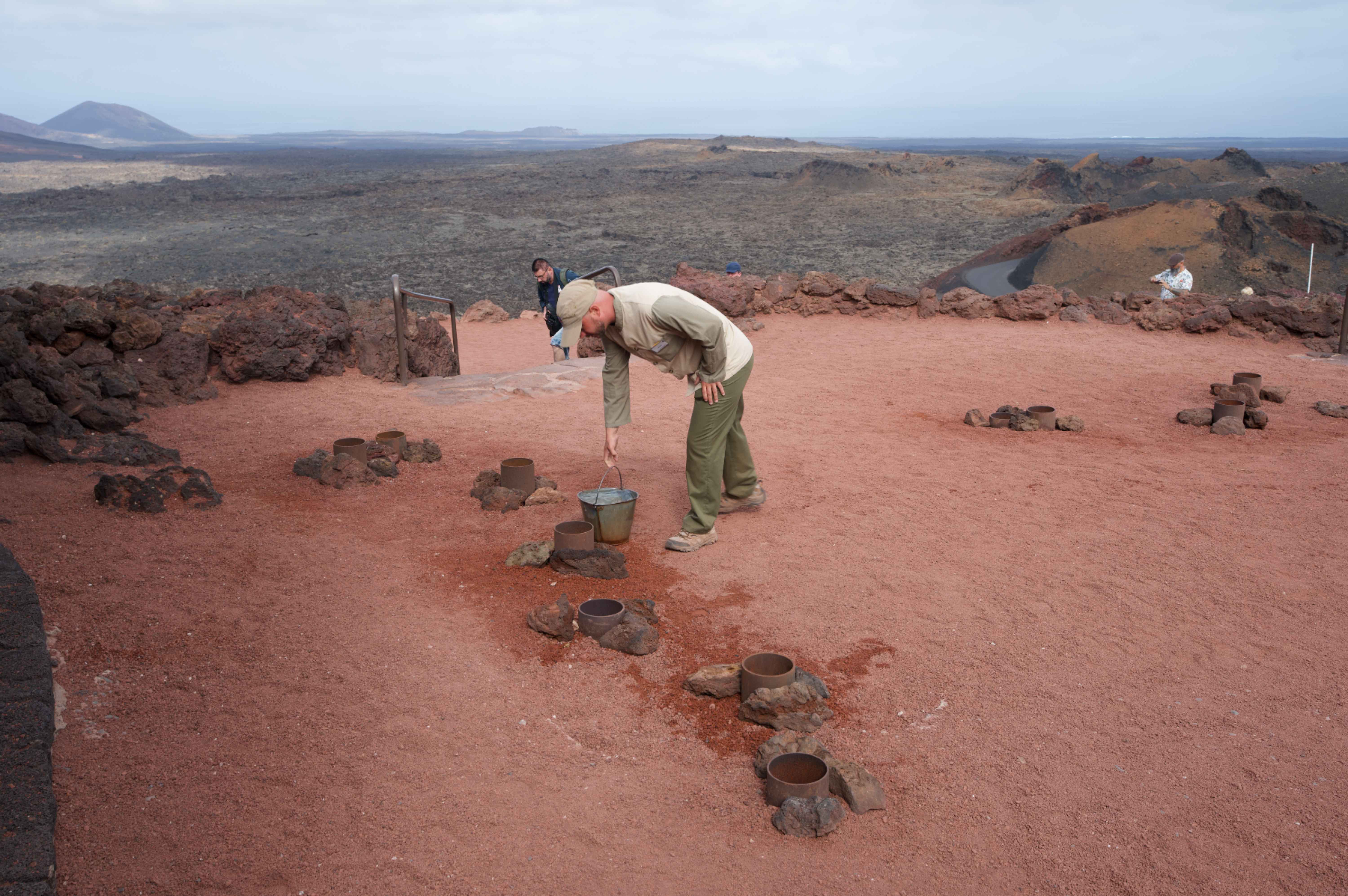
May is also one of the best months to travel to Spain. The weather is delightful, perfect for strolling the streets in warm temperatures without sweating. It is a great time to hit the Mediterranean coast and explore natural landscapes, as Spring will have them blooming!
You should expect longer days, cooler mornings, warmer nights, and festivities, so pack light, breathable clothing but light jackets for evenings.
📌 Read Full Article: Spain in May: 7 Travel Tips, Activities & Weather
Also, I recommend going on weekend getaways to nearby towns, which are also perfect for these dates, as most of the country experiences delightful weather during this month.
- In the north, cities enjoy mild and pleasant weather, with daytime temperatures ranging from 61°F (16°C) to 68°F (20°C). Central Spain is a bit warmer but pretty similar.
- Southern regions experience warm and sunny weather, with daytime temperatures ranging from 77°F (25°C) to 81°F (27°C).
May is the last month to take advantage of lower flight tickets before the Summer prices arrive, so book everything in advance so you can get great deals. Nothing to worry about compared to the summer months.
Rating: ⭐⭐⭐⭐⭐ (Perfect time to come!)
Spain in June

June is the transitional month for Summer in Spain. You should expect longer days of sunny, bright, and warm weather in almost every part of the country. It is also a great time to visit the beaches like Costa Brava, Costa del Sol, and the Islands.
But hear me out: This is the absolute LAST chance to visit the Islands before they get packed with visitors (and party people). Plus, the lower prices than in July and August make June one of the ideal months to travel!
- Temperatures in Northern Spain are more pleasant than in the South. It has daytime temperatures ranging from 64°F (18°C) to 72°F (22°C).
- Central Spain is a bit warmer, 77°F (25°C) to 86°F (30°C).
- Southern Spain will be at 86°F (30°C) or higher most of the time.
📌 Read Full Article: Spain in June: 9 Travel Tips, Activities & Weather
In addition, walking in the middle of the day in inland cities such as Madrid, Córdoba, or Seville in July or August is almost impossible. So June is your last chance to do it.
Festivals, concerts, and celebrations will be all over the place, and the famous “discount season” in sites like Zara, Massimo Dutti, El Corte Inglés, and almost every clothing shop. They begin the last week of June and end in August. ( Read more )
Rating: ⭐⭐⭐⭐⭐ (Amazing, you’ll have a blast)
Spain in July
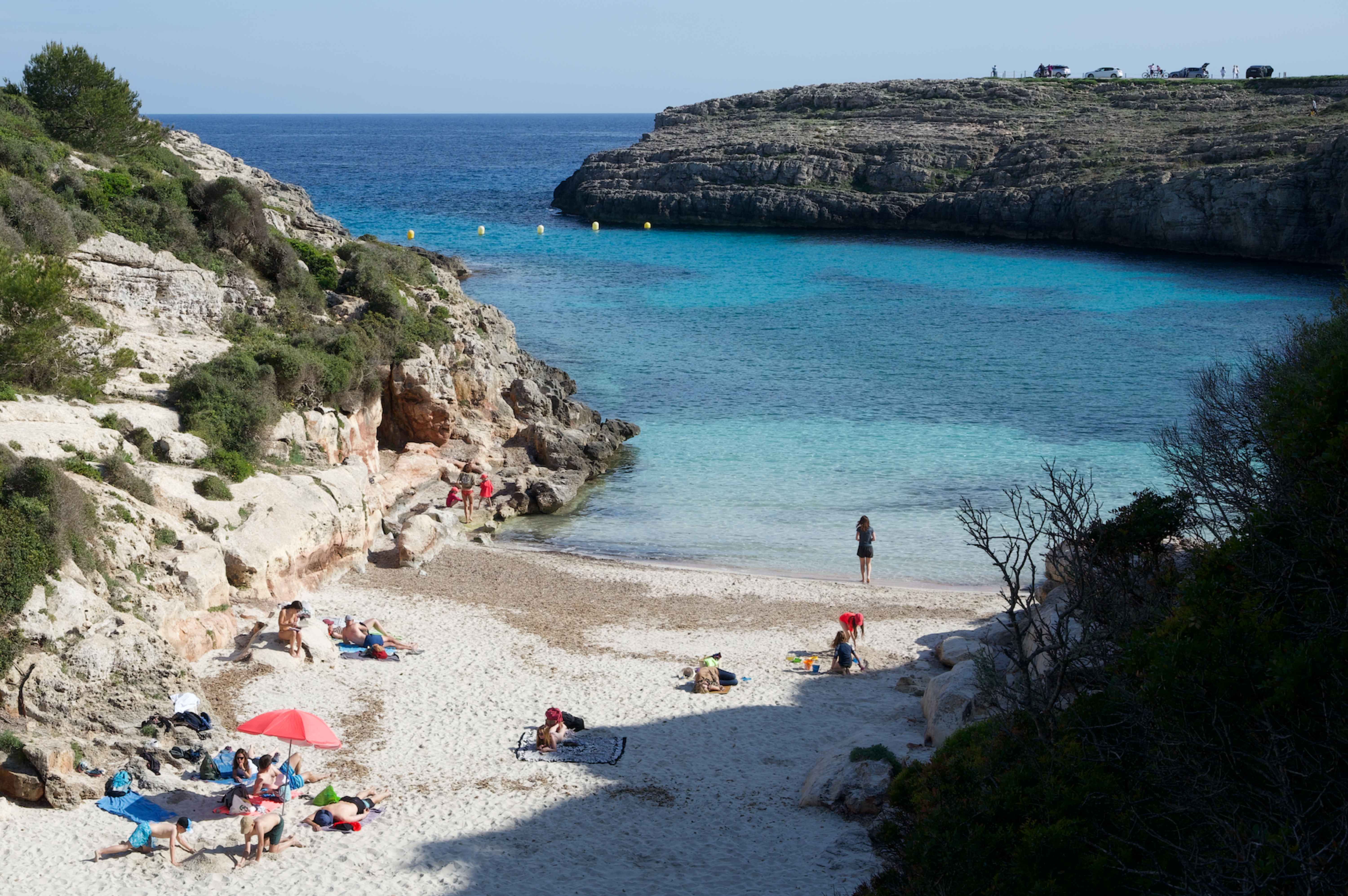
July is the high season in Spain. It is a perfect time to visit to experience the ideal sunny European vacation. The weather is extremely warm, great for visiting our beaches and doing water sports, sunbathing, and swimming, and you’ll find an array of cultural festivals and outdoor activities.
You should expect it to be sunny and warm across Spain, with some variations depending on the city you’re visiting. It is also dry almost everywhere in the country, except the north, which has a few days of rain.
📌 Read Full Article: Spain in July: 7 Travel Tips, Activities & Weather
- Northern Spain has mild and temperate weather with temperatures from 68°F (20°C) to 77°F (25°C). Central Spain, Including Madrid, has temperatures of (30°C) to 95°F (35°C) or even higher. So be prepared for the sun’s intensity because it gets really hot in here!
- On the other hand, Southern Spain is boiling at this point of the year, at 95°F (35°C). Stay away from these cities unless you’ll spend your days at the beach!
Regarding crowds and prices, they typically peak during the summer months. Therefore, if you prefer to avoid large crowds and seek a more budget-friendly experience, consider alternative months for your visit.
Nevertheless, there are multiple ways to make your travel vacation more cost-effective. ( Find out here! )
Rating: ⭐⭐⭐ (too hot & crowded)
Spain in August

Spain in August is one of the most popular months to visit Spain, and it is also high season as the coastal areas are at their prime! Places like the Costa Brava and the Balearic and Canary Islands offer the perfect weather for long beach days. You can also expect local neighborhoods to be less crowded than usual.
While some might call it a “dead month,” Spain still welcomes many visitors, particularly in beach towns and tourist hubs. Also, neighborhoods like Gràcia or Poble Sec in Barcelona are less crowded, and the Barrio de Salamanca in Madrid is also much quieter than usual.
- Northern Spain enjoys pleasant weather, with temperatures between 68°F (20°C) and 77°F (25°C).
- Central Spain, including Madrid, has temperatures ranging from 86°F (30°C) to 95°F (35°C) or even higher! Here’s why locals usually leave the city for vacation.
- Southern regions can get extremely hot, with temperatures exceeding 95°F (35°C) and even higher. You see, that kind of extreme weather is just too much for my liking.
📌 Read Full Article: Summer in Spain: 10 Best Places to Visit & Weather Info
My advice for brave travelers who want to see the hype around the famous Ibiza and Mallorca in the Summer is to book everything in advance and plan your trip well. Always check the weather, pack accordingly, and please use sunscreen and stay hydrated!
You will have a blast! Hot weather is just the perfect excuse for enjoying ice cream and refreshing drinks at any hour. (As if we needed a reason for those activities in the first place!)
Rating: ⭐⭐⭐ (still too hot & crowded. Didn’t remove 1 star because of the famous festivals in the Islands, they’re worth it)
Spain in September
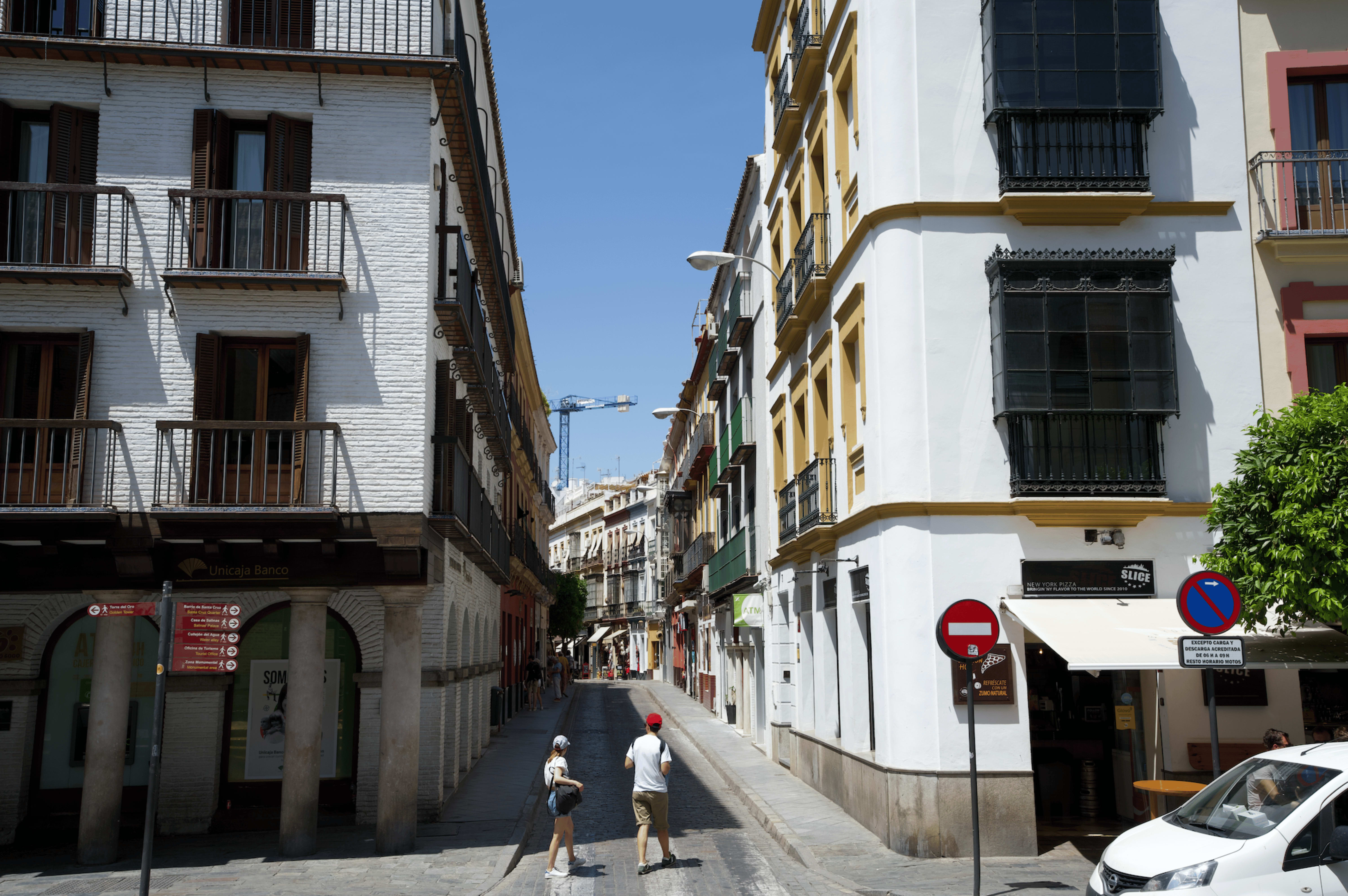
September is an excellent time to visit Spain. It is considered shoulder season after the peak of Summer; the weather is mild and comfortable throughout the country, with wind and occasional rainfall during the nights. Also, the islands and coastal areas are still perfect for going to the beach without extreme heat but way less crowded.
You should expect many cultural events and a great time to visit vineyards as the grapes are at their ripest and the harvest occurs. In Seville, the Bienal de Flamenco is a must-see!
📌 Read Full Article: Spain in September: 9 Travel Tips, Activities & Weather
As the peak tourist season winds down, it’s a great time for touring the big cities.
- Northern Spain has a temperate climate of mild weather; temperatures are from 68°F (20°C) to 77°F (25°C). Although it can be very bipolar…
- Central Spain, including Madrid, enjoys warm and pleasant weather with temperatures from 77°F (25°C) to 86°F (30°C)
- Southern regions continue to have warm and sunny weather with temperatures from 86°F (30°C) to 95°F (35°C).
Rating: ⭐⭐⭐⭐⭐ (10/10)
Spain in October
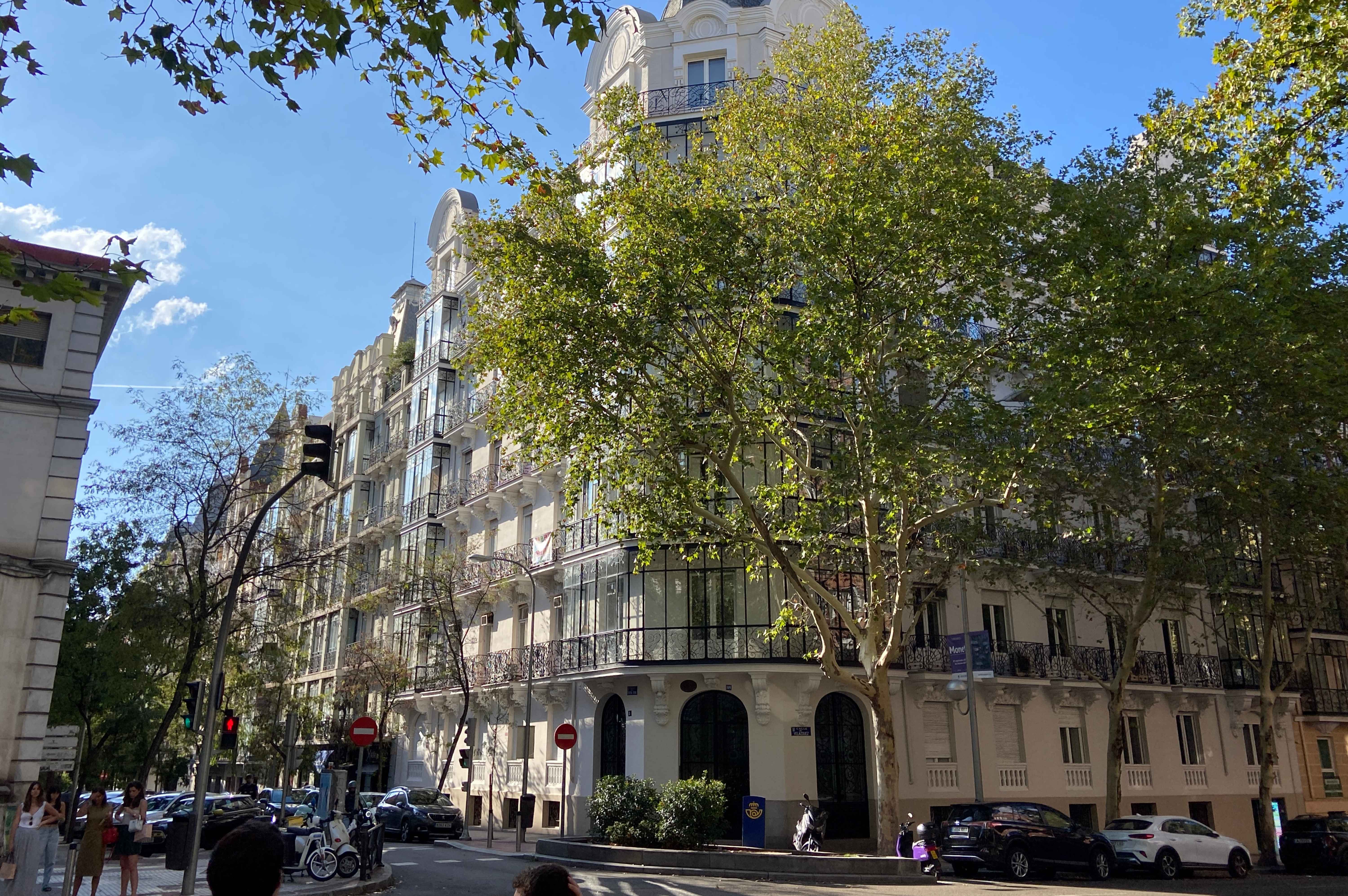
October is a great time to visit Spain, as it is shoulder season, which means you can enjoy more affordable prices and fewer crowds compared to the peak summer months. The weather is cozy in most of the country, and there is still plenty of sunlight to explore attractions without long lines and do fun activities at night!
But take this with a grain of salt since October is still great weather and a month full of activities, making it a relatively popular time for tourists.
- Northern Spain has cooler temperatures, from 59°F (15°C) during the day to cooler evenings, and it does rain.
- Central Spain, including Madrid, enjoys mild temperatures around 68°F (20°C) to 77°F (25°C), and evenings are cooler.
- Southern Spain still has warm and pleasant weather (I know!) with temperatures between 68°F (20°C) and 77°F (25°C). (it seems like the South is often a few months behind the season.)
I think it’s clear by now that my best advice is to book specific activities, flights, or accommodations in advance to ensure a smooth and enjoyable visit.
📌 If you don’t know where to begin, this itinerary can help you: How to spend 2 weeks in Spain? 12 Cities & Activities
Rating: ⭐⭐⭐⭐⭐ (wine & cozy weather. I’m in!)
Spain in November

Visiting Spain in November is perfect for those who prefer a more laid-back and budget-friendly travel experience, as you can take advantage of the low season.
Hotels usually launch weekend offers and discounts. One of the best things is that cities, towns, and villages are less crowded and, as a result, less stressed. You can visit museums, monuments, and restaurants without queuing up.
It is also a great time to do the Camino de Santiago, a pilgrimage route done annually by millions of pilgrims over the centuries. It starts in France and finishes in Galicia, in Santiago de Compostela.
📌 Read Full Article: Spain in November: 9 Travel Tips, Activities & Weather
November is a transitioning month to winter. So you should expect cooler and unstable weather conditions experienced in November.
- In the north, Northern regions experience cooler temperatures and rain, temperatures are from 46°F (8°C) to 59°F (15°C).
- Central Spain enjoys mild weather with daytime temperatures between 48°F (9°C) and 61°F (16°C) and rain.
- Southern regions maintain milder temperatures, ranging from 54°F (12°C) to 66°F (19°C).
It’s best to check the weather in the specific city and your travel days.
Rating: ⭐⭐⭐ (mmm, it begins to get too grey)
Spain in December
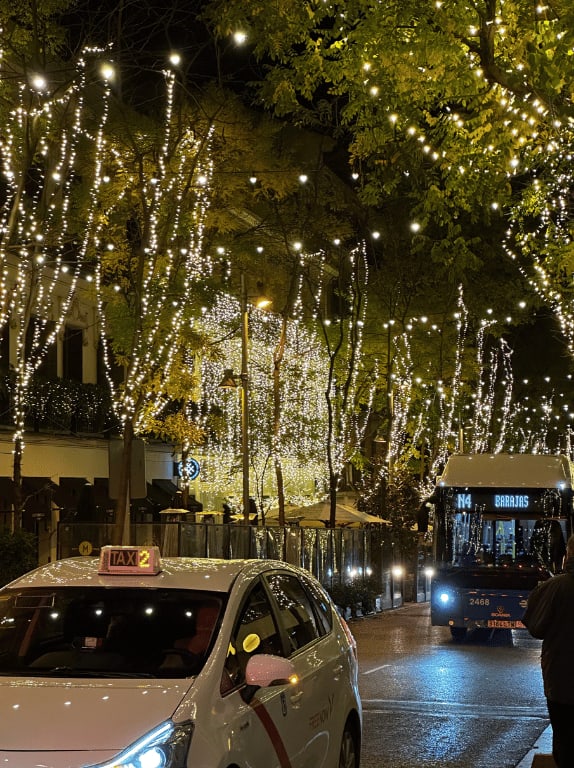
Spain in December is a beautiful month to travel to Spain. As a predominantly tradition-based culture, Christmas will be all over the place, creating a lovely atmosphere! While the weather is cold, it’s far milder compared to Northern Europe’s dark and grey winters.
The weather in Spain in December is cold but nothing compared to dark-grey Northern European winter. There are many family-friendly activities, delicious dishes unique to Christmas Eve and New Year’s, and many hidden traditions travelers would love!
December is the beginning of Winter in Spain, but temperatures vary across the country.
- Northern regions have cooler temperatures and rain, and temperatures are 41°F (5°C) to 55°F (13°C).
- Central Spain enjoys cool weather, with temperatures between 36°F (2°C) and 55°F (13°C).
- Southern regions maintain milder temperatures, ranging from 50°F (10°C) to 61°F (16°C).
You should expect popular attractions to be a little busier than in off-season months due to the holiday season, but everything will be alright with some planning.
📌 Read Full Article: Spanish Christmas: How We Celebrate a Merry and Bright Holiday
Rating: ⭐⭐⭐ (Our Chistmas markets hold at least one and a half stars)
What’s the best time to visit Spain?
All things considered, the best times to visit Spain are during Spring (late March, April, May, until mid-June) or Autumn (September, October, and early November). These seasons offer the most favorable weather conditions, many festivals, reasonable prices, and the best overall experience!
Frequently Asked Questions
What is the cheapest month to go to spain.
The cheapest month to visit Spain is January, especially during the final week of the month. You’ll find significantly lower prices during this period compared to the peak tourist season.
People gradually return to their work routines, and the holiday season has ended. The weather tends to be cold and somewhat unpredictable, with fewer festivities occurring in late January and early February compared to Spain’s bustling high-season months.
📌 Read more: How to Travel Spain on a Budget: Cost Guide & Tips

What months are high season in Spain?
The high season in Spain kicks off around mid-June and ends in late August. During this time, you can expect prices to skyrocket, more crowds, and major cities packed with tourists. And let’s not forget the scorching weather – it’s almost unbearable for the locals!
📌 Read more: 15 Best Beach Holiday Destinations in Spain (by season)
What season is best for wine tours in Spain?
The best time to visit vineyards and wine tourism in Spain is between July and October, especially during Autumn. Why? The grapes are at their ripest, and the harvest occurs. These months offer a unique opportunity to experience the process of grape harvesting and wine production, perfect for those interested in gaining deeper insights into the winemaking journey.
📌 Read more: Spanish Vineyards: Insider’s Guide to the Best Wine Tours

What month is the best weather in Spain?
The best weather is relative. One of the most enjoyable months is undoubtedly during the spring season, from April to May. This period offers an ideal blend of pleasant climate conditions where temperatures typically range from around 56.48ºF (13.6ºC) to 80.6°F (27°C), although this can vary depending on the region.
Alternatively, if you savor hot and sunny days, your prime window to experience Spain at its brightest and driest is between June and September when rain is scarce.
📌 Read more: What’s the climate in Spain? Our Real Weather and Temperature

What time of year is best for Spain beaches?
The best time to visit Spain and enjoy the beaches is late Spring and early Fall. In summer, the beaches tend to be crowded, and during Easter, Spain attracts millions of tourists due to the holidays and festivities.
📌 Read more: 23 Best Beaches in Spain: Key Tips to Visit & Videos!
I hope this list has offered you valuable insights to choose the best time for your vacation to Spain!
Please keep in mind that preferences can vary, which is why I included objective arguments before offering my personal rating based on my preferences.
However, I genuinely believe that these are the best months to visit and have an exceptional experience!
Don’t hesitate to ask questions about planning your trip, because we’re here to help you.
Happy travels!
READ NEXT: 33 Best Attractions in Spain Everyone Should Visit
Rating: No ratings yet. Leave a comment!

You might also like...

10 Days in Spain: The Best Itinerary to See Everything!
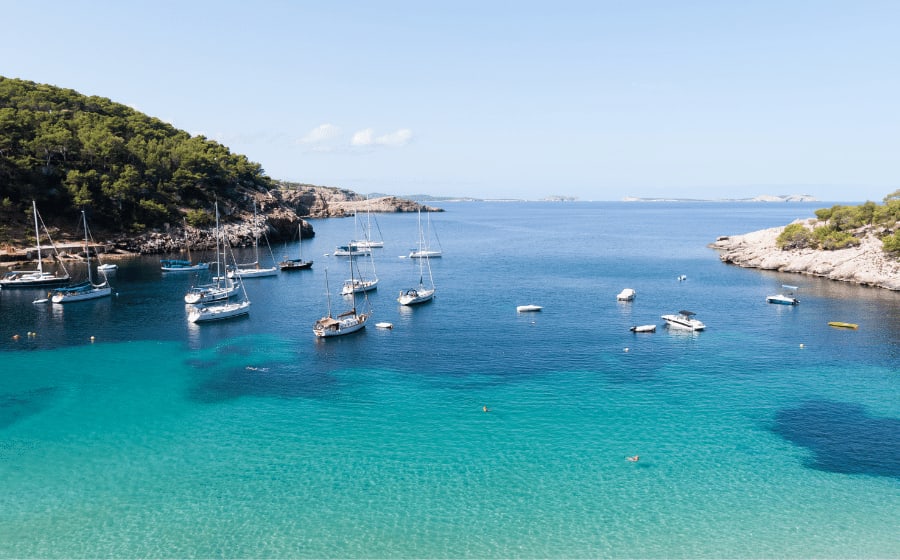
Ibiza vs Mallorca: 5 Key Differences for Tourists!
Email address (optional), star rating (optional).
Be the first to comment!

Millions of people como to Spain every month! But many never get to experience the SENSATIONAL SPAIN!!
We're both born and raised Spaniards and our goal is to give you all the resources to plan a perfect trip to Spain.
Take a look! 👇
FYI! Some affiliate links may be sprinkled throughout the post. We'll receive a small commission when you purchase from our links (at no extra cost to you), which will help us keep creating content.
Join the waitlist
I'm about to release my City Guides for Madrid, Barcelona, Sevilla and Mallorca.
They're going to have everything you need to plan the perfect trip. From hotels and transport, to restaurants, attractions, activities, & a lot (A LOT!) of tips & tricks.
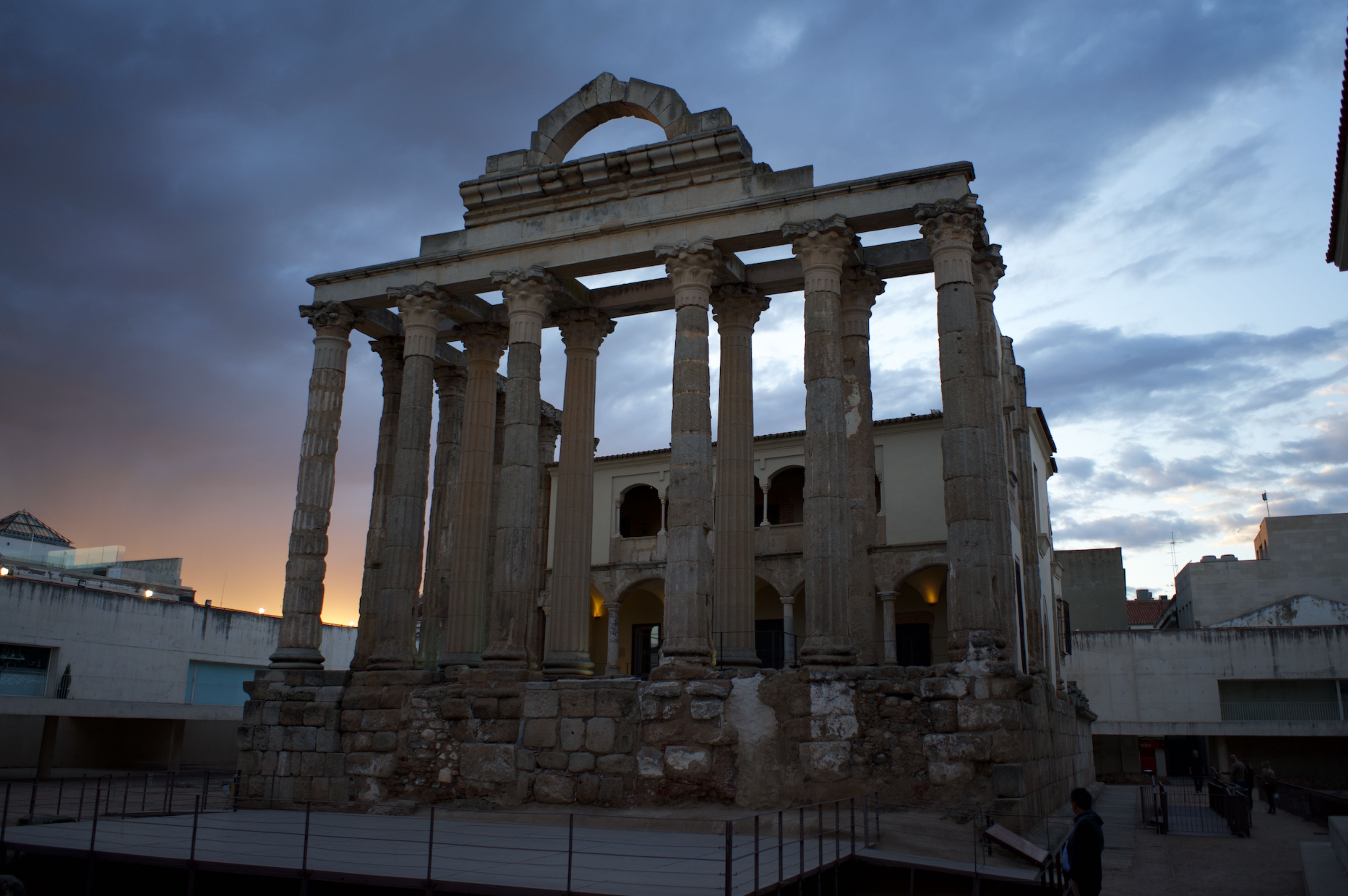
33 Best Attractions in Spain Everyone Should Visit

What do Spanish People Think of Americans?

What Song Are You Listening To? MADRID


What is the Best Show to Learn Spanish?

Things People Should NEVER do Dating in Spain

Can Foreigners Adapt To The Spanish Lifestyle?
Spain in February: Top Destinations and Events
It’s never a bad idea to travel to Spain in February just because the weather’s a bit gloomy. There are little to no crowds in metropolitan cities, tourist spots, and it’s the perfect time to simply relax and enjoy the rainy days while munching on churros and hot chocolate.
Some regions, particularly cities near the Mediterranean coast, get relatively sunny weather with lesser rain showers. Pretty much, Spain is incomparable to the rest of Europe, which are mostly blanketed by snow in the whole of February. Still, there are lovely snowy mountains that peek through the distance, offering peaceful views.
Despite the cooler weather and a couple of rain showers in the afternoon, winter is a great time for visiting. Because it’s an off-season, the number of tourists is lower, meaning, everyone can stroll freely and avoid the long lines for the attractions.
Get to know Spain in February weather, the best destinations , and events during this time of the year.
Table of Contents
Spain Weather in February
The weather varies significantly across the country, influenced by the oceanic climate. Coastal cities and towns may experience warmer temperatures, hitting a low 60 degrees Fahrenheit.
There aren’t many rain showers in February at this time of the year, and the weather is definitely dry than other regions.
The far south of Spain or the Andalusian region has milder cold weather mid-60 degrees Fahrenheit. Well-differentiated weather is experienced, with short inter-seasonal showers during the day. Meanwhile, the center, harsh winter conditions can be expected, especially in the Iberian plateau.
For travelers going to the Basque Country, get ready to embrace cold-weather fronts and intense rain showers. North Spain has an average temperature of below 40 degrees Fahrenheit, and is usually packed with heavy rains.
Barcelona, even though it is located in northern Spain , has milder temperatures because of the sea. No bitter cold mornings and nights can be experienced in Barcelona and nearby cities. The average temperature is 57 degrees Fahrenheit to 60 degrees Fahrenheit.
Central Spain , where Madrid is located, experiences slightly higher temperatures with minimal rain. It’s relatively dry and snow is rare, so long walks are feasible. Avoid getting up too early or going out late at night as the temperature drops.
Unless visitors are coming with elderly or toddlers, Spain in February weather is tolerable and desirable especially during mid-day and afternoons.
Top Destinations in February in Spain
To do lots of outdoor activities, it’s best to visit coastal cities and towns with warmer weather conditions. The entire Mediterranean coast is a fantastic destination, with lesser gloomy weather and more sunny days. Going all the way up to Valencia , Barcelona, and Alicante is a top choice.
Madrid is also a lovely place for a winter holiday, with lesser rain showers during the day. A lot of museum hopping is recommended, with side trips to plazas, palaces, and the Mercado de San Miguel.

With a Mediterranean climate, Valencia is easily one of the top destinations in the month of February. The sun shines brighter during the day and the lowest temperature to experience is 8 degrees Celsius at night. It’s a coastal city with beautiful beaches surrounding the central town, so visitors can spend the day sunbathing and doing outdoor activities.
Home to the authentic and traditional paella, Valencia is one of the top pillars of Spanish cuisine . Paella restaurants and stands are everywhere, and travelers shouldn’t miss the seafood variety, which is pretty famous here.
Going around the city, Gothic architecture and Renaissance buildings are dotted in almost every corner. Visit the historical monuments, churches, and museums. The Valencia City Hall is among the eye candies of the city, showcasing a central clock tower, breathtaking interiors, and Roman arches on the balcony.
The City of Arts and Science is Valencia’s well-kept museum with a space-like exterior. Housing a host of attractions and activities, this modern building is not only for kids but also for adults. Here lies a huge planetarium, IMAX Cinema, botanical collection, and science exhibit. There’s also an oceanarium that showcases 500 distinct species.
There’s also a hip, modernized Old Town called Barrio del Carmen or El Carmen that’s filled with numerous shops, restaurants, bars, and nightclubs.
WHERE TO STAY? Best hotels in Valencia.

February in Spain is certainly lovely in the capital city Madrid because of the lesser crowds and the cool weather. This month is still perfect for skiing , so hit the slopes at Puerto de Navacerrada. It’s relatively close to Madrid, gracing the ski resort with the beautiful views of Sierra de Guadarrama.
The Retiro Park is also a must-visit at this time of the year because the atmosphere is laid-back. The tree-lined boulevard is eye-catching, and it’s the best place to go when traveling with children.
For a serene lunch surrounded by the lake, head to Casa de Campo park. The Madrid zoo is located here, along with the theme park and the cable car.
For art enthusiasts, the month of February opens up more opportunities to enjoy the famous artworks without the flock of tourists. Check out the modernist masterpieces at Prado Museum, Reina Sofia , and Telefónica Foundation at Gran Vía. While here, explore the urban esplanade dotted with cinemas, theaters, bars, and alfresco restaurants.
Before heading back to the hotel, pay a visit to churros houses that serve the best fried doughs and thick, rich chocolate dip. The famous San Ginés is located in Madrid, which is the oldest churros house in the city. It’s open for 24 hours, so travelers can dunk the thick, fried dough into the chocolate at any time of the day.
WHERE TO STAY? Best hotels in Madrid.

The coastal city of Barcelona is probably the top destination during winter as the weather rarely drops. The days are sunny for most of the time, and fewer people are visible on tourist spots. Travelers will love the colorful trails of the city, narrow alleys of the Gothic Quarter, and the sumptuous treats that separate Catalonia from the rest of Spain.
Spain in February is the perfect time to visit the historic monuments, Gaudí buildings , and other attractions. Because of the cold breeze, travelers can also enjoy thermal baths to relieve muscle pain from non-stop exploration.
The food scene during winter is also insane, with lots of traditional pastries and delicacies popping around small markets. The Catalan turron and polvoron are among the popular delights, as well as sugary churros and calçots. The latter is a Catalonia delicacy that’s cooked in flames then dripped into a rich sauce—it’s all party in the mouth.
WHERE TO STAY? Best hotels in Barcelona.
Popular Events
Join the locals in celebrating the biggest festivals and other events every February. This time of the year is huge for the Carnival, which is celebrated across Spain . The flamenco festival also falls in this month, showcasing the world’s greatest flamenco artists in the town of Jerez.

Cadiz and Tenerife are two places with a huge Carnival celebration. Street parties are common in a week-long celebration, along with colorful processions and extravagant parades . These are riotously fun, as participants wear the most bizarre and colorful dresses.
Celebrated before lent, the life of the party extends to the streets and people are seen having fun. Usually takes place in late February to early March , the Carnival involves lots of music, dancing, and more colorful dresses on the streets.
Festival de Jerez
Spain in February is also huge for flamenco fans as Festival de Jerez brings together the greatest performers in the country. Flamenco is a long-standing tradition with roots in Andalucia, and it’s celebrated every February 21 in the town of Jerez.
Renowned performers put up workshops to teach advanced flamenco dancing classes. Past performances include artists like Antonio Reyes, Diego Carrasco, María del Mar Morena, and a lot more.
February in Spain is definitely fun with a number of flamenco performances to grace the crowd in Jerez. Admission is usually free, and visitors can participate in different events.
Check out these activities in Spain

Evan Kristine a.k.a Pretty Wild World is a professional travel blogger with over 10 years of experience in content creation. Originally from the Philippines, she's been living in Finland for 15+ years working as a chef and entrepreneur in Tampere, Finland.
She's an expert in Finland travel and explores the country often sharing her insights and tips in this blog and social medias. She also splits her free time either going for weekend getaways in Europe or galavanting to different European destinations on her holidays. All her useful Europe travel guides are also in this blog!
Evan Kristine is also the food blogger behind at The Kitchen Abroad and on her free time, she enjoys decorating her 75m2 apartment and shares her experience over at Solía Avenue .
A true master of her own life and despite her busy schedule juggling life as a chef, blogger, and entrepreneur, she still finds time to read 50+ books a year and indulge in several hobbies like hiking, working out, yoga, and painting.
Sharing is Caring
Help spread the word. You're awesome for doing it!
- Group Enquiry? NEW
- Spain In February
Things to Do in Spain in February
- Explore the Iconic Sagrada Familia
- Wander Through the Park Guell
- Discover the Casa Vicens
- Immerse in the Curves of Casa Mila
- Step into the Imaginative World of Casa Batllo
- Take a local food tour
Enjoy Montjuic Cable Car Ride
- Experience the Marine World at Barcelona Aquarium
- Watch a Flamenco Show
- Take a tour of Alhambra
Here are Some Best Things to do in Spain In February
Quick navigation, essential information, weather conditions of spain in february.
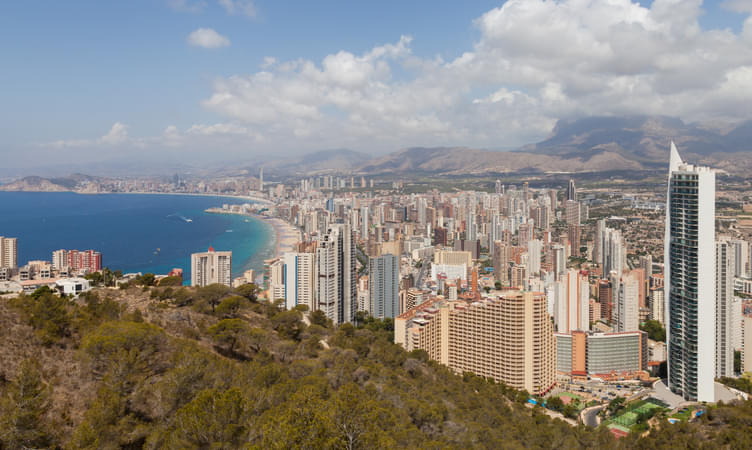
Best of United Kingdom
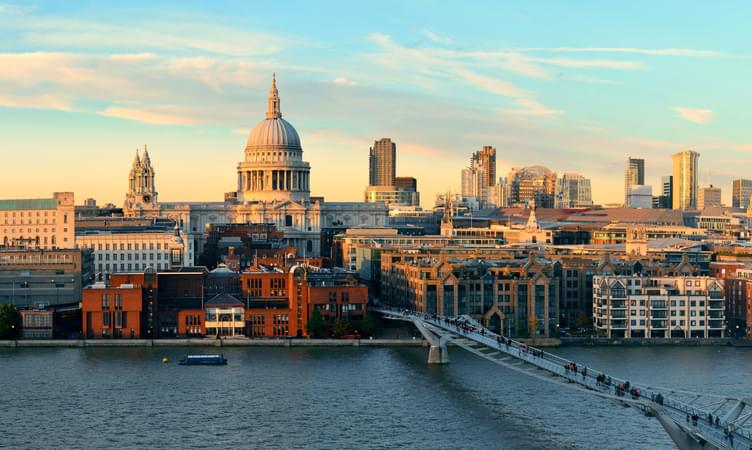
What To Pack For Spain Trip
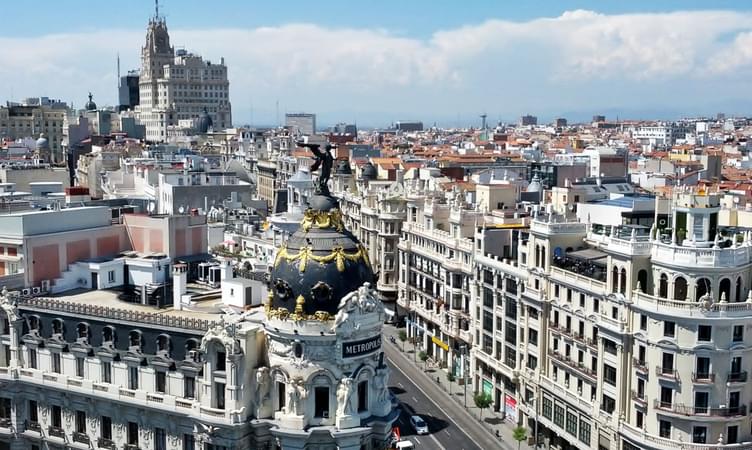
Best of Greece

Spain In February: Things to do in Spain In February
Explore the iconic sagrada familia.
_08.jpg?gravity=center&width=752&height=450&crop=fill&quality=auto&fetch_format=auto&flags=strip_profile&format=jpg&sign_url=true)
- One of the best things to do in Spain in February is explore the iconic Sagrada Familia, the world's largest unfinished church.
- It is the most spectacular work of neo-Gothic architecture with ornate structures and double aisles.
- You can access the Museum, Nave, Crypt, Nativity steeples, and the Passion of the Iconic Sagrada Familia.
- During February, you can take advantage of the smaller crowds and explore the attraction in complete peace.

Best of Iceland

Wander Through The Park Guell
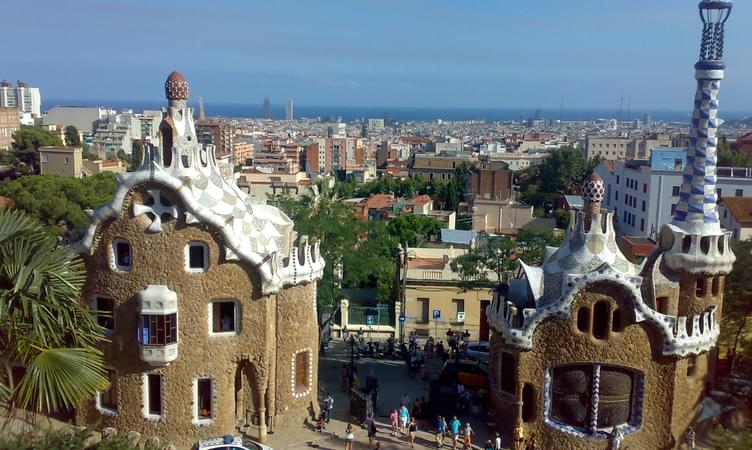
- One of the best activities to do in Spain in February is wandering through the Park Guell and appreciating the whimsical sculptures that are the greatest examples of Catalan modernism.
- Park Guell is known to be architect Antoni Gaudí's most spectacular creation with nature-inspired architecture and colourful mosaics.
- Exploring Park Guell in February is considered the best as most of the area is open, so you won't have to deal with heat waves, unlike the summer months.
- Since February is mostly a dry month, you can explore the attraction without worrying about downpours.

Best of Switzerland

Discover The Casa Vicens
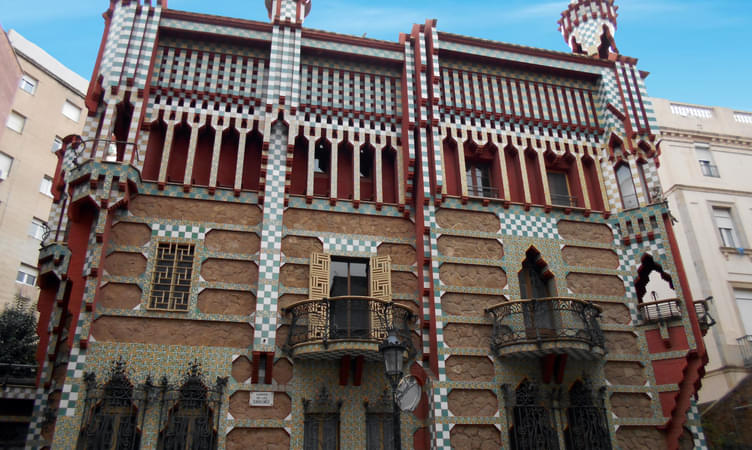
- Brush up on modern architecture history and learn about Antoni Gaudí's most famous work by visiting the Casa Vicens.
- It was Gaudi's first house built for the Vicens family between 1883 and 1885. After one hundred and thirty years of private ownership, it has been converted into a museum.
- You can see Gaudi's signature touches here, including a beautiful roof terrace, painted tiles, and the incorporation of wood, iron, and stone.
- Visit the attraction in February to beat the blazing summer heat and encounter fewer tourists.
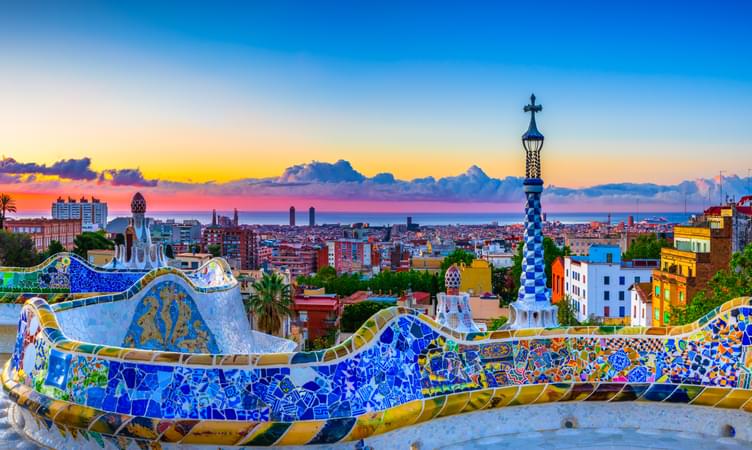
Best of Barcelona

Immerse In The Curves Of Casa Mila

- End your search for the best things to do in Spain in February by visiting the Casa Mila, a remarkable edifice designed by Antoni Gaudí.
- Immerse in the curves of Casa Mila that make it stand out from the other buildings in Barcelona that mostly have a straight layout.
- If you visit the attraction in February, you can enjoy musical performances and attend interesting exhibitions that will leave you awe-struck.

Best of Paris

Step Into The Imaginative World Of Casa Batllo

- The list of best things to do in Spain in February won't be complete if you don't explore Casa Batllo, a living work of art where you can experience Gaudi's artistic brilliance.
- Head into the immersive rooms to gain a deeper understanding of Gaudi's vision and witness the grandeur of the past.
- Stay mesmerised as you see the facade that is sprinkled with bits of green, mauve, and green, representing a riot of colours.
- If you arrive in February at this attraction, you'll beat the tourists rush that swarm the area.
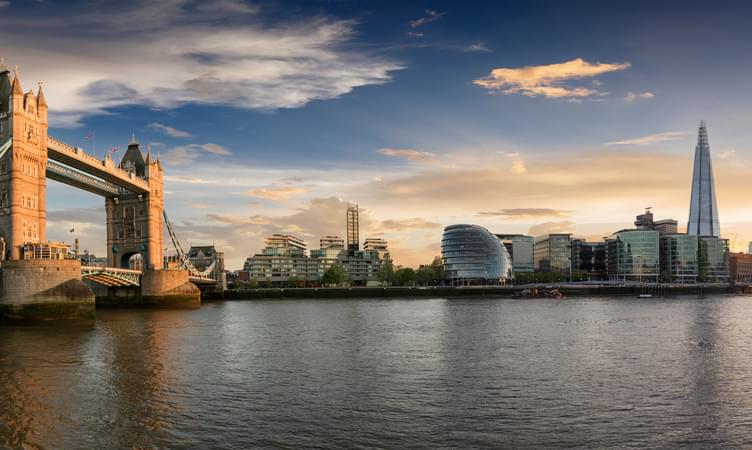
Best of London

Take A Local Food Tour

Best of Sweden

Best of Madrid

Experience The Marine World At Barcelona Aquarium

Best of France

Watch A Flamenco Show

Best of Mykonos

Take A Tour Of Alhambra

People Also Ask About Spain
What are the best activities to do in spain, is february a good time to visit spain, why is spain so famous, how to reach spain, how many days are enough to explore spain.

Spain Top Attractions
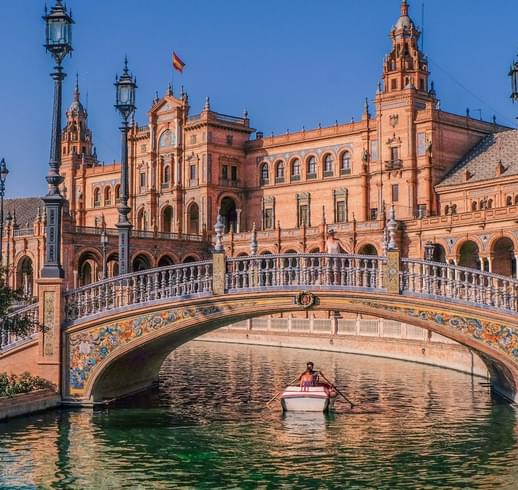
The Alhambra palace, also known as "The Red Palace", is a fortress complex situated in the city center of Granada, Spain. The word "Alhambra" stands for red which has been driven from the Tapia's reddish color used on the palace's outer walls.The monument's building is one of the finest examples of Islamic architecture and a well-preserved palace in the Islamic world. The palace's construction was completed chiefly between 1238 to 1558 during the rule of Ibn al-Aḥmar.Formerly a citadel, Alhambra palace hosts quite an interesting story that you get to explore on your trip to this historical place. The palace is located surrounded by natural beauty, offering a panoramic view to all visitors.It is constructed on a plateau that overlooks the Albayzin Granada's quarter. Alhambra was once the home of all Moorish Kings; it had now been transformed into a famous palace visited by thousands of history buffs all around the year.As you walk by the palace, get in awe of all the vibrant flowers and massive fountains all around. On your tour of Alhambra, observe its intricate architectural design and details, making it the most sought-after destination in Alhambra.You can Checkout: Alhambra Tickets Online

The San Nícolas Church was built on the site of a former mosque, of which only the cistern remains. Together with the church of San Cristóbal, it is the oldest of the Mudejar churches in Granada which was destroyed during the civil war and was restored very recently. San Nícolas Church is one of the most important religious buildings in Granada and is a fine example of Gothic architecture.One of the most notable features of San Nícolas Church is its large nave, which is illuminated by a series of stained glass windows. The nave is flanked by two rows of columns that support a high barrel vault ceiling. At the far end of the nave is the choir loft, which houses a large organ.The church also contains a number of tombs and monuments, including those of Fernando de Valor, Juan de Padilla, and Francisco Pacheco. Visitors can admire the stunning architecture, enjoy the peaceful atmosphere, and learn about the history of this important religious site.If you are planning a trip to Granada, then Checkout: Granada Tour Packages

The Cathedral of the Incarnation popularly known as Catedral de Granada is a famous Roman Catholic Church in the heart of Granada city. Unlike many Cathedrals in Granada, the construction of this structure did not start until the 16th century. Whereas its foundation was laid somewhere between 1523 to 1708 as this church is one of the prime examples of Baroque architecture, Renaissance architecture, and Plateresque architecture.Some prime architects involved in its construction include Diego Siloe, Felipe Bigarny, Enrique de Egas and Juan Gil de Hontañón. The facade of Catedral de Granada was completely different from the general standards of the Baroque architecture style.Alonso Cano, a famous architect in Catedral de Granada, was more sympathetic towards the Classic style. He decided to follow the same architectural style as the rest of the Catedral. The place features a rectangular base of its five naves. All these are staggered in height, with the central one being the largest.There are two towers located at the foot of the Cathedral. The facade consists of three pillars with semicircular arches, the same as San Andrés de Mantua of Leon Battista Alberti. The facade also features a bell tower which offers an incredible view to all tourists.Click Here to Book: Catedral de Granada Tickets
More Spain Attractions
Spain travel guides.
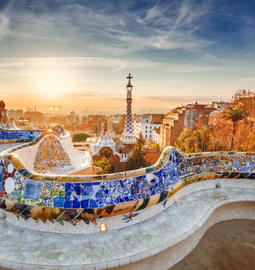
Spain Reviews

Popular Nearby Places Around Spain
More things to do in spain, more on spain tourism, popular related destinations.

Best Domestic Packages
Best international packages, domestic honeymoon packages, international honeymoon packages, places to visit in india, international places to visit, things to do in india, international things to do, popular on thrillophilia.
- We assure the privacy of your contact data.
- This data will only be used by our team to contact you and no other purposes.
Your enquiry has been received successfully. Our destination expert will reach out to you soon!

Carnival, Sun and Surrealism: The Magic of Spain in February
Forget hunkering down against winter’s chill. As February unfolds with its frisky festivals and lively celebrations, Spain cranks up the heat. From sizzling carnivals to temperate coastal towns, this sunny European escape swaps snow boots for sandals.

If you’re suffering from winter fatigue or post-holiday blues, Spain provides the antidote. Festive parades offer technicolor relief to gray skies while tapas trails lead you from one party to the next. Whether you seek snow-capped mountain vistas or island adventures under azure skies, vigor and joy abound in this midwinter playground.
So spark your wanderlust, pack your bags and come fiesta! As vibrant Spain shakes off its holiday slumber, now is the perfect time for revelry, rejuvenation and the country’s most riveting events. From elaborate processions to frenetic festivities, discover why February flings open Spain’s doors for a feast of fun.
Check out my Spain in February Guide.
Photo by Blanche Peulot on Unsplash
Table of Contents
Is february a good month to visit spain.
As the new year unfolds across Spain each February, a powerful antidote to winter awaits. While much of Europe remains mired in post-holiday doldrums or in the icy grip of winter, Spain springs to life with carnivals, festivals, temperate coastal escapes and an irresistible joie de vivre.
So, as you plan for next year’s getaway, consider this: Is February a good month to visit Spain?
The unequivocal answer is sí! February offers intrepid travelers an insider’s portal into authentic Spanish culture, free from the usual summer crowds and tour bus hordes. With far fewer visitors, you’ll enjoy unhurried visits to architectural marvels like La Sagrada Familia, last-minute restaurant reservations at Michelin-rated eateries, and effortless access to Spain’s renowned nightlife playgrounds.
What’s the weather Like in Spain in February?
While Northern European locales remain bundled under grey skies and freezing temps, Spain boasts a diverse climate perfect for February visitors.
In Spanish mountain regions like the Pyrenees, Sierra Nevada, and Galicia’s peaks, snow adventures abound with prime ski and snowboard conditions. Descend powdery slopes by day, then warm your bones at night with hearty stews, ripe Rioja wines, and chestnuts roasted over crackling fires.

Meanwhile, Southern and Mediterranean Spain offer a tempting preview of spring. Spend balmy afternoons exploring Moorish palaces in Andalusia, then delight in sunset flamenco shows. Or discover why the Costa del Sol remains an off-season favorite among sun-seekers and snowbirds alike.
So whether you crave winter wonderlands or just some vitamin D, Spain’s varied February weather offers the best of both worlds.
- Madrid: Crisp and cool with occasional sunny days, 3°C – 12°C.
- Barcelona: Mild with a mix of sun and rain, 8°C – 15°C.
- Seville: Pleasantly mild and one of the warmer cities, 8°C – 18°C.
- Valencia: Generally mild with a higher chance of rain, 8°C – 17°C.
Photo by Vlad Hilitanu on Unsplash
Is February a Rainy Month in Spain?
February can bring rain, especially in the north and along the Mediterranean coast. However, it’s usually not enough to dampen your travel plans. The rain often comes in short bursts, leaving plenty of clear, crisp days to enjoy.
Also, check out Spain with Kids.
The Best Parts of Spain to Visit in February
As one of Europe’s most diverse countries, Spain offers a wide range of destinations to match your February travel style. The Canary Islands are your best bet for warmth in February. Places like Tenerife and Gran Canaria enjoy a subtropical climate with temperatures often between 18°C to 24°C. It’s a perfect winter escape for beach lovers and sun seekers.
Revel in Northern Spain’s Cultural Treasures

In spirited cities like San Sebastian and Santiago de Compostela, beat winter’s chill by ducking into captivating museums highlighting regional history, food, and artisanship. Spend nights sampling Basque pintxos bars or Asturian cider houses laden with fabada stews and sheep’s milk cheeses.
Photo by Sebastian Pichler on Unsplash
Under Azure Skies in Southern Spain
From the Moorish grandeur of Andalucian cities to the tiny whitewashed villages of Extremadura, February ushers in sunny days perfect for architectural explorations. Don’t miss the vibrant February carnivals across Cádiz, Granada, and beyond, where thrumming flamenco music accompanies elaborate costumed parades.
Discover Crowd-Free Gems on the Mediterranean Coast
The cultural cornucopia of Barcelona dazzles free of summer visitors in February. Nearby, districts like Valencia and Catalonia enchant with modernista architecture set against golden beaches and emerald rice paddies alive with birdlife.
Savor Central Spain’s Dynamic Offerings
As Madrid shakes off its winter slumber, discover Old World cafes, tapas trails highlighting regional flavors, landmark museums like the Prado and Reina Sofia, and Spain’s epic nightlife in full swing. Nearby university towns like Salamanca and Segovia envelop visitors in rich history and youthful energy.
No matter your interests, Spain rewards February travelers with an utterly unique European mashup of experiences, cultures, cuisines and climates at this shoulder season sweet spot.
How Many Days to Spend in Spain in February
Plan for at least 10 to 14 days in February to truly appreciate Spain’s variety. This will give you enough time to soak in the cultural vibrancy of cities, experience the festivals, and perhaps even escape to the warmer Canary Islands for a few days.
Also check out Spain in March.
February Festivities and Events in Spain
February is alive with cultural festivities:
- Carnival: Witness the colorful parades and costumes, especially vibrant in Tenerife and Cadiz.
- Almond Blossom: Experience the mesmerizing almond blossom in regions like Mallorca and Ibiza.
- Valentine’s Day: Explore romantic spots and special events across cities.

Spain Carnival 2024
The best and most famous Carnival celebration in Spain takes place in Santa Cruz de Tenerife on the Canary Islands. In 2024, the Santa Cruz de Tenerife Carnival dates are:
February 10th – Opening Parade February 16th-19th – Main Carnival Parades February 25th – Burial of the Sardine
The Carnival in Santa Cruz de Tenerife is one of the biggest and wildest in the world. It features over a week and a half of elaborate costumes and floats, music, food, concerts, dances, parades, contests, fireworks, and all-night revelry in the streets.
Some key events that make this Carnival famous include:
- The opening parade featuring the Carnival Queen
- The High Heels Marathon where men race in outrageous high heel shoes
- The impressive Grand Parade with floats and performers
- The Burial of the Sardine finale wrapping up the festivities
Over a million people attend the Santa Cruz de Tenerife Carnival each year. The warm Canary Island climate, Spanish hospitality, and party atmosphere make it an unforgettable destination for Carnival. Hotel rates and availability fill up quickly each year for one of Spain’s peak events.

Photo by Llanydd Lloyd on Unsplash
In February 2024, several vibrant and diverse Carnival celebrations will take place in Spain. Some of the notable events include:
- Sitges Carnival : Scheduled from 8 to 14 February, the Sitges Carnival is known for its Fat Sunday and Shrove Tuesday parades, featuring over 50 floats and around 3,000 participants dressed in extravagant costumes. The carnival also involves a mock funeral procession to “bury” a cardboard sardine, symbolizing the end of the festival and a return to the abstinence of Lent.
- Carnival of Herencia : Taking place on 10 February 2024, the Carnival of Herencia in Castilla-La Mancha is a two-week-long festival filled with colorful and vibrant festivities, including costume contests and pasacalles parades. The carnival features various traditional characters and guild representations, adding to its unique identity.
- Madrid Carnival : The 2024 celebrations will occur from 10th to 14th February, featuring a Carnival Parade, the Burial of the Sardine, and various themed activities for all ages. The heart of the festivities has been at Matadero Madrid and Madrid Río Park in recent years, where local traditions are mixed with Ibero-American influences.
- Barcelona Carnival : From 8 to 14 February 2024, Barcelona will host its Carnival, known as Carnestoltes. The city’s celebrations include street parades through different neighborhoods, with each area having its own events and celebrations.
Barcelona in February
How warm is barcelona in february.
Sights: Marvel at Gaudi’s surreal architecture with shorter lines at landmarks like Sagrada Familia, Casa Batlló, and Park Güell. Wander and explore narrow medieval streets in the historic Barri Gotic. Appreciate masterpieces from Spain’s top artists at museums like the Picasso Museum and MNAC.
Cuisine: Treat your tastebuds to authentic tapas and plates like patatas bravas, paella, jamon, seafood, and cheeses. You can find upscale dining or casual bars perfect for hopping between. Don’t miss sampling Catalan cuisine standouts like escargots, fideua, and crema catalana.
Outdoor Activities: Embrace sunny days by visiting Mount Tibidabo for gorgeous panoramas. Stroll the lively harborfront La Barceloneta, host of Barcelona’s Carnaval del Poblenou in February. Cycle for miles on designated paths or hike in nearby parks and mountains.

Nightlife and Shopping: Lose yourself in Barcelona’s legendary nightlife from intimate flamenco tablaos to underground dance clubs bumping music late into the night. Trendy shops on avenues like Portal de l’Angel await to revitalize your fashion with Spanish styling.
A Barcelona visit in February lets you soak up all the Catalan capital’s magic with thinner crowds, milder weather, and buzzing local energy at carnivals and ongoing celebrations as spring slowly edges closer.
Madrid in February
Madrid shakes off winter’s chill in February while avoiding the summer tourist mobs, making it a delightful time to visit Spain’s lively capital. Average temperatures range from 5-13°C (41-55°F) – cool enough for a jacket, yet mild enough to explore. Discover what the city has to offer:
Sights: Admire works by Velázquez, Goya, and more at the sprawling Prado Museum. See Guernica and avant-garde art at the Reina Sofía. Explore monumental squares like the stately Plaza Mayor and the lively Puerta del Sol.
Cuisine: Feast on Madrid’s divine cuisine from savory tapas to hearty stews and exquisite plates of jamon Iberico. Visit the historic Mercado de San Miguel to graze and sample local delicacies. Make reservations at one of many Michelin-starred restaurants.

Culture: Revel in electric nightlife throughout neighborhoods like Chueca and Malasaña as Madrileños don’t let winter dim their passion for revelry. Attend a fiery flamenco performance or catch live music in vintage jazz bars.
Outdoors: Stroll or cycle through the bucolic Retiro Park. Seek majestic mountain views in the Sierra de Guadarrama or Sierra del Rincon, enjoying snow sports less than an hour’s drive from Madrid proper.
Getting to know Madrid in February offers insider opportunities to mingle with locals, visit top sites sans oppressive heat or crowds, and embrace the city’s vibrant offerings at peak form before spring returns.
Check out Unique things to do in Madrid. and Driving in Spain .
Similar Posts

The Ultimate Guide to Ischia Beaches + Heated Thermal Pools
The 411 on Driving In Italy

5 Off The Beaten Path Beach Cities in Portugal

5 Days in Sicily Guide

Your Ultimate Guide to Visiting Portugal in February

The Best Family-Friendly Hotels in Venice
Road is Calling
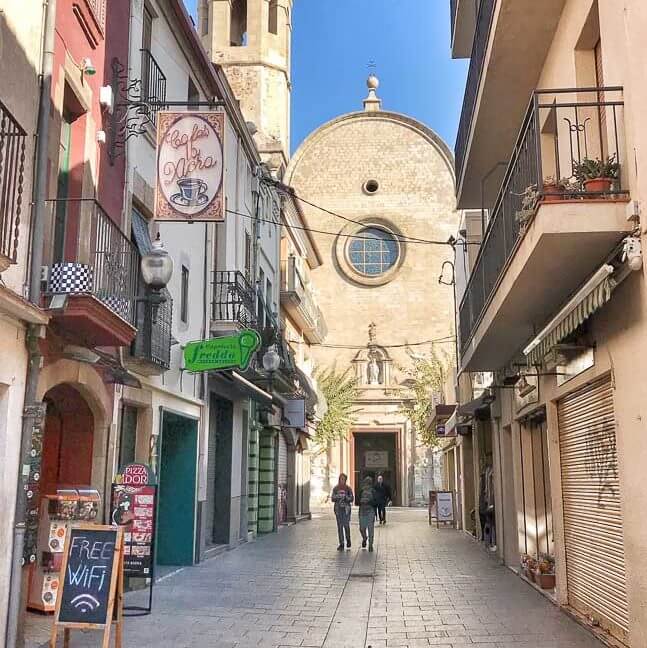
Visiting Spain in Winter: What to Know, Why to Go & What to Expect?
Last year, at the end of November, we spontaneously made a plan to visit Spain during the winter. The reason for that was cheap flights to Barcelona and very affordable car rental (like $18 for two weeks, it was too tempting.) So we quickly packed and went. And honestly, it turned out to be the best decision we made.
In December, we visited Catalonia, Valencia , and Murcia and thought it was a perfect time for Spain. Then we went on a road trip from Barcelona to Valencia and in February, rented a flat in Santander, Cantabria, moving there for some time. We traveled all over the Northern Coast and also thought it was the best time to be there. No crowds, peace, and quiet almost everywhere with significantly lower prices.
Costa Brava’s nature and coast reminded us so much of Southern California where we used to live for almost four years. Amazing beaches of Cantabria in winter reminded of Oregon in the summertime . It was great and we loved every single day there.
This year we will be visiting again, and again during the winter. We feel that we don’t really want to go during any other season, just loved it so much.
So this is why I wanted to write this post and share about my experience of traveling around Spain during the winter season. It will surely help you understand if this is a good time of the year to travel for you personally.
What’s the weather like in Spain in winter?
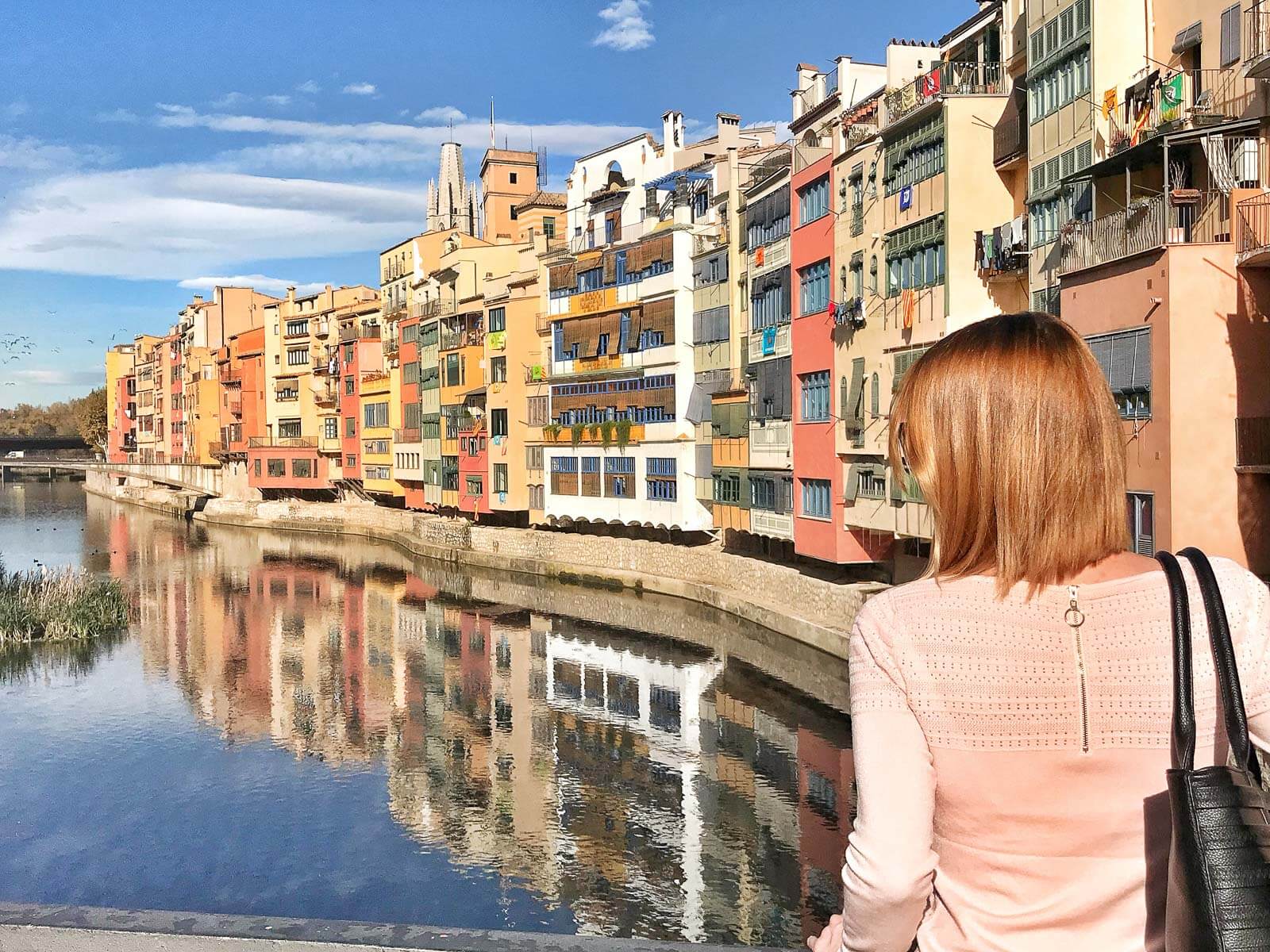
So what’s the weather like in Spain in winter?
The climate in Spain is considered to be one of the mildest and warmest among European countries. Winter is not an exception here. However, the temperature depends largely on the region of the country and the proximity of the mountains or the sea.
In mountainous regions, for example, the temperatures in winter get below zero. So if you are up for skiing , there will be plenty of snow in the mountains.
The northern part of Spain, particularly the provinces of Galicia, Asturias, Cantabria, the Basque Country, and Navarre usually get quite a lot of rain during the winter and get chilly.
As for the coast, the average daytime temperature in winter is about 15 degrees Celcius (60 Fahrenheit.) The weather in Catalonia and Costa Brava regions is usually sunny with little precipitation. By mid-January though, the number of cloudy days increases.
In January and February, the air temperature in Spain gradually decreases. However, in the Canary Islands, it is still warm – above 20 degrees Celsius.
Overall, the weather in Spain in winter contributes to a comfortable journey throughout the country. Below is a detailed description of the weather each month.
Weather in Spain in December
For someone who comes from the North, the weather in Spain in December does not look like winter at all. At the same time, it is not really summer. The main climatic difference of this month is gusty winds, an increased level of humidity, and a decrease in daily temperatures.
Especially noticeable it is in the coastal zones of the country which are open to the sea. In the northeast of Spain, in Catalonia , it gets quite cold. For example, in the Costa Brava region , the average temperature is +13 degrees C during the day and +6 degrees C at night. In Barcelona, during daylight hours, the temperature is almost the same. The nights though are somewhat warmer with a temperature of +8 degrees C.
However, Costa Dorada , which is a bit more to the south, experiences more comfortable weather due to its protection from cyclones by the chain of mountain systems of the Pyrenees and Cordillera. On this stretch of coast in December there is an average of 11-12 rainy days. So the weather may feel a little cooler than it actually is.
When planning your trip here , you should definitely pack a pair of good waterproof shoes and windproof outerwear . Taking into account the fact that storms take place too and precipitation can be very intense, a raincoat will be very useful as well. Umbrellas don’t often withstand the pressure of the wind, so not sure how useful they will be.
The southern regions of the country are experiencing better weather conditions in terms of temperature. So, in Costa del Sol , between Gibraltar and Malaga, the maximum temperature usually reaches +17 degrees C. At night it is about +9 degrees C. However, do not rely on dry weather here. It can rain for 50% of the time.
Madrid , located on a hill, during the entire winter season experiences rather cold weather, with temperature dips during the day. When leaving your hotel early in the morning, put on some warm clothes. At this time of the day, the thermometer can barely reach +5 degrees C.
In the afternoon, the air warms up to +9 degrees C. However, when the humidity is high and it’s cloudy, long walks around the city are really unpleasant. There is no snow in the capital, but the northern mountain regions not far from Madrid see a lot of it.
Cities along the northern coast of Spain experience moderately cold weather. For example, in Santander, the daily temperature is between +8 + 13 degrees C, and in San Sebastian +6 + 8.
The Balearic Islands in December are significantly colder than the Mediterranean ones of the Andalusia region. So, in Ibiza and Formentera , the daily temperature ranges between +9 + 16 degrees C, in Mallorca +7 + 15, and in Menorca it’s slightly cooler during the day and +8 + 14 at night.
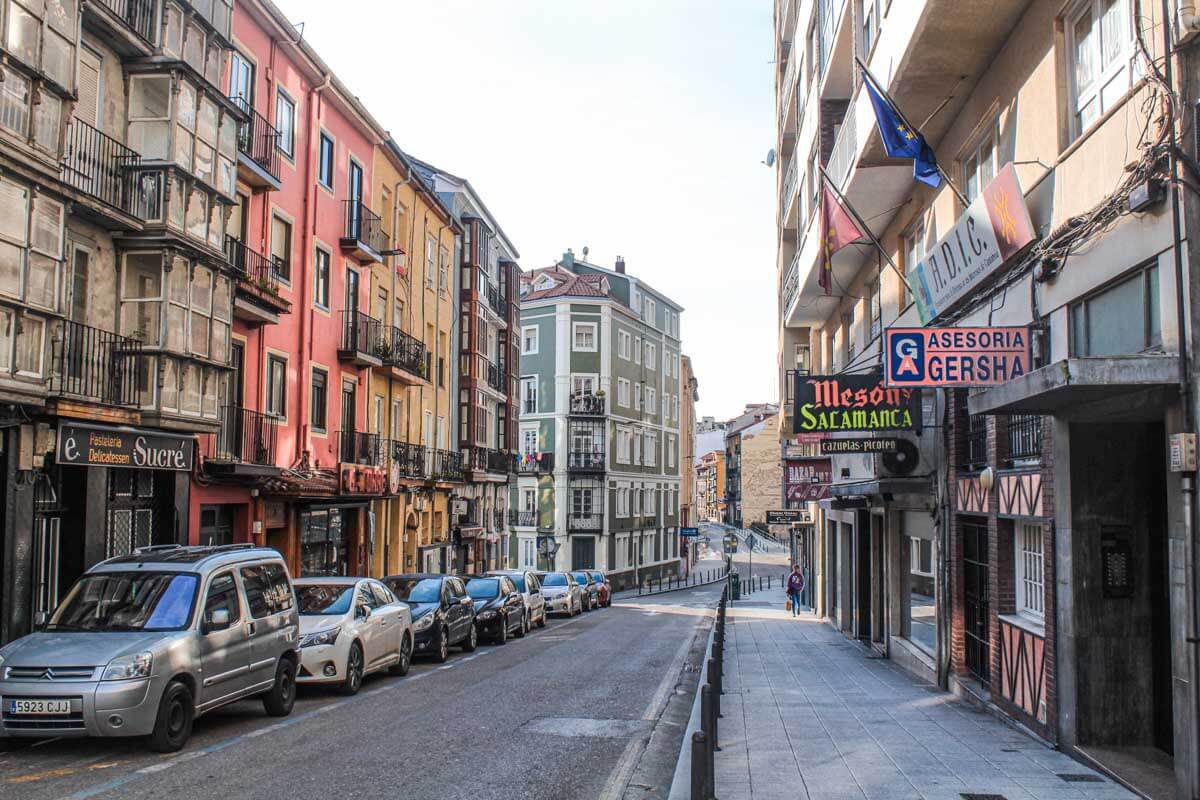
Weather in Spain in January
Madrid in january.
January weather in Madrid can be extremely unpredictable – from severely cold to surprisingly mild. In general, however, you can expect it to be cold. This is the coldest month of the year in the city.
You may need an umbrella during this time of the year. The average maximum temperature in Madrid in January is 11 degrees C, and the average minimum temperature is 0.
Weather in Barcelona in January
If you don’t know that yet, there is a beach in Barcelona. But you won’t find anyone there in January. Because the whole month is usually pretty cold and windy, although it stays pretty dry.
The average maximum temperature in Barcelona in January is 13 degrees C, and the average minimum temperature is 4 C.
Weather in Andalusia in January
The coldest month in Spain brings some cold even to the warmest region. Hot, warm days are, of course, possible, but don’t expect to return home with a tan as you’ve been to the Caribbean. The average maximum temperature in Malaga in January, for instance, is 16 degrees. And the average minimum temperature is 7 degrees.
Weather in Northern Spain in January
The north of Spain in January sees a lot of cold, gloomy, and wet days. It will be very rainy, so you will definitely need a jacket, especially at night. The average maximum temperature in Bilbao in January is 13 degrees C, and the average minimum temperature is 6 degrees C.
Weather in North-West Spain in January
Being incredibly wet, Galicia escaped some of the cold weather experienced in the rest of Spain in January. The average maximum temperature in Santiago de Compostela in January is 13 degrees C, and the average minimum temperature is 8 C.
Best places to go in Spain in winter if…
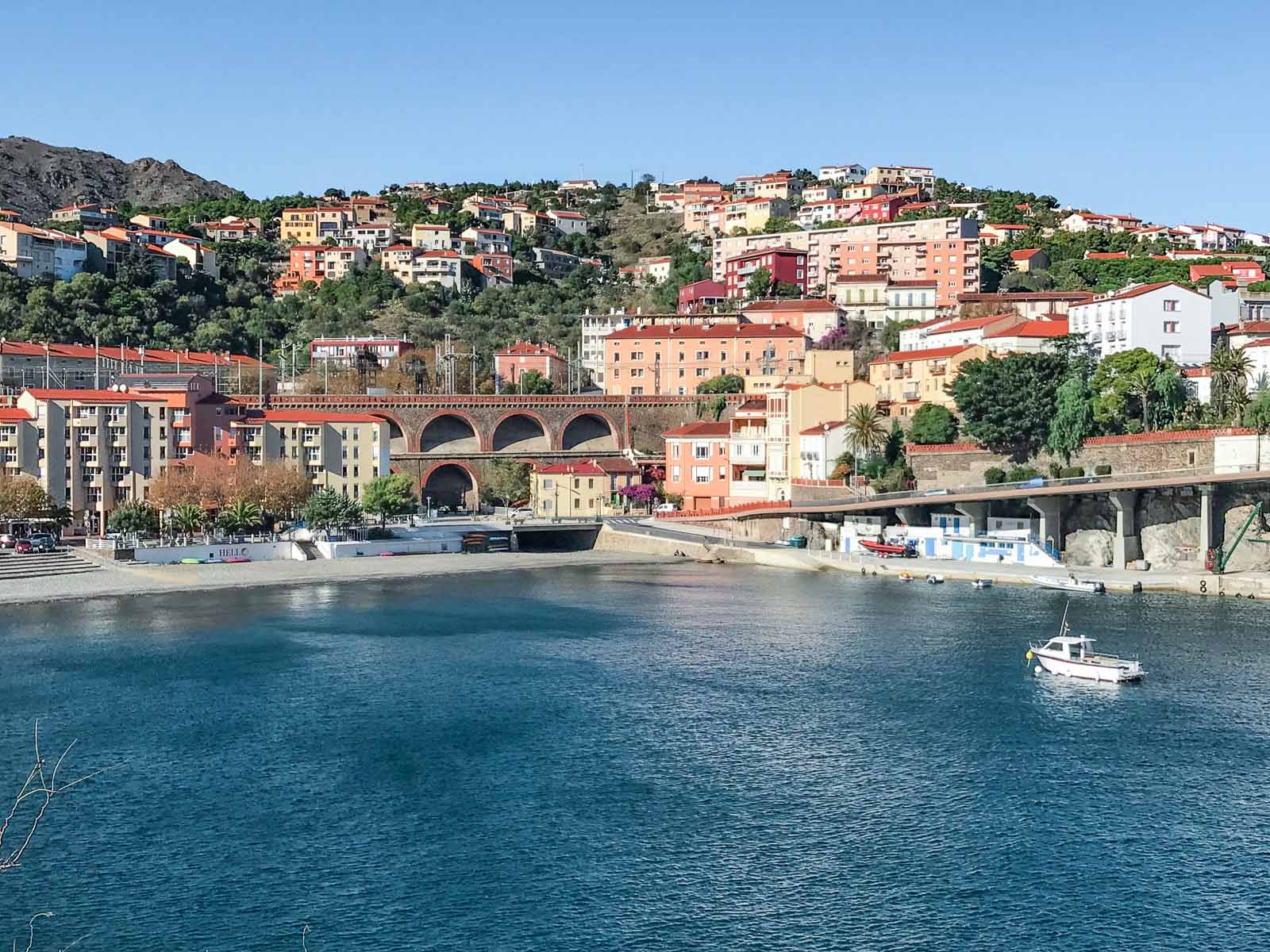
From my experience, Spain is one of those few European destinations where winters are fun. No matter which part of the country you go to, there is always something exciting to do and the weather is always nice. Any time during the winter is a good time to visit Spain.
An answer to this question though depends on what your preferences are. But I personally feel that Spain has activities for any taste and budget.
Here are some ideas on what to do and where to go:
… if you love winter sports
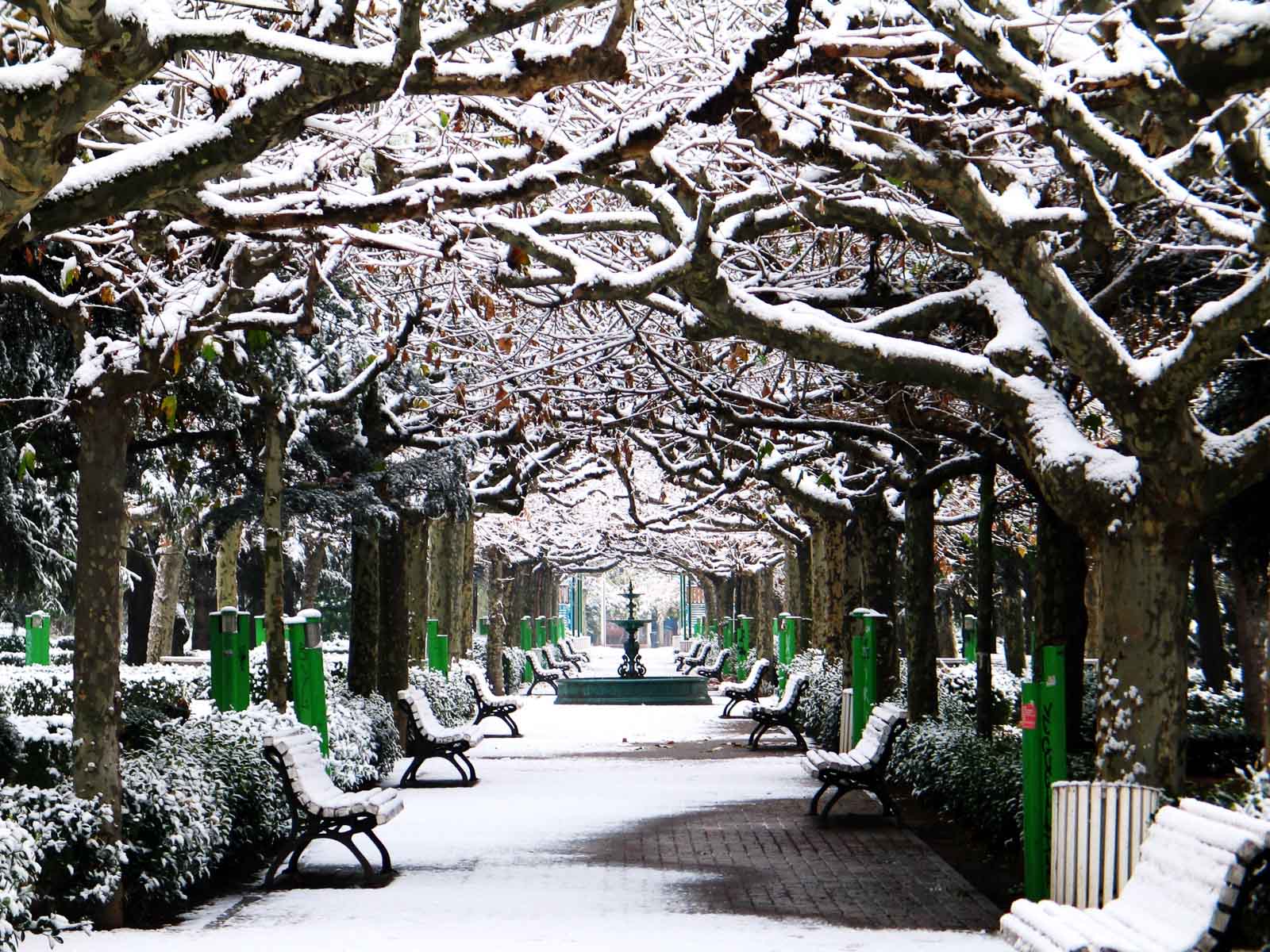
Spain is second only to Switzerland in the number of mountain peaks in Europe. It is a few times cheaper than Switzerland but the quality of ski resorts is excellent and suits even the most fastidious tourists.
So if you are looking to spend a few days during your holidays somewhere in the mountains, look no further. There are endless opportunities to do that in Spain.
In wintertime, almost every Spaniard goes to the mountains at least once. If you do too, you won’t be disappointed. Magnificent ski trails and high-class service, combined with the extraordinary beauty of the scenery – this is what Spain is famous for.
Spain has more than 30 ski resorts. The largest and the most popular one in the country is Formigal , located in the Western Pyrenees . Either you are a beginner or a professional, you’ll feel comfortable there.
Another popular winter holiday destination is the Sierra Nevada , the southernmost ski resort in Europe. Besides developed infrastructure, long tracks, high lifts, lots of cafes, and areas for rest, it has an excellent location. It is uniquely located in a natural reserve, at the foot of the city of Granada . On a sunny day, from the top of the mountain, you can see the Mediterranean Sea and even the coast of Morocco .
Take a look at this list of all ski resorts in Spain for detailed information.
… if you are craving the beach, sea, and breeze
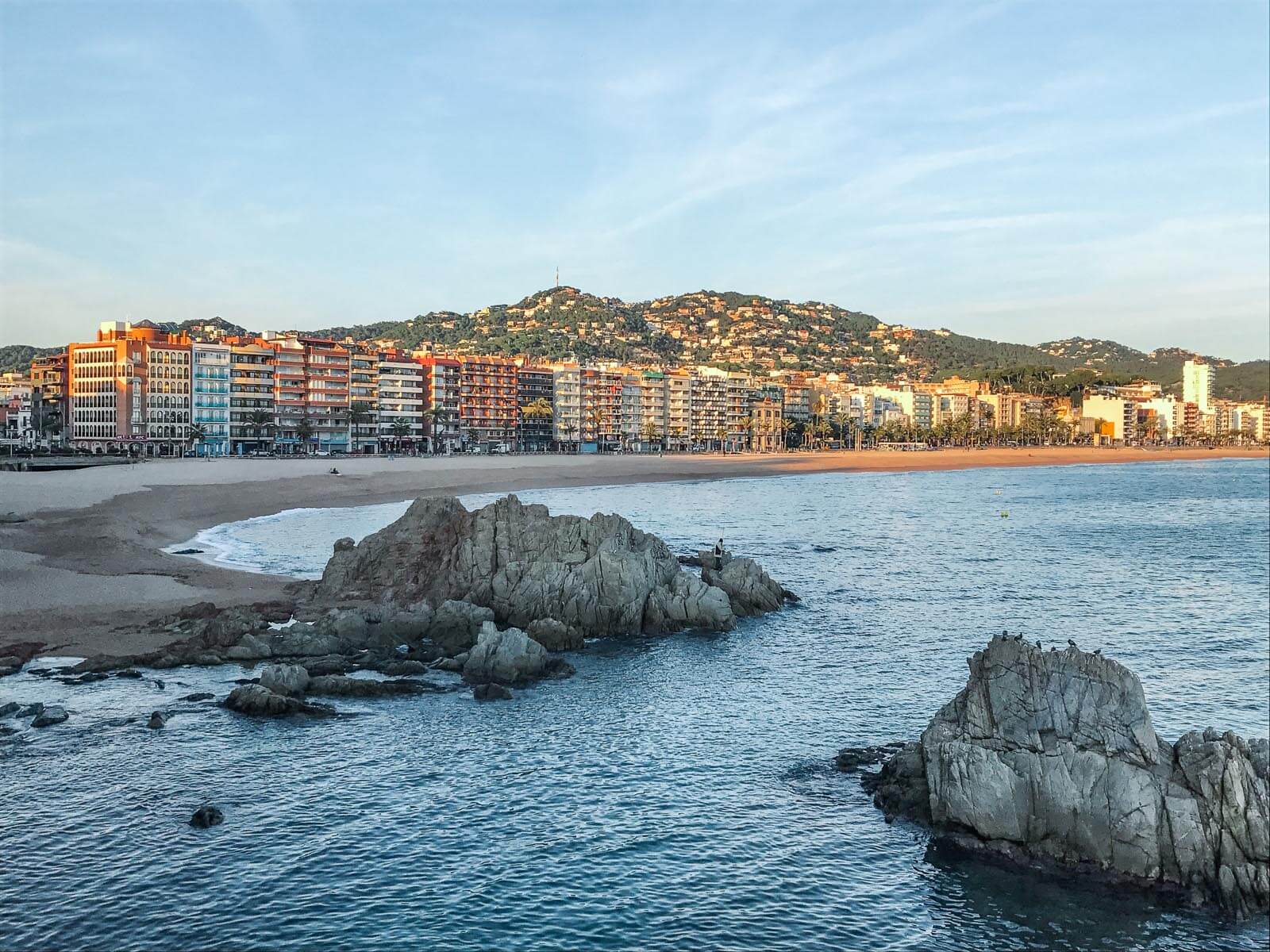
Spain in winter is a perfect destination for those who are looking to escape the cold.
The temperature allows you to relax on the beach under the warm sun, and the resorts in many parts of the country have a lot to offer.
Winter Sun in the Andalusia Region
The southern coast of Spain Andalusia has a unique climate. The mountain range protects this area from cold air currents, and its excellent geographical position keeps air temperature at 20C degrees or higher. At the same time, the water temperature doesn’t go below 16C degrees.
One of the best resort towns to visit in Andalusia in winter is Marbella . On one side, the city is surrounded by a mountain range, and on the other, by the seaside of Costa del Sol . Almost all 365 days a year in Marbella are sunny. In addition to the amazing climate, the city is known for its developed infrastructure and many historical attractions.
The port city Malaga is another beautiful resort town in Spain that offers winter sun activities. The weather forecast every day of the year shows sunny weather with no precipitation.
Two more beautiful cities on different sides of Malaga that beckon travelers in winter are Cadiz and Almeria . In my opinion, the south of Spain in winter is more attractive than in summer. Summers are just so hot, nature looks dry and tired. But winter is that season when nature wakes up to life.
Spanish Islands for Winter Escape
Another place you can associate with eternal summer and winter getaways is the Canary Islands . It deservedly attracts many tourists from different countries since it is pleasantly warm year-round. The thermometer mark does not fall below +25C degrees (77 Fahrenheit) while the water stays 20-22 degrees warm.
The southern coast of Tenerife , Gran Canaria, or the island of Palma guarantee sun and warmth every winter day. North of Tenerife what feels like eternal spring is also a wonderful destination for winter warmth. The amazing landscape with mountain volcanoes and sand dunes makes this part of Spain one of the best destinations in Europe.
Eastern islands of Lanzarote and Fuerteventura (which are only 100 kilometers away from the African continent) are even warmer. There, north or south are equally warm. On these islands, you’ll find pyramids , just like in Egypt. They are not as high as in Egypt but built at the same time and on the same principle as the famous Great Pyramid of Giza.
|| RELATED POST ||
NORTHERN COAST OF SPAIN – WHAT MAKES IT SO SPECIAL?
… if you love shopping
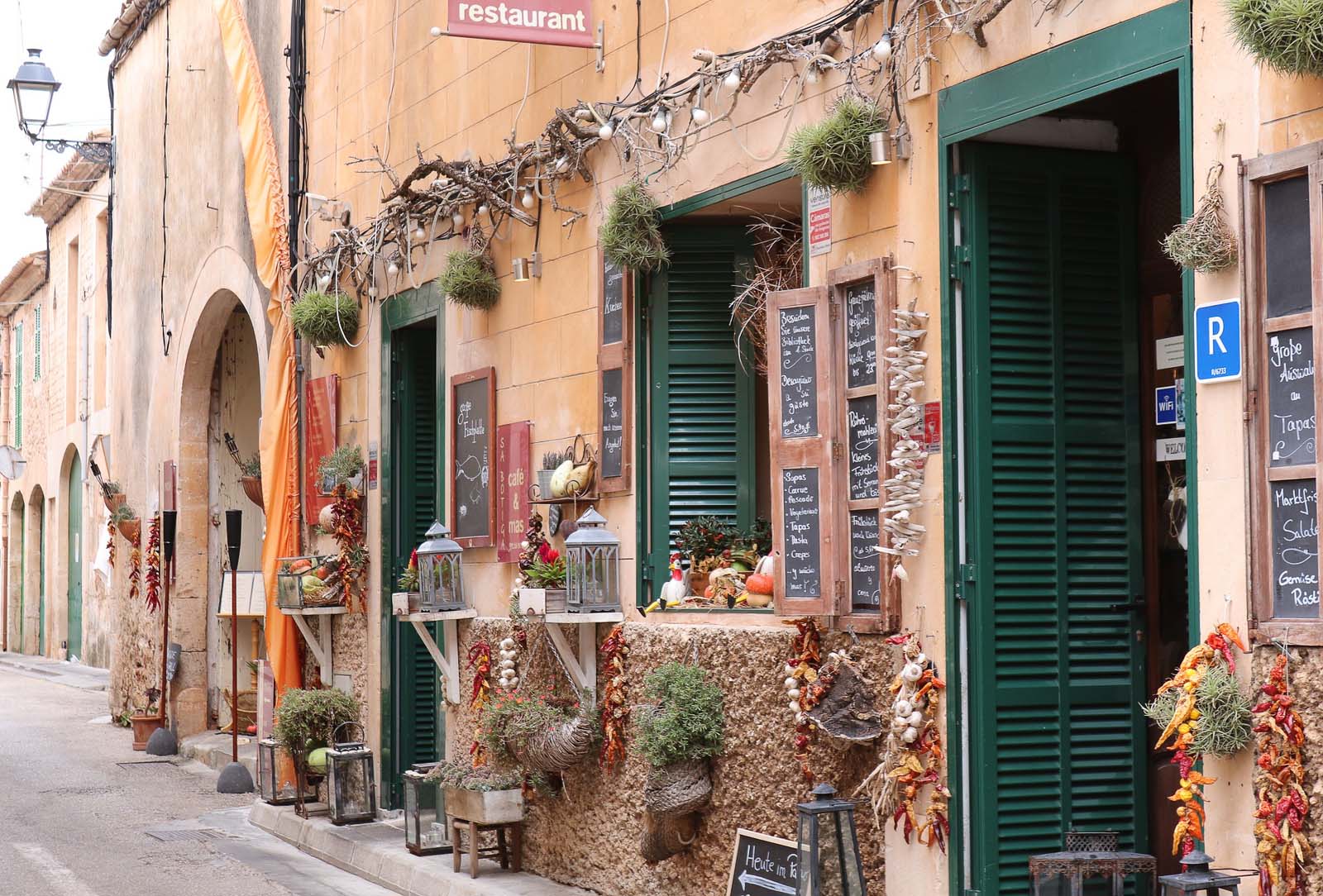
Shopping in Spain in winter is incredibly profitable due to countless sales and discounts.
Sales usually start on January 7th and last until March 6th. At this time of the year, prices for branded items and equipment get cheaper by 90 percent. Of course, if you are looking to buy something from a well-known designer, expect to pay a considerable amount of money. But in Spain, it costs a few times less than let’s say in Paris, Milan or New York.
Barcelona is the best city for shopping. There are tens of thousands of shops, boutiques, malls, and outlets in Barcelona and on the outskirts.
Through the city center, there is a 5 kilometer long stretch of luxury boutique shops that locals call a “Shopping Line”. It starts at the Columbus Monument on the waterfront and goes all the way to Maria Cristina Square.
Madrid with its upscale neighborhood Salamanca also provides unlimited opportunities for shopper lovers.
… if you’d love to go on a thermal spa vacation
I am absolutely obsessed with hot springs and thermal spas. Over the years, I have been searching for information about the best hot springs around the world and even created my own spreadsheet with hundreds of them, which I regularly update. And, have to tell you that Spain has quite a few amazing thermal spa spots.
For me personally, Spain comes next after Slovakia hot springs, Cyprus mineral spas , and Hungary with its fantastic spa-centers. (Have you been to Budapest yet, by the way? This city has simply amazing thermal baths and hot springs that I also wrote about.)
Thermal springs in Spain are everywhere: in the mountains, forests, and even along the coast. You can opt for hot springs in the wilderness, choose to go to a health resort or one of the hotels that have thermal baths and their own spas.
For example, in Catalonia and Andalusia, more than a hundred hotels offer thalasso , balneo, or thermal spas . To find out which one suits you better, take a look at this post . Not sure what a balneo spa is? Here is another post on balneo therapy that explains it all. Want to know what is thalassotherapy? Read this information on thalassotherapy .
In most cases, spas that offer services use healing waters and it is believed they heal various illnesses. However, Spain also has wine spas where the product, which is usually used internally, is used for preventive purposes. The main treatments in wine spas are bathing, scrubbing and wrapping.
If you happen to travel to Northern Spain, pay a visit to Marques de Riscal Hotel in Rioja . This hotel was the first one with a wine spa in Spain and today is in the top 5 wine spas in the world.
Check prices and availability for Hotel Marqués de Riscal on Booking.com
If travels bring you to the Canary Islands, there you’ll find mainly wellness and spa hotels . In many cases no need to be an overnight guest, you can visit on a day pass, like at Aqua Club Thermal Spa .
… if you are a foodie and gourmet

One of the reasons why so many tourists choose Spain is the famous authentic cuisine. It is very rich and differs a lot from one region to another.
It’s probably impossible to advise the best gastro routes. Everything depends on your personal culinary preferences. But I do advise to get a tour or visit a restaurant that has at least one Michelin star, even if you are not really a foodie. In this case, you’ll discover the best tastes of the country. You’ll get to try ham, paella, the freshest seafood, the finest lamb and mutton, the best Spanish wines and cheeses.
By the way, visiting Spain in winter has another benefit. In winter there are delicacies on the menu that you won’t find during the summer . For example, fresh sea urchins . They are available only from December to April and their caviar, as many people say, works wonders. It is said that it kills cancer cells and increases potency, normalizes blood pressure, and improves the functioning of the heart and blood vessels.
Here are a few ideas for you what tours to take:
- Tapas and wine walking tour in Barcelona. We took the tapas tour and were so happy that wanted to repeat. It includes tapas, wine, tour, guide, being in a small group, and more.
- Tapas half-day tour in Barcelona. Very similar to the previous one but includes other activities.
- Wine and Tapas in Madrid . If you are going to be in Madrid, this is an excellent tour to take.
- Valencia Wine Tasting and Tapas Tour . Valencia food tour that introduces you to a wide selection of traditional foods.
… if you are in search of history and cultural events

Winter in Spain is an ideal time for excursions and trips to historic cities.
Lovers of cultural life, museums, and excursions should visit dynamic Madrid with its famous Prado gallery (in other words the world’s largest museum) or Barcelona which is home to Catalan Modernism. To find the best flamenco in a country , you should visit Seville. To walk through the streets of one of the oldest cities head to Girona .
Other famous tourist routes also pass through Valencia, San Sebastian, Granada, Malaga, and Bilbao.
Spain, along with Italy and China, has the most UNESCO world heritage sites. Santiago de Compostela keeps the third most important Catholic sanctuary in the world. Salamanca has one of the best universities in the world. Avila is a city of churches and monasteries, surrounded by the most ancient and best-preserved fortress wall.
Segovia is the city-museum. Cuenca is famous for its famous hanging houses. Caceres with its old quarters, palaces, and cathedrals look very ancient what draws filmmakers to this area. Toledo – the medieval imperial capital of Spain, the city of three world religions, and the great El Greco. Alcala de Henares, the birthplace of the greatest writer of humanity Miguel de Cervantes, is home to one of the most famous and prestigious universities in Spain.
Where is the warmest place in Spain in winter?
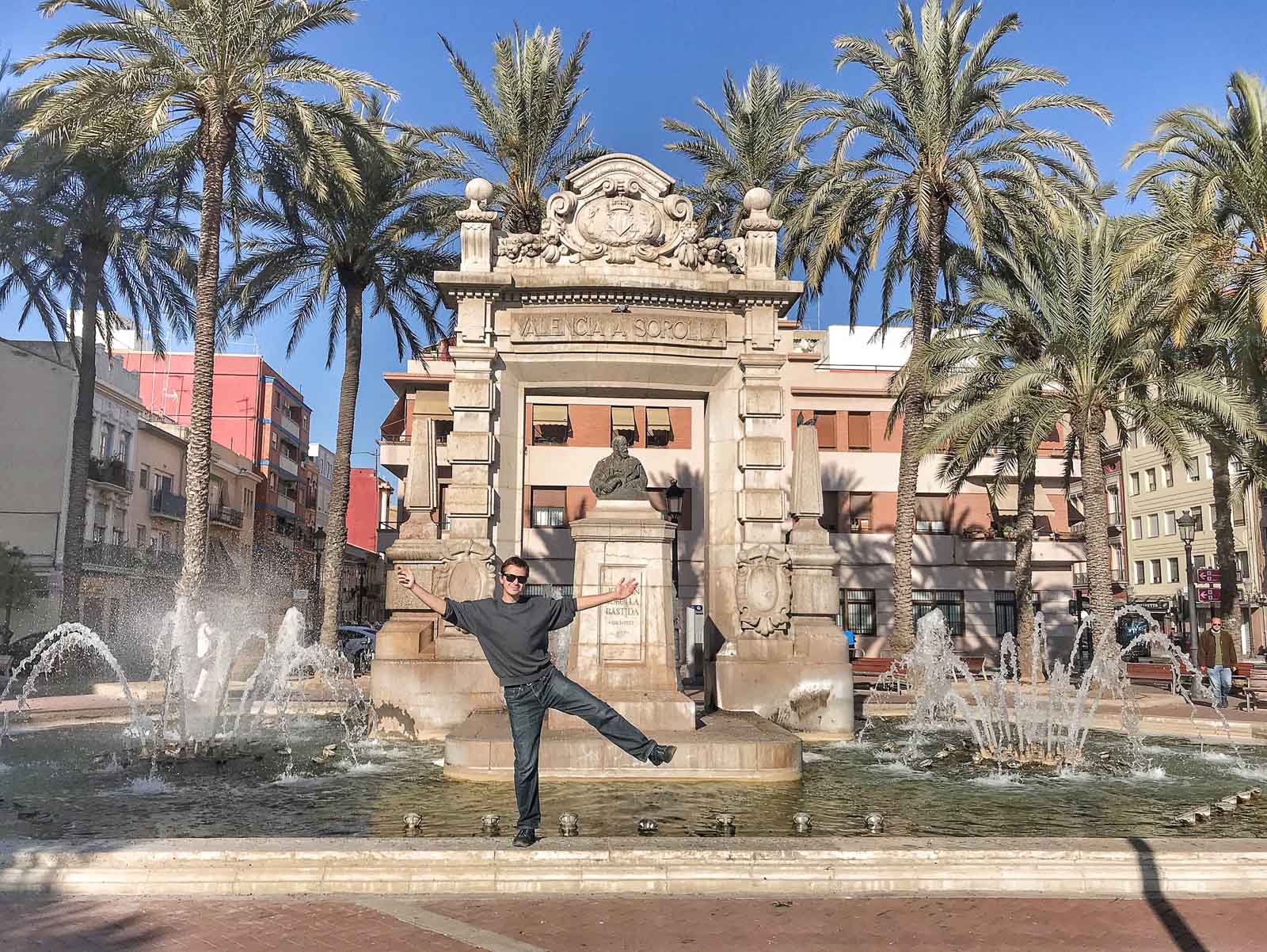
If I had to compare Spain with Canada, most of the U.S. , Northern or Eastern Europe then I would surely say that anywhere in Spain it is pretty warm in winter. Still, it doesn’t automatically mean that Spain is a beach and sun destination.
In case you are wanting to escape not only snow and cold but would actually love to take a dip in the sea then look into the Canary Islands . The temperature in Tenerife is 25 degrees Celsius (77 Fahrenheit) year-round. Besides the sea, there are other numerous activities to do, such as an aqua park , an exotic park of parrots , a world-famous volcano Teide that you can reach by a funicular.
The southern coast of the Andalusia region has really warm winters too. The mountain range protects this area from the cold air currents, and its excellent geographical position provides at least 20C of air temperature and at least 16C of sea temperature.
Marbella is one of the best resort towns with almost 365 sunny and warm days. On the one side, there are mountains, on the other, there is a beach. In addition to the amazing climate and nature, the city is known for its developed infrastructure and many historical sites. And then Malaga with the warmest weather located nearby. The forecast reports almost every day show sunny weather.
Cadiz and Almeria are two other warmest towns in Andalusia.
What to Expect From Barcelona in Winter
If you plan to visit Barcelona in winter, you can definitely expect it to be free of crowds of tourists. Embankments and beaches that are equipped with excellent playgrounds, interesting rope swings, cozy cafes, and designated picnic areas are almost empty during each month of this season. Winter is the ideal time of the year for unhurried walks along deserted streets and the sea coast. On warmer days, you can even take off a jacket and hat and go for a walk enjoying the sun.
The seaside air and the sound of the waves fill with calm and give peace of mind. Some travelers choose to go to Barcelona in winter just for the climate and quietness alone.
Also, as I mentioned above with other places, the winter months in Barcelona will appeal to shoppers. All kinds of promotions and sales provide a great opportunity to buy anything you wish from a famous designer with 70% discounts.
Barcelona is impossible to understand without walking along its unusual streets. The ingenious architecture of the famous Gaudi, such as the houses of Mila and Batllo, the famous Sagrada Familia and Park Guell, looks harmoniously with modern buildings and huge entertainment centers.
Sad mimes and mischievous magicians add to the atmosphere in the ancient Square of Catalonia, La Rambla Boulevard, and the Gothic Quarter. Small tourist flow in winter provides an excellent opportunity to enjoy visiting museums and get acquainted with the history of sunny Spain in a relaxed atmosphere .
Fans of noisy parties will enjoy visiting music festivals of various styles. And those who love going to the theater will be amazed at the Gran Theater del Liceu and the National Theater. Symphony concerts, opera, ballet, and live music concerts take place there throughout the winter.

What to Expect From Madrid in Winter
Oh, Madrid, the capital of the great empire, great paintings and literature, the city of famous museums, bullfights, don Juan, and art.
In the summer, unbelievably hot Madrid awash with tourists is not very good for exploring city attractions that are huge in the heart of Spain. But the winter period is ideal for getting to know the city. Of course, on those days when it doesn’t rain non-stop and the wind is not strong.
You can walk along the old streets of Madrid and visit museums without standing up in kilometers long queues. Winter in Madrid is seriously a perfect time for the calm and laid-back atmosphere all over the city.
Reviews about holidays in Madrid in the low season suggest that winter has even more advantages than summer. First of all, as with any other place – fewer tourists. As with Barcelona, in the low tourist season in Madrid, there are few people on the streets, in museums and cafes. Hotels have plenty of availability and lower prices.
Second, it’s all about the weather. In the summer, for instance, it is simply impossible to be outside for a long time. While in the winter, Madrid always has pleasant mild temperatures.
Christmas markets and New Year’s illumination stay on the streets throughout the first week of January, creating a fabulous atmosphere. The sales start on the 7th of January and last all month long. You have the ability to explore the “open-air museum-city” at a slow pace. The main and, perhaps, the only disadvantage of visiting Madrid in the middle of winter is the low temperature. January is considered the coldest month of the year.
I have another very detailed guide to Madrid in winter . Give it a read to understand better what to expect there.
The holiday season, events, and activities in Spain during the winter
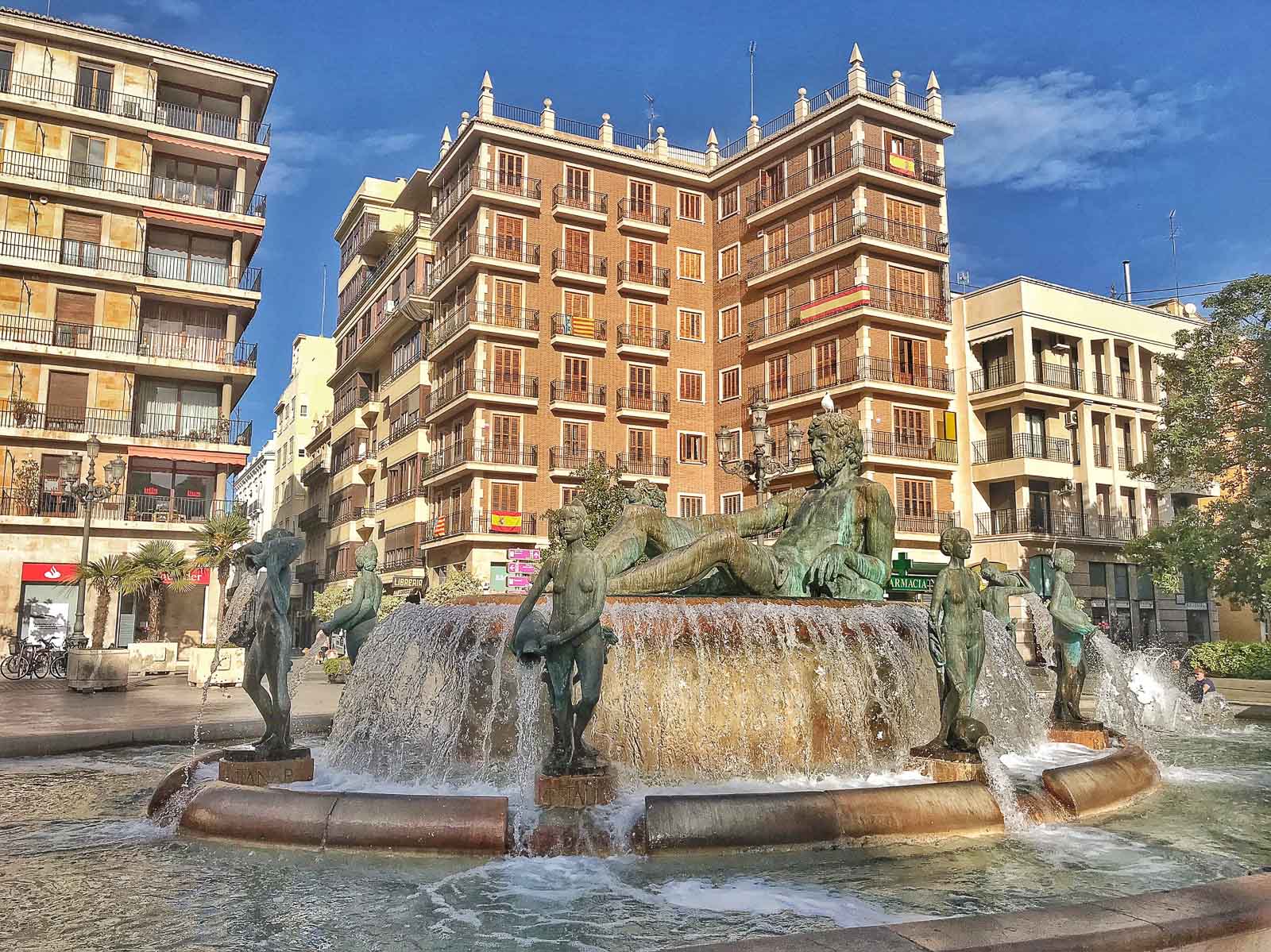
Spain is famous for many different winter holidays and Christmas is just one of them.
Christmas celebrations in Spain starts on December 8th. On this day Spaniards celebrate the day of Immaculate Conception. All big cities and small towns get decorations depicting biblical stories while houses, shops, and bus stops get bright ornaments.
A classical Christmas market is no different from other European destinations. It opens annually in Barcelona on the main square in front of the Cathedral. Also, there are small markets that operate near Sagrada Familia. But they are usually very busy on a regular day and holidays get insanely crowded. Locals in Barcelona like to go to the Plaza del Pi market. Below, you can find more information on Christmas markets in Spain.
Christmas is a very important holiday in Spain. And what’s interesting, each region has its own traditions, cooks different dishes, decorates trees, squares, churches, and streets in its own way.
In Grenada, locals have an unusual tradition of Christmas celebration in a way of bonfires they jump over.
In February, Barcelona hosts a gastronomic festival . Chefs of the best restaurants demonstrate their national cuisine cooking skills. If you are a gourmet, it’s the right time of the year to visit Spain.
From February 27th to March 9th Spanish city Cadiz holds a real carnival. During this time, residents dress up in masquerade costumes and walk the streets. The celebration is accompanied by songs, dancing, and competitions.
THE MOST ESSENTIAL TRAVEL TIPS FOR BARCELONA EVERY TRAVELER SHOULD KNOW
Christmas Markets in Spain
December in Spain is a month of nationwide sales season. Christmas markets open around the entire country. This is a fantastic place for holiday shopping and buying gifts and souvenirs. Christmas markets in Spain open in late November and close in early January. Here are some of the most famous ones:
Christmas Markets in Barcelona
– Fira de Santa Lucia (Fira De Santa Lucia) – the oldest and largest Christmas market in Barcelona.
– Fira de Nadal in La Sagrada Familia (Fira de Nadal a la Sagrada Familia.) The location of this market makes it possible, in addition to shopping, to see the masterpiece of Gaudi and the park.
Christmas Markets in Madrid
– Plaza Mayor has a great selection of Christmas musical instruments and toys.
– Feria-Mercado de Artesanie de la Comunidad de Madrid specializes in local products, ceramics, and jewelry. All of them were designed and manufactured by more than 180 artisan workshops.
Christmas Markets in Seville
– Mercado Navideño de Artesanía de Sevilla – the fair is dedicated to seasonal local crafts in the characteristic Andalusian style. About 80 wooden chalets are decorated with works by artisans and traders from Seville and the surrounding area.
– Feria del Belén – the main focus of this market is exclusively on decorations for the den and Christmas tree. Still, it has other products for the entire family.
Christmas Markets in Granada
– Mercado de Navidad is a fairly small market with a wide range of Spanish Christmas decorations, candles, flowers, unique gifts and sweets.
Christmas Markets in Malaga
– Mercadillo Navideño Jardin Botanico La Concepción is an interesting market. It is full of sparkling displays and illuminations and offers light shows.
Christmas Markets in Valencia
– Feria de Atracciones de Navidad is located between the streets Ingeniero Manuel Soto and Avda. It has many seasonal stalls, festive music, lights, and sweets. Everyone can find a large number of attractions for his taste – from Ferris wheels to mini-trains for children.
For more Christmas markets in Valencia and winter travel tips, don’t miss my post about winter in Valencia .
Christmas Markets in Zaragoza
– Mercadillo Navideño Plaza del Pilar Christmas market in Plaza del Pilar has an ice rink, live music, and dance performances. There are rides and entertainment for all ages.
Christmas Markets in Cordoba
– Mercado de Navidad is located in the central square of Tendillas in Cordoba . There is everything here that you can expect from the Christmas market. There is food, stalls with sweets, mulled wine, toys, and handicrafts, as well as entertaining theater performances.
Tips on what to pack for winter holidays in Spain
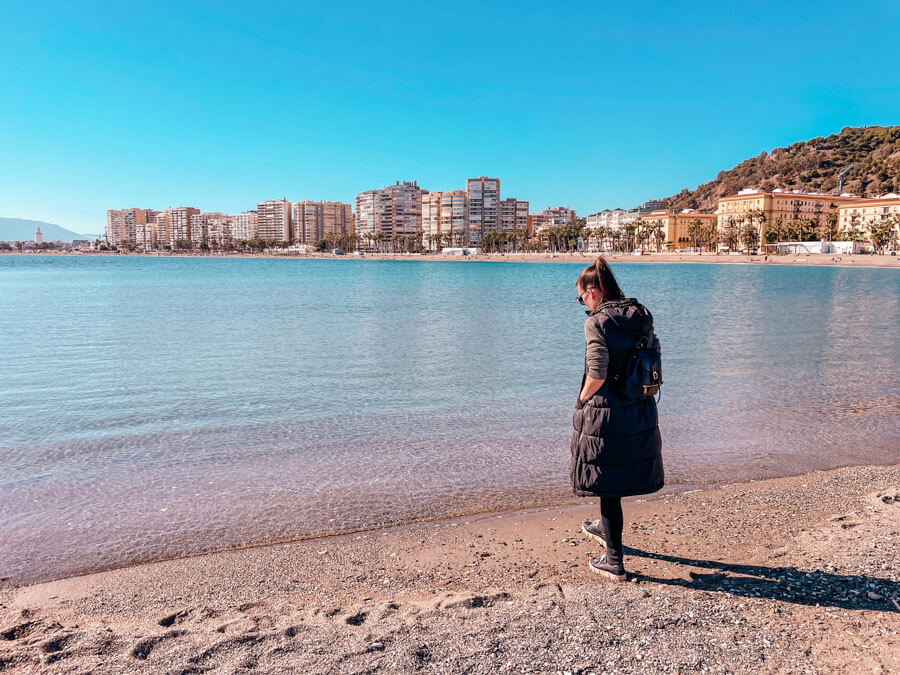
Don’t forget that the weather in Spain in winter really depends on where exactly you go and what you are planning to do. Pack light but definitely take layers and at least some warmer clothes. Even if you are traveling to the South only, expect cold nights.
If you don’t plan to go skiing but still would love to visit the mountains, don’t forget gloves, a hat, and a scarf. It gets really windy in the mountains.
Another important item is comfortable walking shoes . Expect to walk a lot. If budget allows, choose leather only. Leather boots are always comfortable, feet wrapped in leather never sweat, and don’t get blisters from long walks. When buying them, you are going to save money too.
When you are packing for Spain, also don’t forget your swimwear.
We completely forgot to take ours (actually we didn’t forget, we deliberately didn’t pack them thinking they would not come in handy) which was a mistake. We thought the sea was cold anyway and we would not be swimming. But then we learned about the thermal baths and our hotel in Girona had a beautiful pool, so we had to run around looking for swimsuits.
When we were in Catalonia and Costa Brava in December, the weather was warm during the day (on the picture above you can see what I wore on one of those days) but was getting much colder in the evening. Mark was even putting his hat and gloves on while I was wearing a warm jacket.
And the last thing, do not forget glasses, even cold days are going to be very bright and sunny. Make sure to opt for 100% UV protection coating sunglasses to protect your eyes.
Packing light is important. I invite you to check my other post on what to wear in Spain during any season. It has way more practical tips.
More Spain Travel Resources For You
If you are traveling to Spain in winter for the first time, I have more resources to help you get the best of your trip. Check out my guides to Madrid in winter and Barcelona travel tips .
Also, with excellent roads, beautiful scenery on all sides and ancient towns, Spain is made for road trips! Thus, if you plan on visiting Spain in December, January or February, make sure to include a road trip into your itinerary to cover a few regions. And to help you understand what driving in Spain is like and best companies to rent a car, see my post about car hire in Spain .
For more winter content, check my other posts – Kyiv in winter , what is Turkey in winter like , and what to expect from travel in Montenegro in winter . If you are a budget traveler, here is the cheapest places to travel in Europe post.
I am also regularly adding more content on Spain . Sign up for my newsletter to know when the next post is up on the blog.
So, happy travels and enjoy Spain! In winter this country is particularly beautiful!
More Winter Travel Guides For Europe
- Visiting Cyprus in Winter – 8 Fabulous Things to Do + Winter Travel Tips
- Montenegro in Winter Travel Tips – where to go & what to do
- Turkey in Winter – 8 Things to Know Before You Go
- Ukraine in Winter – why it’s also a good season to visit
- 12 Cheapest Places Where to Travel in Europe For Winter Getaway – best for budget travelers
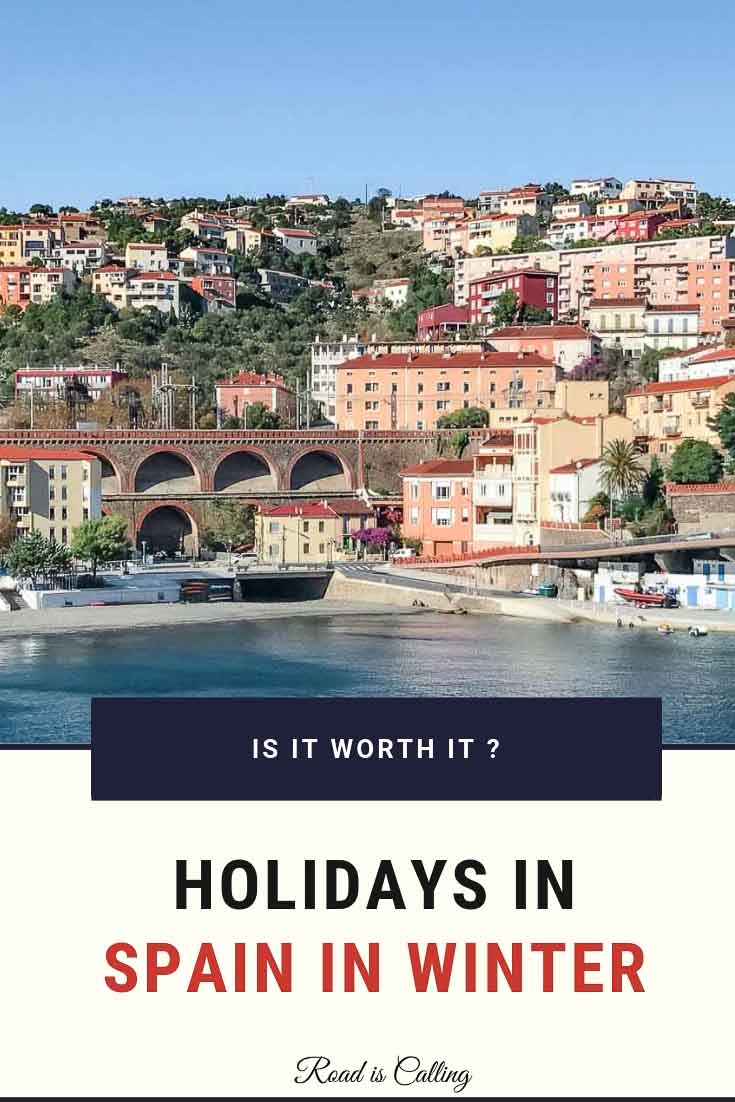
Anya is originally from Ukraine but in heart she is a citizen of the world. She is working online and that’s why has an opportunity to travel a lot and live in different countries. At present time, she is based in Spain while waiting for the war in Ukraine to be over to be able to return home. On this blog, her main goal is to inspire others to travel to under-the-radar places and discover the world while working remotely.
Similar Posts
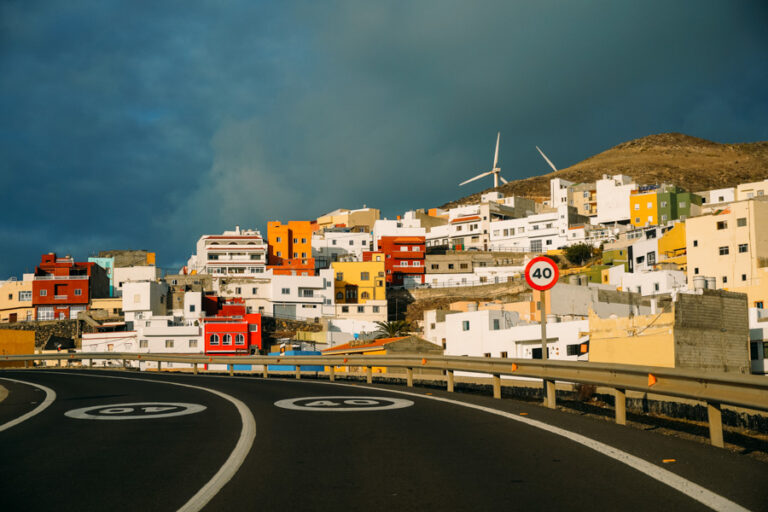
Driving in Gran Canaria: 3 Cool Road Trips to Take This Year
One of the must-do things in Gran Canaria is to go on a road trip as this island is full of scenic drives with pretty old villages and dramatic mountain vistas. Driving in Gran…
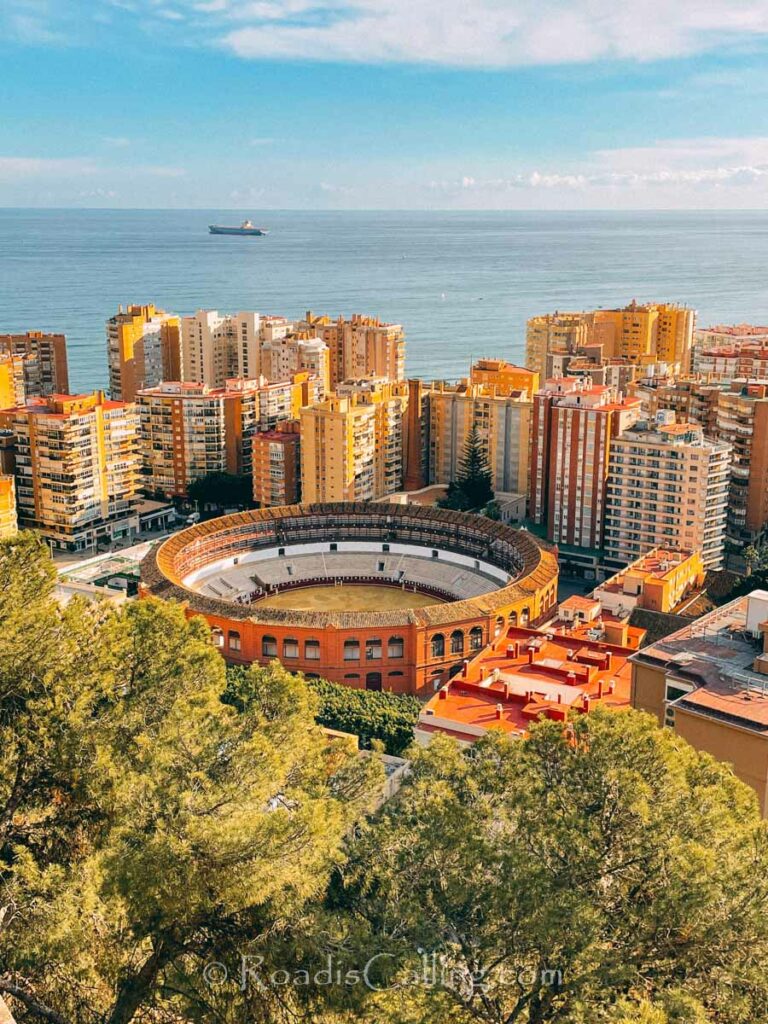
Weekend in Malaga – Action-Packed Itinerary for 2 Days to Get the Most of a Visit
Every weekend in Malaga that I had while living there, I would spend on in-depth city explorations or road trips around the region, discovering its most popular sights together with Malaga’s hidden gems. This…

Renting a Car in Malaga Airport vs City Center – Where is Better & Things to Check
If you are planning to rent a car in Malaga, then you have come to the right place. In my time living in this city, I’ve rented cars constantly and eventually opted for a…

14 Cheapest Places to Travel in Europe in Winter – Let Magic Happen
Are you a budget traveler who is looking for the cheapest places to travel in Europe? For some reason, many people associate Europe with high costs and the word “expensive.” When in reality, this…

Visiting Turkey in January – What Is It Like & Should You Visit?
Holidays in Turkey in January are simply created for lovers of excursions and connoisseurs of history! This is the best time to wander around the historical sites that keep many secrets to this day….

Malaga Road Trip Ideas: 13 Places to Visit From Malaga by Car
Going on a road trip in Malaga was my favorite thing to do when Mark and I were spending one of the winters there. We would often rent a car at the airport for…
32 Comments
Yess, thank you for including a section on the warmest places to visit in Spain in the winter! I’m down to save money on traveling during the off-season, but I really hate the cold, ha. But I just read a post on visiting Italy in the winter, too, so maybe that’s a sign….Thanks for the guide!
Thank you, Dylan. I hear you, don’t like cold too. Glad you like my post!
Although I love cold weather, I love warm places too, they’re just comfortable to travel 🙂 I am in love with your pictures, and I had no idea about the sale season of Spain..will keep that in mind 😀 I looked up your recommendations for the leather boots, sadly they’re not available in India 🙁
Thanks, Shivani, unfortunately, many items are not available in India, I’ve heard that from other readers too. I don’t know why 🙁 I found the same is for Ukraine. When I am there I can’t order lots of things, because amazon and other major companies just don’t deliver to Ukraine, pity!
$18 car rental for 2 weeks?! That would get me to buy a plane ticket to Spain, too. I’ve actually never thought about visiting Spain in the winter before, but after reading your post, it sounds like the perfect destination. Not many countries in Europe offer opportunities for skiing and swimming at the same time. Now you’ve made me start looking at flights and hotels in Spain for this winter…
Thanks, Diana, you’ll surely have fun if you decide to go!
I’ve been thinking of places that would be good to visit in the winter, and Spain sounds perfect! It’s definitely somewhere that’s been on my list. I’m going to Portugal in the spring, so I’ll be close, but not quite there haha. I’m not a skier, but I had no idea that Spain had so many mountain peaks! And I’m definitely going to check out Montserrat whenever I get to Barcelona
Yes, Maggie, Spain has many peaks and this country is so diverse. Portugal is incredibly beautiful too, we can’t wait to visit!
I think winter is the best time of the year to travel. I don’t like to step out of the house in scorching sun. Where I live is hot all year round.
We are like that too. We thought we loved heat and sun but learned throughout all our travels that winters can be so much fun too!
Hey, this is so timely! We are hoping to go in February. How in the world did you get your amazing rental deal? Also, did you need to have your international driver’s permit to drive there?
We found it on easyrentalcars. Mark just loves surfing through different deals so I need to give him a credit for finding this one in Spain! We did have our international permit with us but no one from the rental company asked for it, they told us American license was enough. Actually, in other European countries, including Scandinavia and Balkans, we were never asked for international permit too. I guess they don’t care 🙂
This is just what I needed to see. My boyfriend and I are planning to live in Spain for a while but I was super worried about winter – I know it’s one of the warmer climates but still…..I hate winter haha. But this has eased my mind a bit. It doesn’t sound at all bad!
Spain reminded us a lot about California. For the most part, winters are very mild and enjoyable. I think you’ll love it there!
It is so great to visit destinations like Spain during the off-peak season, besides some of those places has some really nice weather. I know I would love a 20c in the winter! All the place you visited looks so beautiful and peaceful. Trading the warm weather for some peace and enjoyment of a place doesn’t look so bad!
So true, Lyne!
Traveling offseason is certainly one of the best ways to save money. I would never have thought of Spain for winter, but it does make sense given the mild temperatures. So thanks for that tip. What a steal on the car rental – $18 for two weeks…a bargain! We are actually planning a trip to Costa Brava and the winter time might just be the perfect time to go. Gorgeous pictures 🙂
Thank you, Rosemary, and yes, Costa Brava in winter is way quieter, I’m sure you’ll love it!
Spain always looks beautiful! I have been to Barcelona only for two days for business meeting 🙁 So could not explore anything there. But since then Spain was left in my destination bucket list. Next time I will definitely plan for the Spain vacation & specially to the warmest places as don’t love winter much. Thanks for such a lovely post.
Thank you, Deepa, for your lovely comment! Spain is huge indeed and really has a lot to offer. We are eager to go back and explore more of this country too!
Thank you for including the weather conditions on a blog about Spain. The weather situation should be more important when traveling to anew country. But almost all may forget to study whether conditions before a trip. So there may be a chance to lost your entire trip ideas by a bad climate. Actually, I didn’t think the winter in Spain maybe this much beautiful. The images on the blog attract me much more than the words. Thank you.
Hi Dhanika, I am so glad to hear you found this post useful! Thank you for leaving this comment, it makes my heart sing. We absolutely fell in love with winter season in Spain and believe it is one of the best times of the year to visit! If you go, you won’t regret!
Hi Anya, could you please share with us more info about the car rental. Thanks
Hi Nas, Somehow, Spain has one of the lowest rates for car rentals in Europe, so it’s a great idea to explore this country by car. At least as long as you’re not planning to just stay in one of the major cities. In my experience, it is best to rent a car at the international airport in Madrid, Barcelona or Valencia. The site we personally used to rent in Spain and many other places is Discover Cars . They always have great deals. I suggest you check it out. Also, see if your credit card offers rental car insurance (for example, many cards in the US do.) This way you don’t need to purchase insurance from the rental supplier and you would probably get a much newer car. Although, you will still have to give them the deposit. Overall driving in Spain is easy and relaxing, especially in the countryside and small towns. I would avoid driving in the big cities (I really hated Valencia’s giant roundabouts.) There are many interstates with up to 130/km speed limit. Some tolls in Catalonia (paid in a booth) do not show on Google maps, so it may be difficult to avoid them. Free parking is sometimes limited. I always managed to find it (again, not in major cities) but had to walk for 10-15 minutes. I hope this helps a bit. Good luck with your trip!
Thank you for sharing your experience. I would prefer to drop off at different location. Plan the trip from Morocco and from south to north Spain. I will check the site if there any good RentCar deal. Thanks again
Hi Nas, Your idea sounds like fun! Let me know if you have any other questions
Hi Nas, I wanted to share this post with you. Mark has just written a detailed guide on car rental in Spain. It should answer all your questions. Take a look here .
We too spent three weeks in Spain in January and February. What a wonderful trip we had. We made Malaga our home base per say, rented a car and drove the whole southern area. Even did a day trip to Morocco. Can’t say enough about the wonderful trip we had. And yes very reasonable.
Thank you, Jean, for sharing! I haven’t even thought about going to Morocco for a day. We might do it too, we’ll be in Gibraltar in January.
Pretty! This has been an extremely wonderful article. Thank you for supplying this information.
Spain always looks beautiful! I have been to Barcelona only for two days for a business meeting ? So could not explore anything there. But since then Spain was left in my destination bucket list. Next time I will definitely plan for the Spain vacation & especially to the warmest places as don’t love winter much. Thanks for such a lovely post.
Really interesting and well written blog, I enjoyed reading it, please keep on writing blogs like this.
Leave a Reply Cancel reply
Your email address will not be published. Required fields are marked *

Best Time to Visit Spain - Full Month by Month Guide
Spain is consistently ranked one of the top travel destinations in the world, but if you're considering travelling there, you'll need to decide when is the best time to visit.
The thing is, your trip to Spain will look and feel completely different depending on which region you visit and what time of year you travel.
After all, Spain is the second largest country in Europe, with a wide diversity of climate and landscape - which means the weather can vary hugely from region to region.
It's also the second most mountainous European country after Switzerland.
In order for you to decide when to visit Spain, keep in mind each season's perks (lively festivals, sunny weather) and downfalls (crowds of tourists, hiked up hotel rates), as well as what it is you want to get out of your holiday.
The best time to visit Spain is either in late spring or early autumn - especially if you're going to Andalucia or the Mediterranean coastal areas. Northern Spain is at its peak in the summer months (July and August), and central Spain is best visited in October or May.
Winter weather isn't amazing anywhere in Spain, with some parts of the country even experiencing snow and ice.
Visiting Spain in winter is great, however, if you're not too bothered by drab weather and you're looking to save money, as hotel rates and restaurant prices tend to go down then.
Here's when you should visit Spain, depending on what you consider to be the most important part of your trip.

When to go to Spain if you want…
Warm weather.
Contrary to popular belief, not all of Spain is sunny and warm all year long. Likewise, summer is beautiful in parts of Spain, but it can be unbearably hot in other areas.
If your main reason for visiting Spain is to bask in the sunshine and warm weather, consider travelling to the beaches of Costa Brava in northeastern Spain during the summertime.
This region is easily accessible from Barcelona, and the average high is a pleasant 76° Fahrenheit (24° Celsius) in June and 80° F (27° C) in July and August.
Meanwhile, the super popular Mediterranean coast (home to Barcelona, Valencia and Malaga) has lovely weather in late spring and early autumn - think May-June and late September-October.
However, beware that it gets extremely hot in southern Spain at the height of summer - we're talking upwards of 100° F (37-40° C) in August.
A summertime phenomenon locals call El Terral - a hot, dry wind that blows over the Mediterranean coast like a hairdryer - only adds to the discomfort!
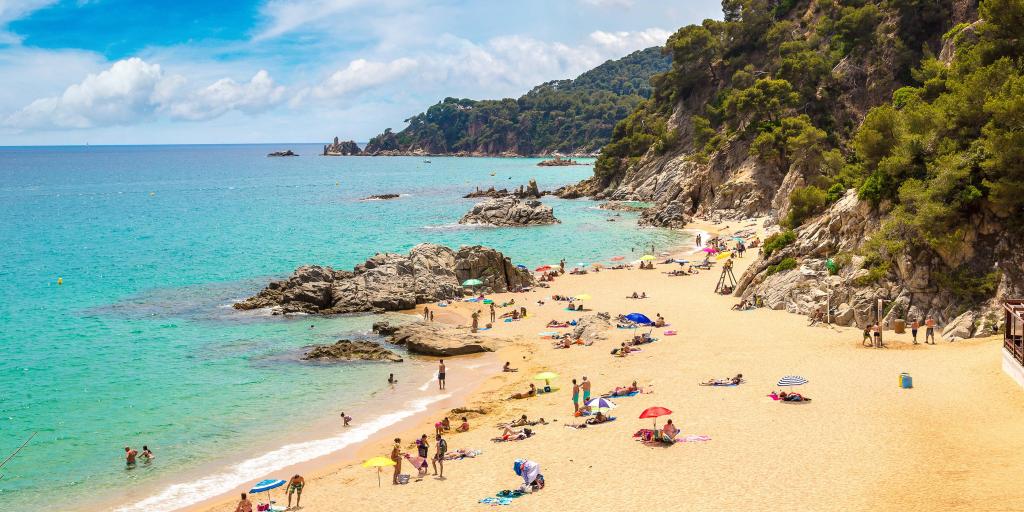
Cheap prices
September to late November and January to March are known as the 'shoulder seasons' in Spain, which means they're less popular times for tourists to visit.
This is great news for travellers who are trying to stay on a budget; Spain thrives on the tourism industry, so during shoulder season the majority of hotels and restaurants will slash their prices in order to attract more people.
Even the cost of flights to Spain is lower in the off-season, with November in particular seeing the cheapest prices.
So if you're trying to save money, time your trip so that it falls outside of the normal summer and winter holiday periods.
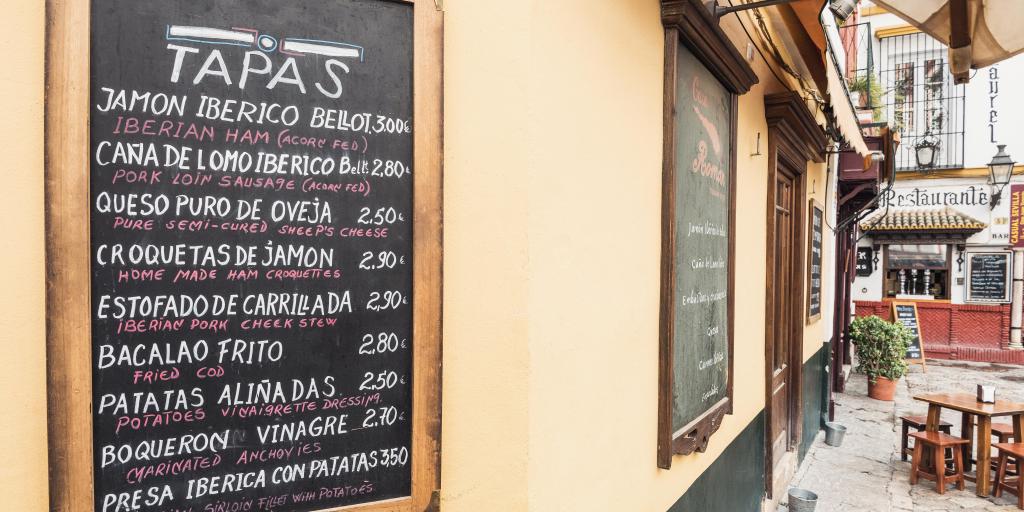
Lively events
If there's one thing Spain is famous for, it's the energy and spirit that seems to emanate from everyone and everywhere in the country.
Want to truly immerse yourself in the Spanish way of life? Then plan your Spanish trip to coincide with one of the countless festivals and events that take place year on year.
For something a little different, plan a trip to the town of Buñol in Valencia at the end of August to attend La Tomatina.
This wild and one-of-a-kind festival sees tens of thousands of people throwing tomatoes at each other, turning the town into one big pile of red pulp.
If you'd rather something a little less messy, consider going to Seville two weeks after the Semana Santa (Easter Holy Week).
This is when the city hosts the Feria de Abril, a week-long celebration featuring lots of dancing, drinking and eating interspersed with fireworks, traditional horse riding and bullfighting.
For more must-see Spanish festivals, read on!
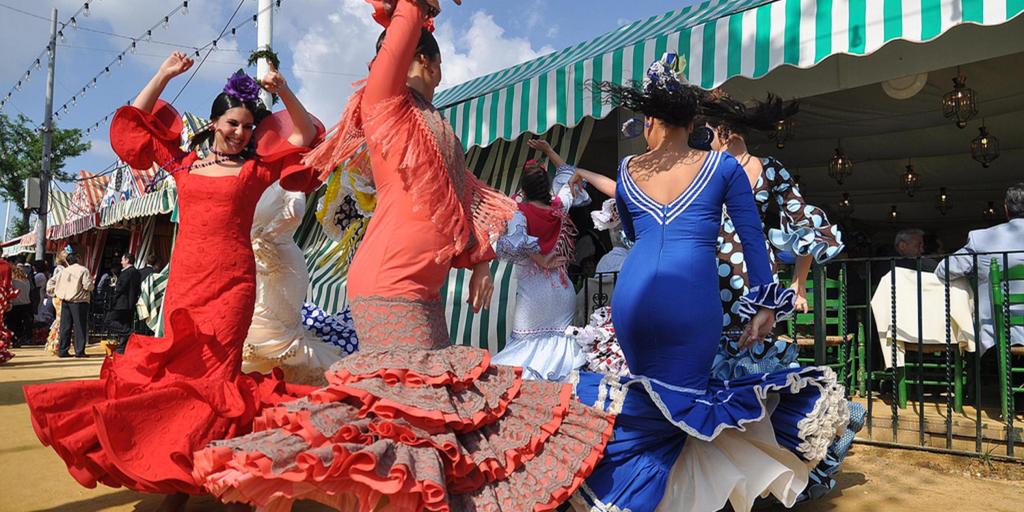
Peace and quiet
Crowds not your thing? Then January - February is probably the best time for you to visit Spain.
Seeing as it's off-season, you won't find throngs of tourists invading some of the most popular destinations like Granada, Seville and Barcelona.
That means less queuing and an overall more authentically Spanish experience.
Unless you go to the Canary Islands, you probably won't be able to do any sunbathing in January and February.
But the weather in southern Spain is fairly dry and manageable at this time of year, making it the perfect place to visit for a winter break.

The best time to visit Spain: A month-by-month guide
If you hate crowds, don't mind iffy weather and would rather not spend lots of money, January is a fine time to visit Spain.
Since it's outside of peak tourist season, you'll likely get more bang for your buck no matter which region you go to, as hotel room rates and restaurant prices go down across the country after the Christmas holiday.
There's also a handful of festive events going on at this time of year, including Three Kings Day (Dia de los Reyes) on the 6th.
This holiday, which is also known as Epiphany, is Spain's version of Christmas day, with many families opening their gifts then rather than on 25 December.
Many cities around Spain including Madrid and Barcelona also host a boisterous Three Kings Festival, with people parading through the streets on the evening of the 5th and well into the next day,
Members of the local council will march through the city, throwing sweets into the crowds for children and adults to catch.
Despite the lack of beach weather, January is a merry - and relatively tourist-free - time to visit Spain.

The weather in Spain in February is much like it is in January - some degree of chilly.
Even in Andalucia, the highest temperature is about 60° F (16° C), and evenings can get down to the 40°s F.
That being said, there are plenty of good reasons to visit Spain in February, including some lively carnival parties in Cadiz, Madrid, and the Canary Islands to celebrate the beginning of Lent.
And if you're into your music, plan a February trip to the city of Jerez, which hosts a massive two-week-long flamenco festival every year starting in February and finishing in early March.
While the evenings are still cool in March, this is the month when things begin to warm up in Spain.
The sea may not be quite warm enough to swim in - even the Mediterranean - but walking on the beach should be pleasant around this time of year.
Plus, there are lots of cultural events and festivals to experience in March, including Valencia's unique Las Fallas festival in mid-March.
During this riotous week, the city is -quite literally - set ablaze with fireworks, gunpowder and bonfires, while live music and a healthy dose of satire give the festival a fun and humorous touch.
The main event sees hundreds of ninots (dolls made from papier-mache, wood or cardboard) set alight in a mass fire called La Cremà (the burning).
Keen to get stuck into the real-life culture and traditions of Spain? Then you could do much worse than Spain - and Valencia in particular - in March.
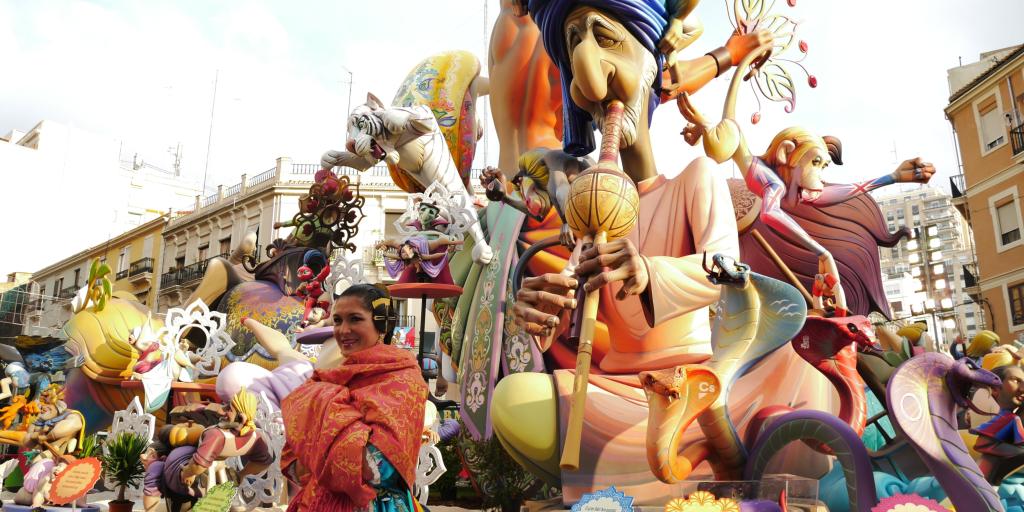
In our experience, April is one of the best months to visit Spain, for numerous reasons.
By April, the majority of mainland Spain's most popular beach towns - Marbella, Alicante, Malaga - are warm enough to do some sunbathing.
And things tend to be pretty sunny and dry in the Balearic Islands as well, with Ibiza, Mallorca and Menorca ushering in the springtime.
Seville's Feria de Abril is enough of a reason to travel to Andalucia in April, as the city comes to life with traditional flamenco music and dancing.
Meanwhile, at the end of April, the town of Trujillo in Spain's Extremadura region hosts the Feria del Queso - a three-day-long festival celebrating all things cheese.
If you consider yourself a foodie - or a cheese fan, in particular - you'll be blown away by the sheer number of cheese varieties available to sample.

In terms of weather, May is yet another gorgeous month to visit Spain, with temps on the rise and the sun shining more and more.
Clear, sunny skies and warm days are the norm by now in Barcelona, with average temperatures reaching about 20°C (68°F).
It also roughly marks the beginning of bullfighting season in Spain, a centuries-old tradition that's either thrilling or horrifying, depending on your personal standpoint.
If bullfighting isn't your idea of a good time, there's plenty of other activities going on in May, including the Primavera Sound Festival in Barcelona, the San Isidro Festival in Madrid, and the WOMAD World Music Festival in Caceres.
Plus, since the official summer holiday hasn't begun yet, most destinations are less busy in May than they are in June, July and August.

Now that many schools have broken up for the summer holidays, expect flights, hotels and food in Spain to be pricier than before.
However, it's worth spending a bit more to take advantage of the sheer variety of fun things going on - not to mention the sublime weather you'll experience across the country.
By June, Madrid will already be pretty hot and dry. If you're visiting the capital then, consider making air conditioning a priority when looking for accommodation.
And if you're considering visiting Spain to do some surfing or kite-surfing, now is a fantastic time to go to Tarifa - one of the most popular destinations in the world for wind sports.
You'll enjoy balmy days, cool evenings, and the city's laid-back surfer lifestyle, before the masses of late-summer visitors pile in.

July is the absolute busiest month for most Spanish destinations, which makes it both a good and a bad time to visit.
On the plus side, all the restaurants, bars and hotels will be open and fully functioning, and you can expect a lively, fun-filled atmosphere across the country.
But visiting Spain in the high season also means you'll probably have to spend more on hotel rooms, and you can expect to hear lots of English wherever you go.
In any case, if you do decide to visit Spain in July, you'll definitely need to book your accommodation well in advance, before hotels fill up completely.
At the height of summer, some of Spain's most popular destinations are simply too hot to visit (Malaga, Granada and Seville - we're looking at you!)
Instead, head north to Galicia, Asturias and the Basque country, where the weather is pleasant (in the high-teens to mid-twenties Celsius) without being unbearable.
August is the perfect time to go on a road trip through northern Spain , sampling all the delicious pintxos you can manage along the way.
For a unique cultural experience, time your trip to coincide with the Semana Grande, which takes place in Bilbao and San Sebastian every August.
During this festival, you can expect to see traditional Basque sports, giant puppet dances, and a spectacular fireworks competition lighting up the night sky every evening.

With temps beginning to cool down again in September, Spain's fiery summer destinations like Madrid and Cordoba are no longer too hot to handle.
Now's your chance to take advantage of those amazing cities without feeling like your face is about to melt off!
September is also a great time to sample some of Spain's finest wines during the harvest season.
If you love wine or simply want to immerse yourself in the country's wine culture, book a trip to Logroño, Spain - the capital of the La Rioja region - in the third week of September.
This is when the San Mateo festival takes place - a week of celebrating the local wine harvest with music, festivities, and lots of drinking.
A highlight of this event is the crushing of the grapes, during which you're invited to squish Rioja grapes with your own feet.

Summer is well and truly over by October, which means we're back in shoulder season.
This is a lovely time to visit Andalucia, seeing as the weather is mild, the cities are a bit quieter, and the beaches are still relatively sunny.
You can even still sneak in some sunbathing if you head to Mallorca, where the temps are still in the mid-Twenties Celsius.
Sporty types might want to head to northern Spain in October, which marks the beginning of surf season.
Just make sure you wear a wetsuit!
If, on the other hand, you want to embrace the autumnal beauty of Spain, there are quite a few places to spot some stunning fall foliage.
One highlight is Irati Forest, situated on the northeastern border with France, which boasts some particularly vibrant hues around this time of year.
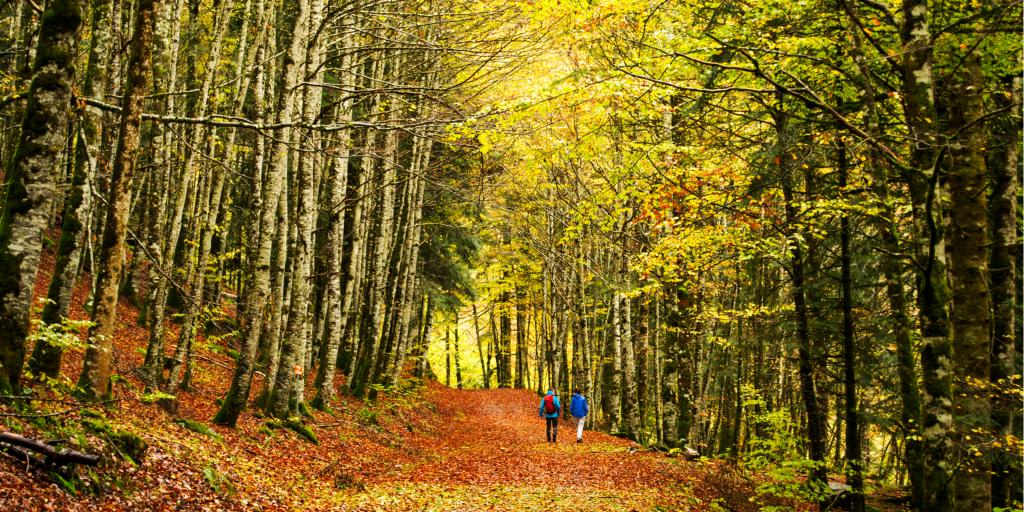
With its slow pace and refreshingly crisp weather, November is a fine time to go for a road trip around Andalucia , perhaps visiting some of the famous Pueblos Blancos (White Villages) in the hills.
While you're down there, make some time to visit Ronda, which Ernest Hemingway described as 'the most romantic town in Spain' and which animated film fans will recognise from 2017's Ferdinand .
You can also stop by the nearby Jerez, where they host the International Sherry Festival every November.
Fancy more of a city break than a full-blown holiday? Then book a trip to Madrid to see the autumn colours in El Retiro Park and witness the international Jazz Festival.

With Christmas on the horizon and festive spirits at an all-time high, December in Spain is almost as lively and exciting as summer.
Plus, thanks to the country's size and variety of climate, you can have any type of holiday you want in December - from ski trips to beach breaks, and everything in-between.
To get into the holiday spirit, head to Barcelona or Seville, where you'll find great Christmas markets.
Pay a visit to the city of Malaga and you'll see a seriously impressive display of fairy lights on the main street, which draws thousands of spectators to the city centre every evening in December to watch it become illuminated.
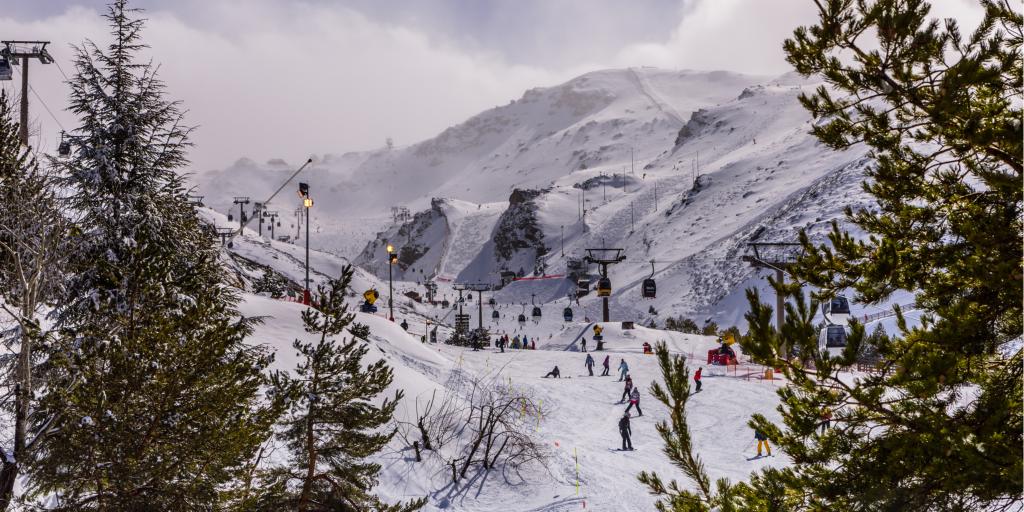
Meanwhile, December marks the beginning of ski season in Granada, with the snow-capped Sierra Nevada opening up to skiers and snowboarders alike.
And historic Zaragoza in northeast Spain is a great place to stay while visiting the nearby ski resorts in the Pyrenees.
If you've got a hankering for winter sun, book a trip to Gran Canaria, where the average December temperature hovers around the low 70s° F.
And wherever you decide to go, be prepared to take part in some Spanish New Year's Eve traditions, including eating 12 grapes at the stroke of midnight.

Join our email list!
By joining our email list, you give LazyTrips permission to use your email for sending you newsletters, emails and updates including for marketing purposes. Your email will not be provided to third parties.
Related posts
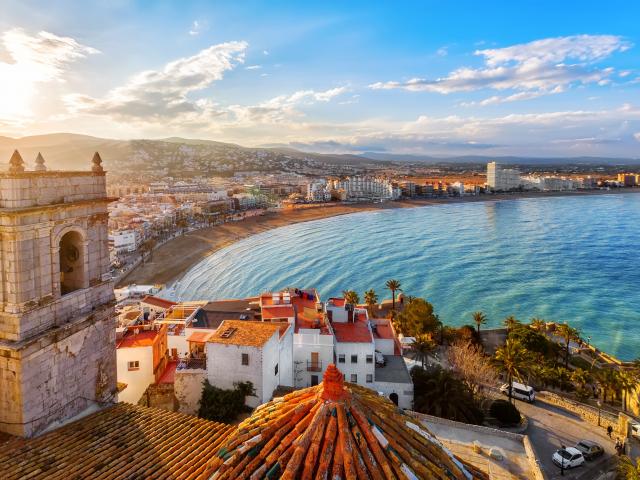

Valencia in February: Weather, Things to Do & What to Wear
Valencia is always a good idea. The month of February in Valencia is synonymous with medieval markets, colorful carnival parades and even some events organized in preparation of Las Fallas. If you’re wondering how cold it gets in Valencia in February, what’s on, and what kind of clothes you should bring, read on.
In This Article
Is February a good time to visit Valencia?
Weather in valencia in february, what’s on in valencia in february.
Exposición del Ninot
San Blas medieval market
Ruzafa Carnival
Macromascletà
Macrodespertà
Crida
What to wear in Valencia in February
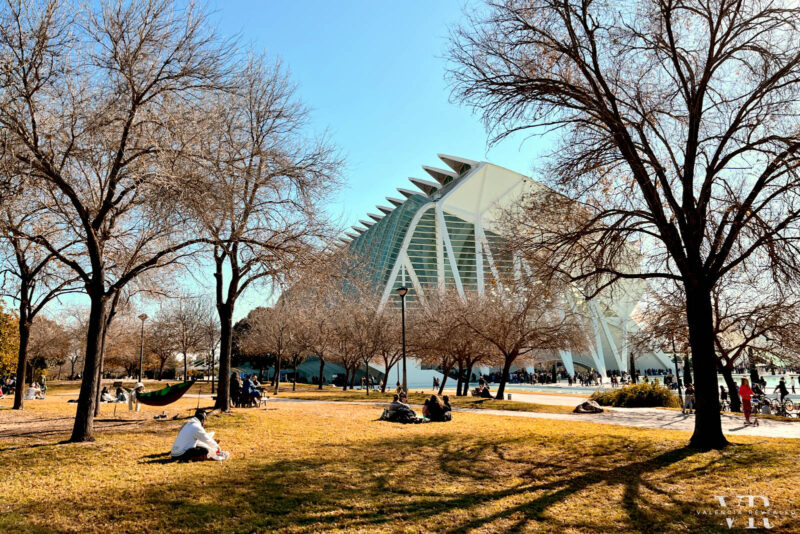
February is an excellent month to visit Valencia, since the lower temperatures attract fewer crowds. As a result, you can take advantage of the off-peak accommodation prices and laidback vibes.
February is one of the quietest months in Valencia, yet there are still plenty of things going on. Most events are pretty low-key and specific to certain areas, so the city in general feels peaceful and quiet.
The weather can be a bit of a lottery, with some days oozing spring vibes while others bring heavy clouds and even rain. However, the weather remains generally mild and pleasant, so I wouldn’t worry too much about it.
Overall, if you’re looking for a winter getaway with comfortable weather and a relaxed atmosphere, February can be a great time to visit Valencia.
Also read: What Is the Best Month to Visit Valencia?

Valencia in February offers a mild and comfortable climate. Maximum temperatures are reached around 2 pm and range roughly between 12ºC (54ºF) and 19ºC (66ºC). Minimum temperatures are reached early in the morning and are around 7ºC (44ºC).
Valencia can also experience some rainfall during the month of February, so you may want to bring an umbrella or rain jacket.
On days with clear skies and no wind, there can be huge temperature differences between standing in the shade or in direct sunlight.
Because air temperature is always measured in a shady location, you might be able to enjoy a cup of coffee in your T-shirt on a sunny terrace even if the weather forecast says 8ºC (46ºF). The temperature is much warmer in direct sunlight, likely around 24ºC (75ºC).
This makes open spaces, such as Túria Park , the City of Arts and Sciences, the newly renovated Plaza de la Reina, and the beach, the ideal places to soak up some winter sun while visiting Valencia in February.
The Old Town and Ruzafa neighbourhood also have plenty of sunny terraces you can enjoy. But walking from point A to point B may be less comfortable. That’s because Valencia has many narrow streets flanked by relatively tall buildings, allowing sunlight to reach the sidewalk only for brief periods of time each day, if at all.
February might be low-season, but that doesn’t meant you’ll get bored. On the contrary, there are quite a few things going on in Valencia during February. Besides, you can also check out some of these top activities . And if you’re on a budget, there are plenty of free things to do in Valencia as well.
Exposición del Ninot
From the first Saturdays of February to March 14th
Las Fallas is the most important festival in Valencia. This festival is held in March, but you can see the best ninots (dolls) of the year as early as February at the Ninot Exhibition. The Ninot Exhibition is housed within the Prince Felipe Science Museum (part of the City of Arts and Sciences). During your visit you can vote two ninots you’d like to be pardoned from the fire. You can also see ninots from past years at the Fallero Museum nearby.
San Blas medieval market

Celebrated on the weekend closest to February 3rd
Each year, on the weekend closest to February 3rd, a cute medieval market is organized on the streets around Iglesia de San Valero y San Vicente Mártir in the Ruzafa neigborhood. This is a great opportunity to buy quality souvenirs from Valencia , such as handmade jewellery, leather goods, wooden toys and olive wood kitchenware. The market is also a great for trying delicious Valencian foods , such as artisan sausages and cheeses, pickled olives and stuffed buns.
Ruzafa Carnival

Varying dates – February 18th & 19th, 2023
While the Tenerife and Cadiz carnivals might steal all the media’s attention in Spain, if you’re in Valencia during the carnival season, head to Ruzafa neighborhoods and join in the fun. The carnival was celebrated in Valencia as early as the 19th century. When King Alfonso XIII prohibited the celebration of the carnival within the city walls, the party moved to Ruzafa where it’s still celebrated today. Expect dazzling costumes, batucada groups and lots of good cheer.
Macromascletà
Usually celebrated on the last Saturday of February – in 2023, this event has been cancelled
As the month of March approaches, locals grow impatient in anticipation of Las Fallas. So on the last Saturday of February, the first macromascletà is organized. The macromascletà takes place in Ciudad Fallera neighborhood (Benicalap district) in the evening. The super loud firecracker show is followed by a street party with DJs and lasts until after midnight. This is one of the best things to do in Valencia for young adults visiting in February as it can be tons of fun.
Macrodespertà

Celebrated on the last Sunday of February
On the last Sunday of February, at the crack of dawn, thousands of falleros and falleras head towards the City Hall Square throwing firecrackers left and right and making as much noise as possible to wake up the city. This event is called macrodespertà and it concludes with a mascletà, a loud firecracker show. The macrodespertà is followed by a breakfast consisting of churros and hot chocolate, two typical foods eaten during Las Fallas .

La Crida is the official opening act of Las Fallas. It takes place in front of Torres de Serranos in the Old Town, following a day packed with events. Expect blasting music, fireworks and an amazing light show on Torres de Serranos. Tens of thousands of people gather for this event, so if you want to get a good spot, it’s best to arrive early.
- What to Do in Valencia As a First Time Visitor (You Cannot Miss #12!)
- 10 Best Places to Visit in Valencia
- 11 Family-Friendly Things to Do In Valencia
- Valencia on a Shoestring: 10 Free Things to See and Do
If you’re visiting Valencia in February, it’s best to pack for both warm and cold weather. I know this can be a hassle, but it’s best to come prepared.
On sunny days, you might be comfortable wearing a T-shirt as you soak up some rays on a terrace, in the park, or on the beach. But as the sun goes gown, you’ll definitely need warmer clothes and a jacket, especially if you stay out late.
Weather-wise, there isn’t much difference between visiting Valencia in January and February. You should still pack warm PJs, slippers and loungewear. That’s because most apartments in Valencia don’t have central heating and are generally poorly insulated.
This means that if your building is in the shadow cast by the surrounding buildings, temperatures indoors can be lower than outdoors in the sun. I know it’s hard to believe, but it’s actually true. Winter in Valencia is full of surprises.
On clear days, the sun can be quite strong, so you should also pack your sunglasses. And don’t forget a water bottle with a filter, as tap water in Valencia tastes pretty bad.

Leave a Comment Cancel reply
Comments are publicly visible. Kindly refrain from sharing any personal or private information.

Spain in February 2024: Places to Visit, Weather, And More!
Spain may be Europe’s hidden winter gem. This European country enjoys the most temperate climate due to its geographical location. It is again the only country where you can get best of both the worlds in the month of February, be it ski on the snowcapped mountains or enjoy sunny day at the beach. The mainstream image of Spain is either football or enjoying a glass of margarita laying at the beach. But what very less people know is that it is in winter months Spain offer pleasant cold unlike north European countries. Also during this time you will find lesser crowds at tourist spots so that you can explore the area at your own pace. One other factor can be lower prices of tickets so that you can spend more money on everything apart from just in flights.
You can plan road trip through the Andalusian region all the way to Valencia and moving forward up to Barcelona . On addition beautiful landscapes of Spain you will get to experience the postcard-perfect coast, beaches and villages of the country. Andalusian region is warmest in winters. It is an ideal honeymoon destination for those couple who get married in winters. Spain also has Canary Islands to offer for those who wish to have a more relaxed vacation. Trains are comfortable mode of transportation in European countries and also you save time as compared to flights where you have to reach airport 2 hours prior to the departure.
Spain Tour Package Starting @ ₹74,660
Pristine beaches. Exotic Stays. Tapas & wines. Quirky Festivals
Weather in Spain in February
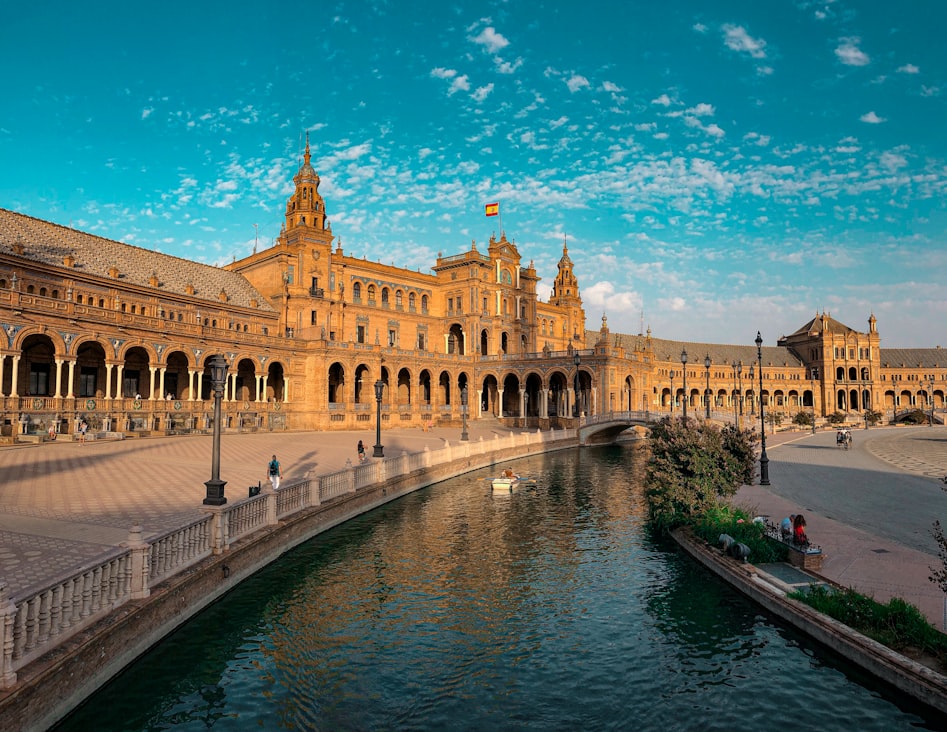
Overall February in Spain is chilly, but most of the metro cities doesn’t reach to sub zero temperature. While other major cities of Europe are chilling, Spain offers good amount of warmth comparatively.
Madrid is relatively dry and snowfall is close to nil. While the early mornings and late nights can be a bit chilly. Since Barcelona is a coastal city, it’s not as cold as Madrid.
Also read : Top 5 Helpful Tips While Travelling to Madrid
Cities like Malaga and Sevilla have a higher average temperature as compared to rest of the Spain, although not enough for a sunbathe. Where as in Northern Spain temperature drops close or less to zero degrees and also rains continuously.
- Madrid : 54 F (12 C)/ 34 F (1 C)
- Barcelona : 57 F (14 C)/41 F (5 C)
- Sevilla : 64 F (18 C)/44 F (7 C)
- Malaga : 63 F (17 C)/46 F (8 C)
What to pack for Spain in February
You won’t need heavy winter gear in Spain, some cold-weather basics will do the trick. List items can include:
- Full/short sleeves shirts for layering
- Long sleeve tops
- A sweatshirt or cardigan
- A light jacket
- A lightweight scarf
- Jeans/cargo pants
Places to visit in Spain in February
- Canary Islands
- Murcia & Cartagena
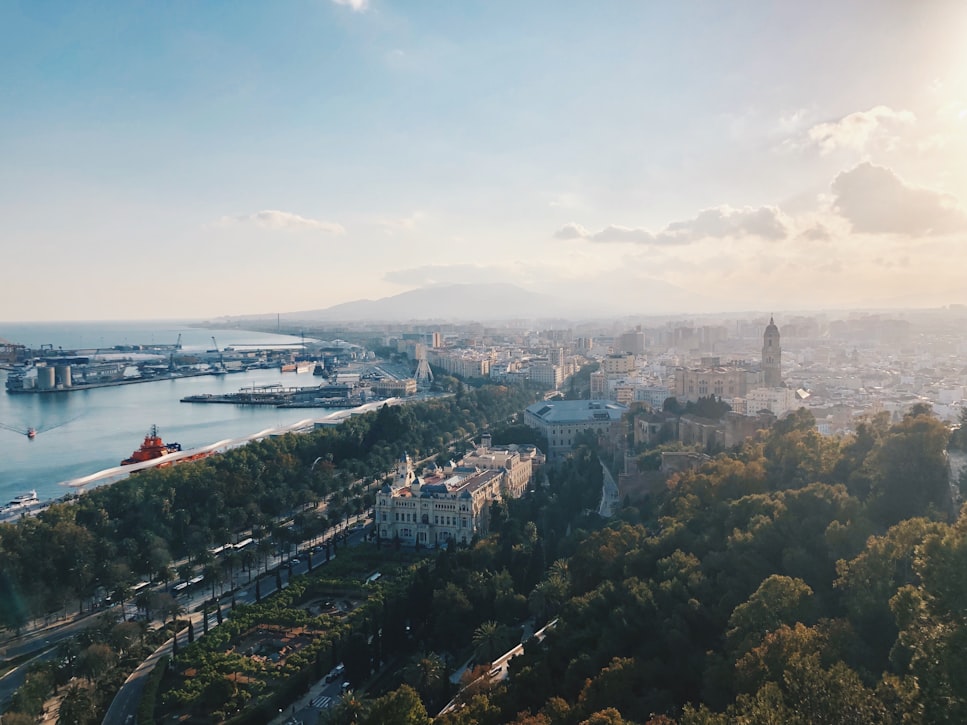
Malaga is the capital of Costa del Sol , which actually translates to Coast of the Sun. It has the best beaches to offer and that’s not even the best part ! Less crowded is word you are looking for here. That’s the beauty of Spain in winters. People who like older buildings and appreciate great architecture will fall in love with this city. The Catedral de la Encarnación de Málaga, is actually an eye pleasing structure to look up to. Whitewash villages are must to see attractions in the region to get the feel of local culture. La Farola is a 19th century lighthouse, one of Spain’s oldest. You can definitely go there for evening stroll. Don’t forget to visit a 250 year old historical marvel : Catedral De La Encarnacion De Malaga.
Also read : Top 8 Beautiful Beaches in Malaga
2. Canary Islands

Canary Island is located bit far from Spain and near to Morocco. So it gives a feel of being close to the equator with its tropical like weather. It’s always been a beloved destination for sun bathers. The island has three UNESCO World Heritage Sites : Garajonay Nation Park, San Cristobal de La Laguna and Risco Caido archaelogical site Being an island there’s a lot of marine life to explore. You can take a boat trip around the island for dolphin or even whale spotting. Also go exploring other nearby islands : Gran Canaria, La Gomera, El Hierro and others. The best part is you can easily travel to these islands by ferries.
Also read : Top Beaches in Canary Islands
3. Murcia & Cartagena
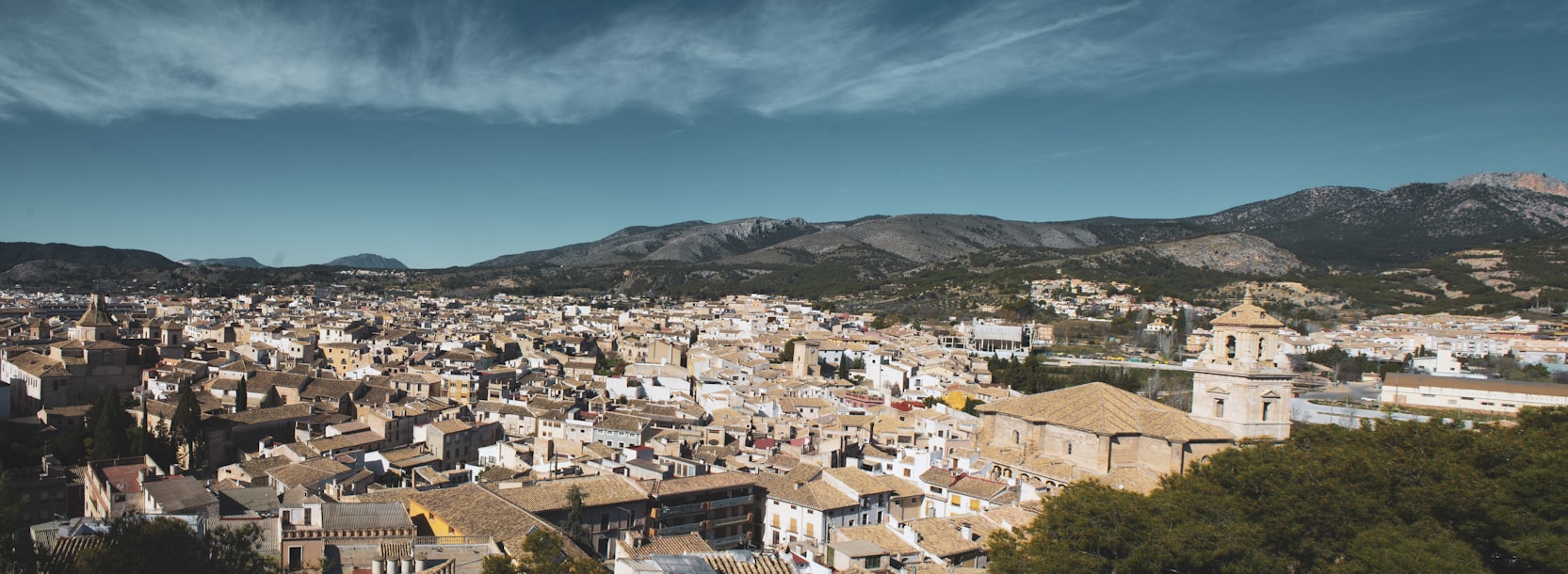
Cartagena is actually an old port city. You’ll get a chance to witness amazing beaches here and don’t forget to visit the museum based in an excavated ancient roman amphitheater. Murcia is a gorgeous old town situated just a 30mins drive from Cartagena. It was established in 831 AD. It is a place to look around for local cuisine and culture. Pastel de carne (meat pie) is an authentic dish made with meat, tomato and egg. Traditionally, a Murcian might just carry it as a snack to see bullfight. Being in Spain it’s not possible to mention Tapas. Murcia has its own local tapas specialities perfect to enjoy with a glass of local wine. Apart from this you might even get luck to spot a flock of pink flamingos!
Also read : Best Things to do in Murcia
Events to attend in Spain in February
- Festival de Jerez : Flamenco is an old traditional dance with its roots in Andalusia province. This annual Flamenco dance festival celebrates the heritage in old town of Jerez. You can witness greatest flamenco artist performing right in front of your eyes.
- Madrid Gastro Festival : All the restaurants, pubs, bars and cafes highlight the dishes of the Spain. Almost all the food outlets in the city take part in this allowing visitors to taste everything be it traditional tapas or local wine.
- ARCO Madrid Contemporary Art Fair : This art fair takes place in the massive IFEMA Convention Centre where works of over 1300 artists from around the world is displayed.
- Los Moros Y Cristianos : Lots of cities across the country celebrate this festival , which literally translates to “Moors and Christians”. Citizens dress up into old traditional clothes and reenact epic battle scenes from the Reconquista period, in this interactive even which brings out the local communities is a must to catch if you are in Spain in the month of February.
Excited about your trip to Spain in February? Check out Spain travel packages for friends and Spain honeymoon packages offered at Pickyourtrail and make a romantic Spain vacation!
Frequently Asked Questions
Yes, several events are held in Spain in February. The most notable is Carnival, which is celebrated in cities such as Cadiz, Tenerife, and Sitges. It is a lively festival with parades, music, and bright costumes.
In February, cities such as Barcelona, Seville, Granada, and Valencia are excellent choices. Additionally, exploring smaller towns or the countryside during this time can provide a more tranquil experience.
Keep in mind that February is the off-season. Some smaller towns or restaurants may have limited hours or closures, and certain transportation services may have altered schedules.
Most tourist attractions remain open, though some may have reduced hours or closures during the off-season. It is best to check specific attraction websites or confirm opening hours ahead of time.
Yes, several events take place in Spain in February. The most well-known is Carnival, which is held in cities such as Cadiz, Tenerife, and Sitges. It is a lively festival with parades, music, and bright costumes.
Nishant Gurav
11 posts published., related itineraries.

9 Days Swiss & Lyon Packages For Couple
- Flights excluded
- 5 star accommodations
- 5 activities
- Shared transfer
₹ 1,66,082
Starting price/person
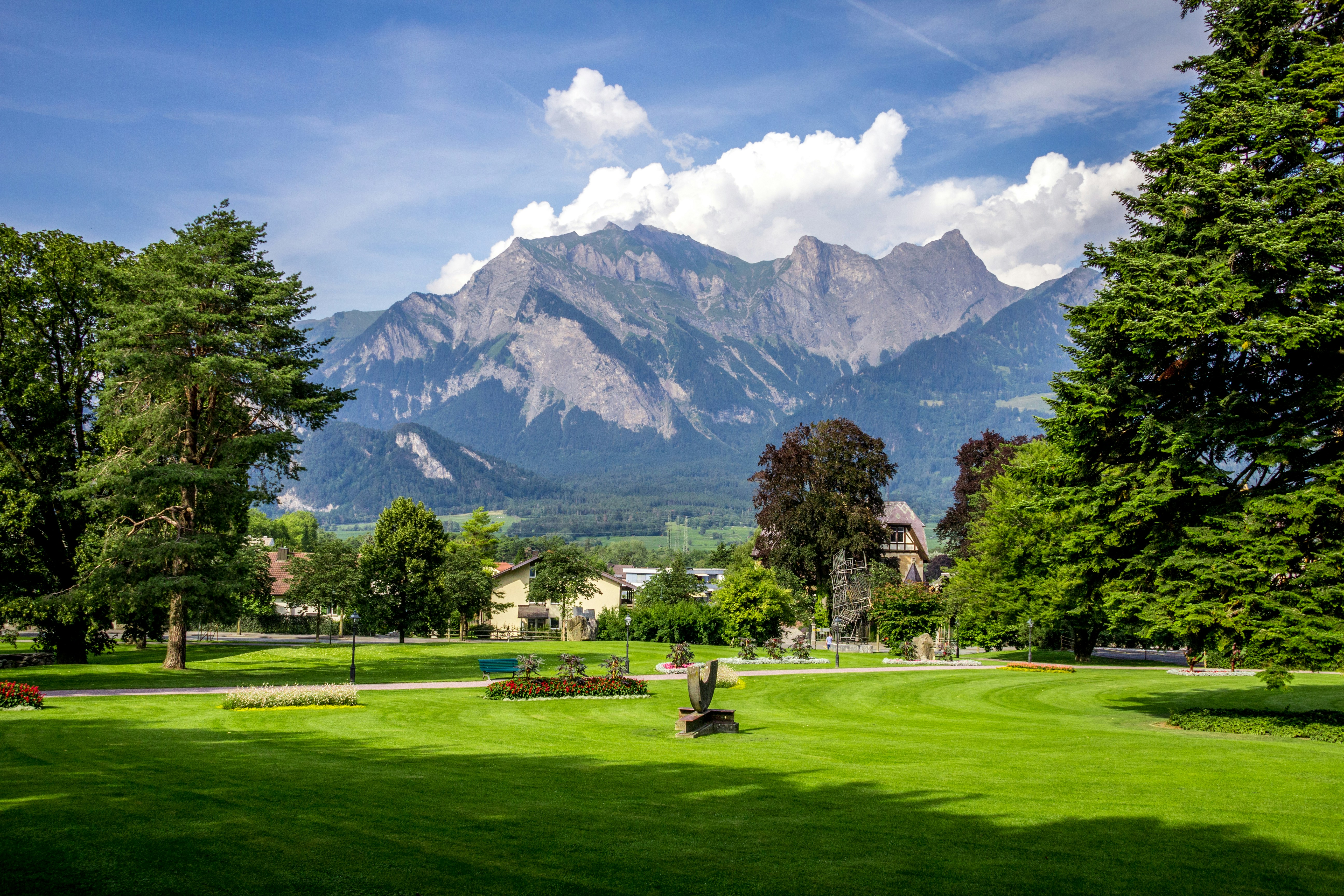
Switzerland Couple Trip Packages For 10 Days
- 6 activities
- Private transfer
₹ 1,68,750

9 Day Swiss & Milan Trip Packages
₹ 1,73,311.

Mesmerizing 9 Nights Switzerland Trip Packages
- 3 star accommodations
- 4 activities
₹ 1,74,011
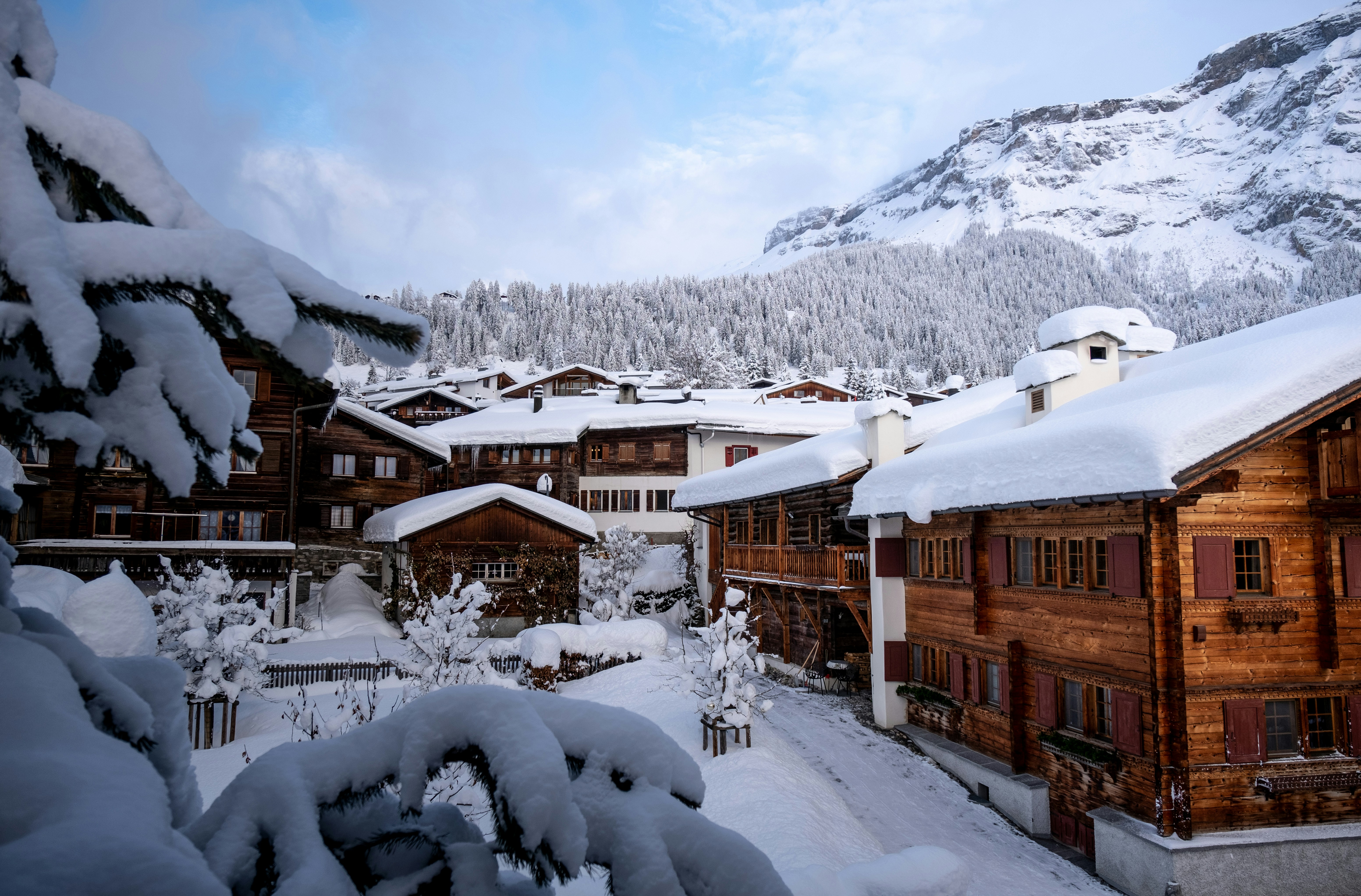
Magical 10 Days Switzerland Packages For Family
₹ 1,74,572.

Exotic 11 Day Europe Honeymoon Packages from India
- Flights included
- 4 star accommodations
₹ 1,22,770

A Perfect 10 Nights Switzerland Packages For Couple
₹ 1,75,732.

Romantic 9 Nights Swiss & Amsterdam Couple Package
₹ 1,76,542.

Classic 12 night Europe Budget Tours from India
₹ 1,07,884.

Classic 8 night Europe Honeymoon Package from Kolkata
₹ 96,857, related posts, how to reach spain from india – a great getaway, spain visa for indians-a detailed guide on the process to obtain one, 10 best & most famous festivals in europe to experience in 2024, top 9 best things to do in spain 2024, where to go in may – best places across the world | updated 2024, 8 best things to see and do in girona spain in 2024, 7 christmas secrets from 7 countries, spain in august- an elaborate guide to get the best of your spanish holiday, 10 days in spain: an ideal spain itinerary, a spanish shopping tale – 9 top places to shop in spain, 10 best souvenirs to bring back from spain, spain in december – the festival month is all set to brighten your vacation.
Book a vacation completely online
Our community is growing fast
Sign up for exclusive PYT Club membership and access jaw-dropping deals before the rest of the world!
- Signup with Email
- Facebook community
- Telegram Community
Access exciting travel deals at best prices
- New Zealand
- South East Asia
- United Kingdom
- United States
- Switzerland
- Travelogues
- Travel News
- Guest Posts
- Write for us
Travel Safe
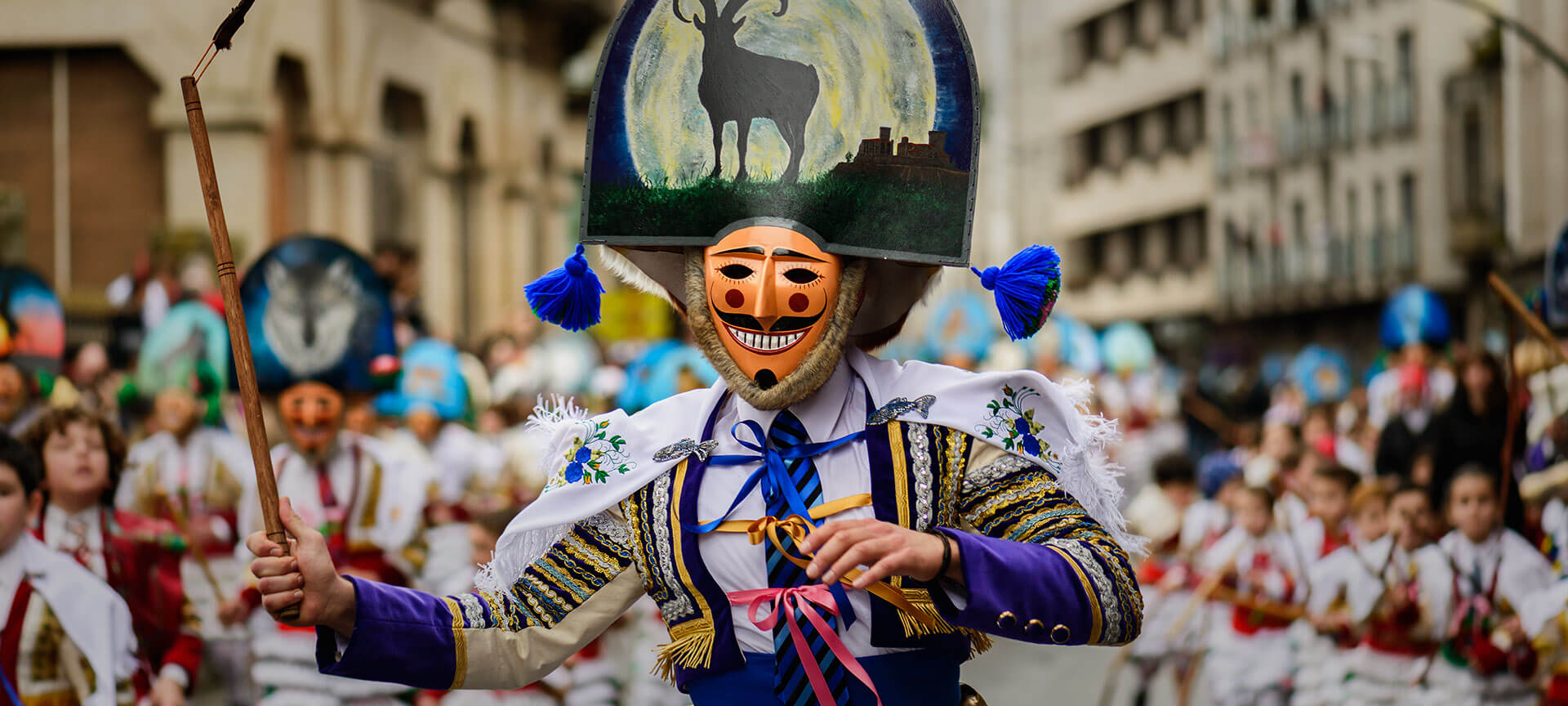
Festivals in Spain in February

Carnival festivities in Santa Cruz de Tenerife

Carnival in Águilas

“La leyenda de Tartessos” mountain bike race
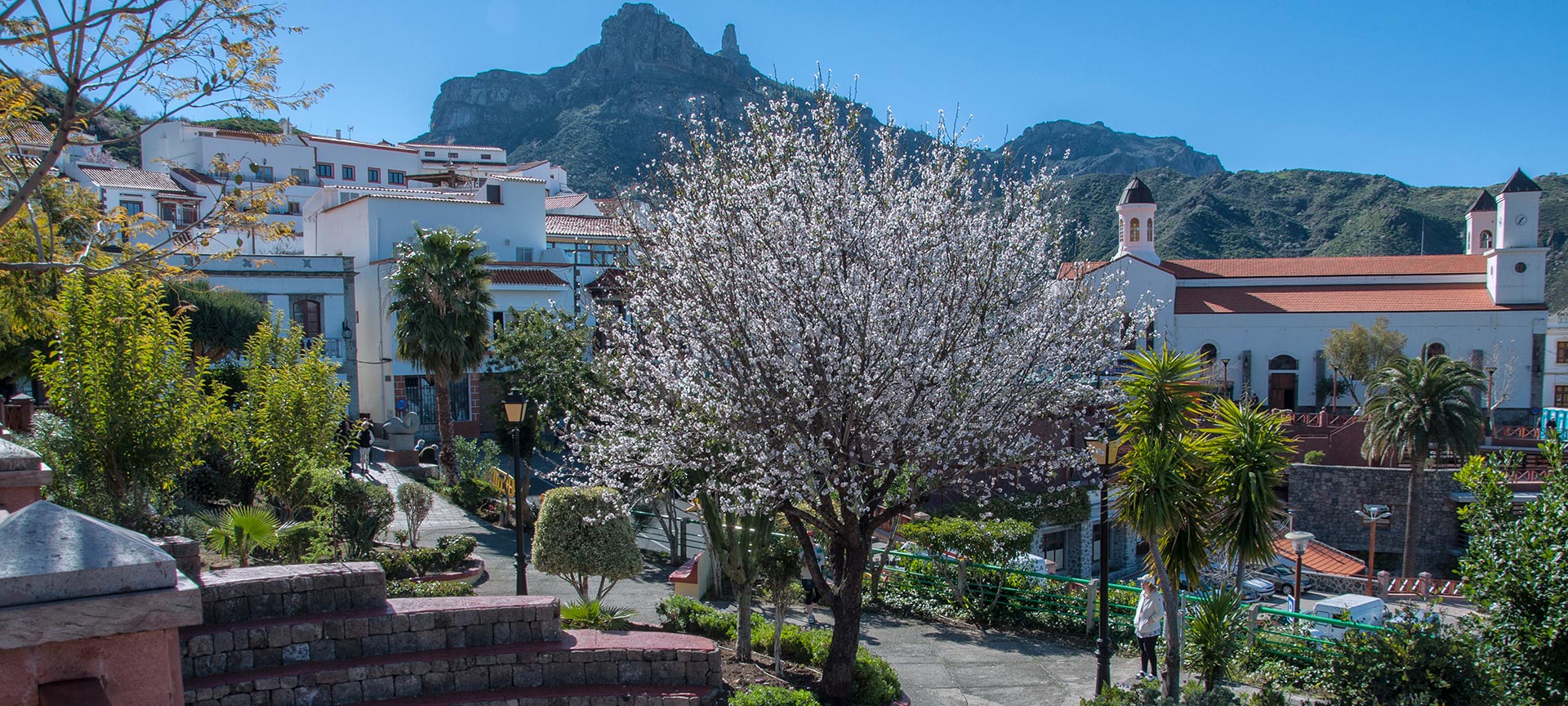
The Almond Blossom Festival in Tejeda
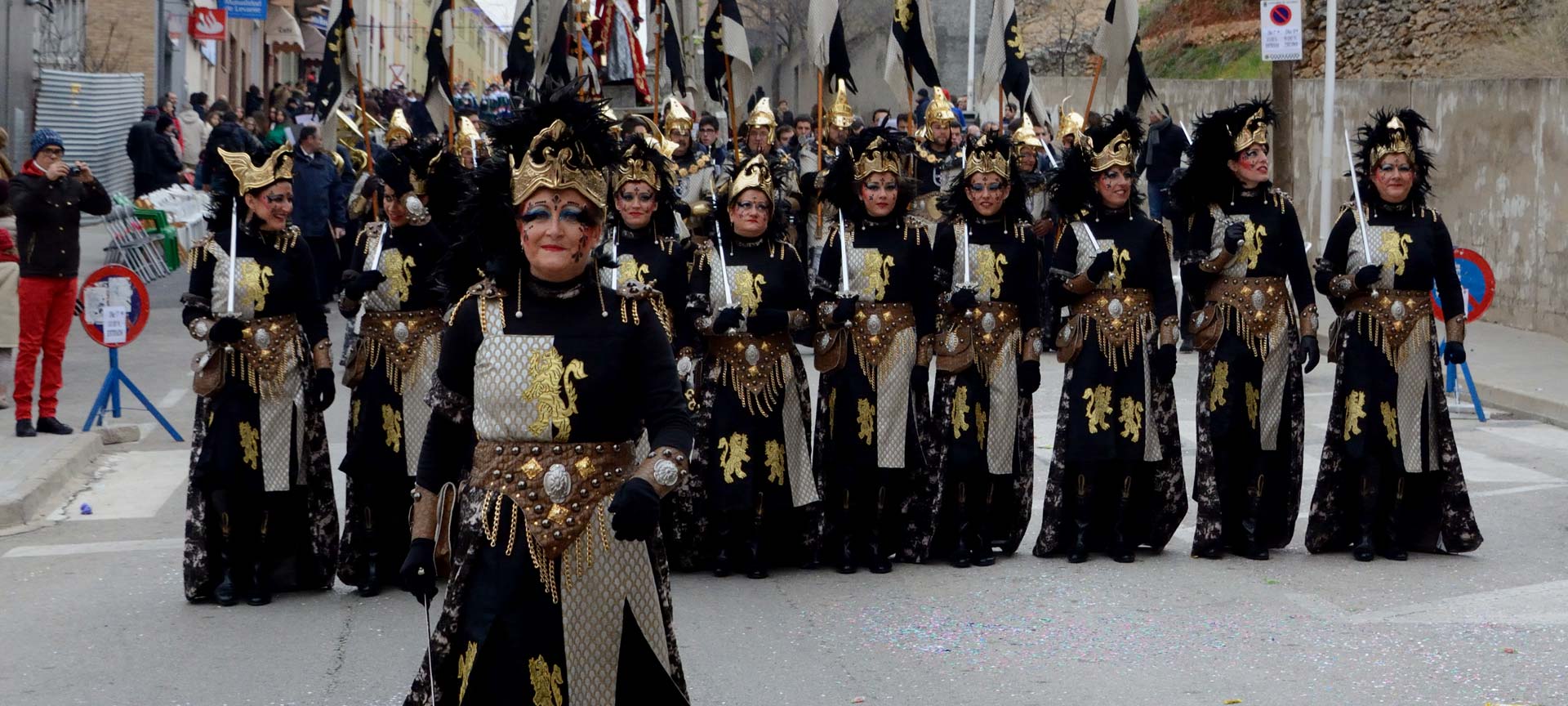
Moors and Christians Festival, Bocairent
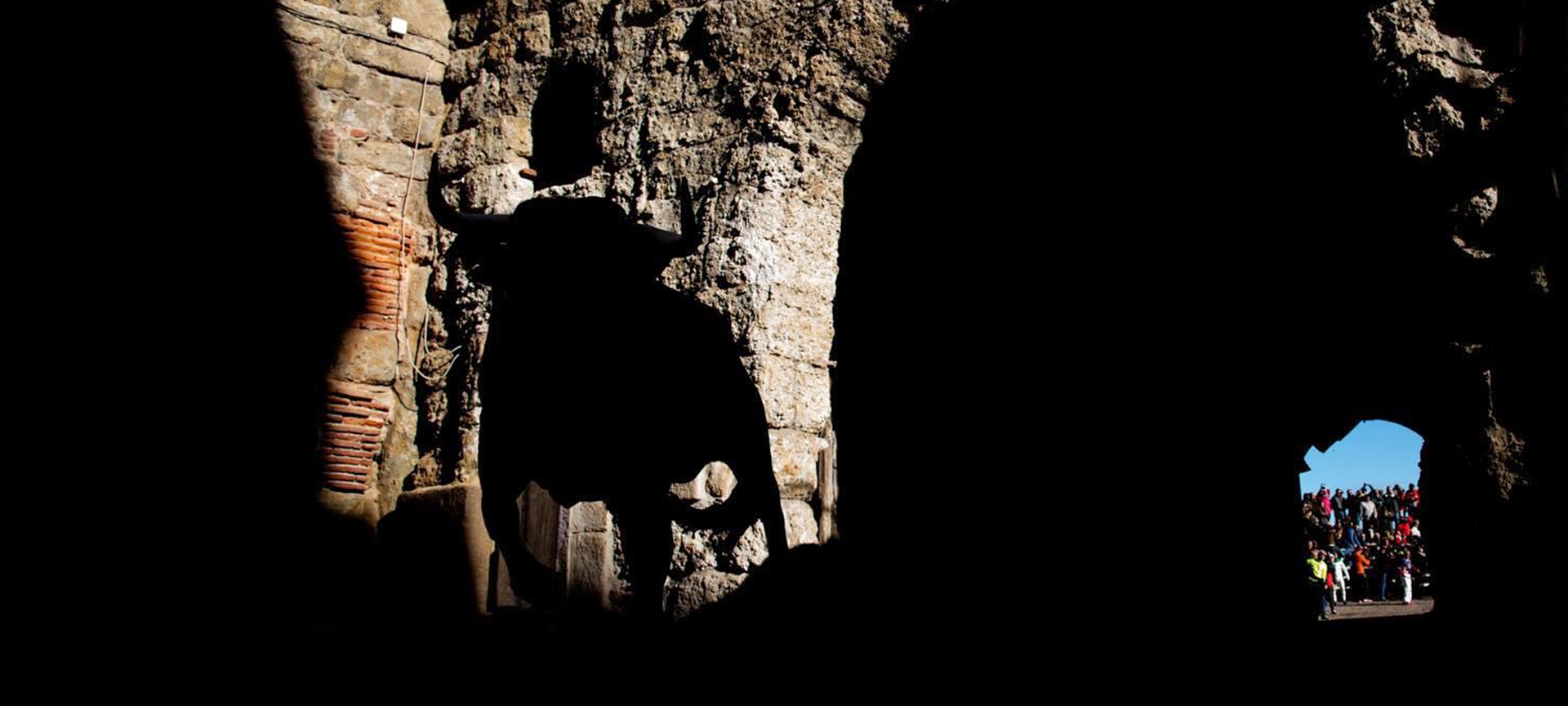
Traditional fiesta of the carnival bullfights

Badajoz Carnival
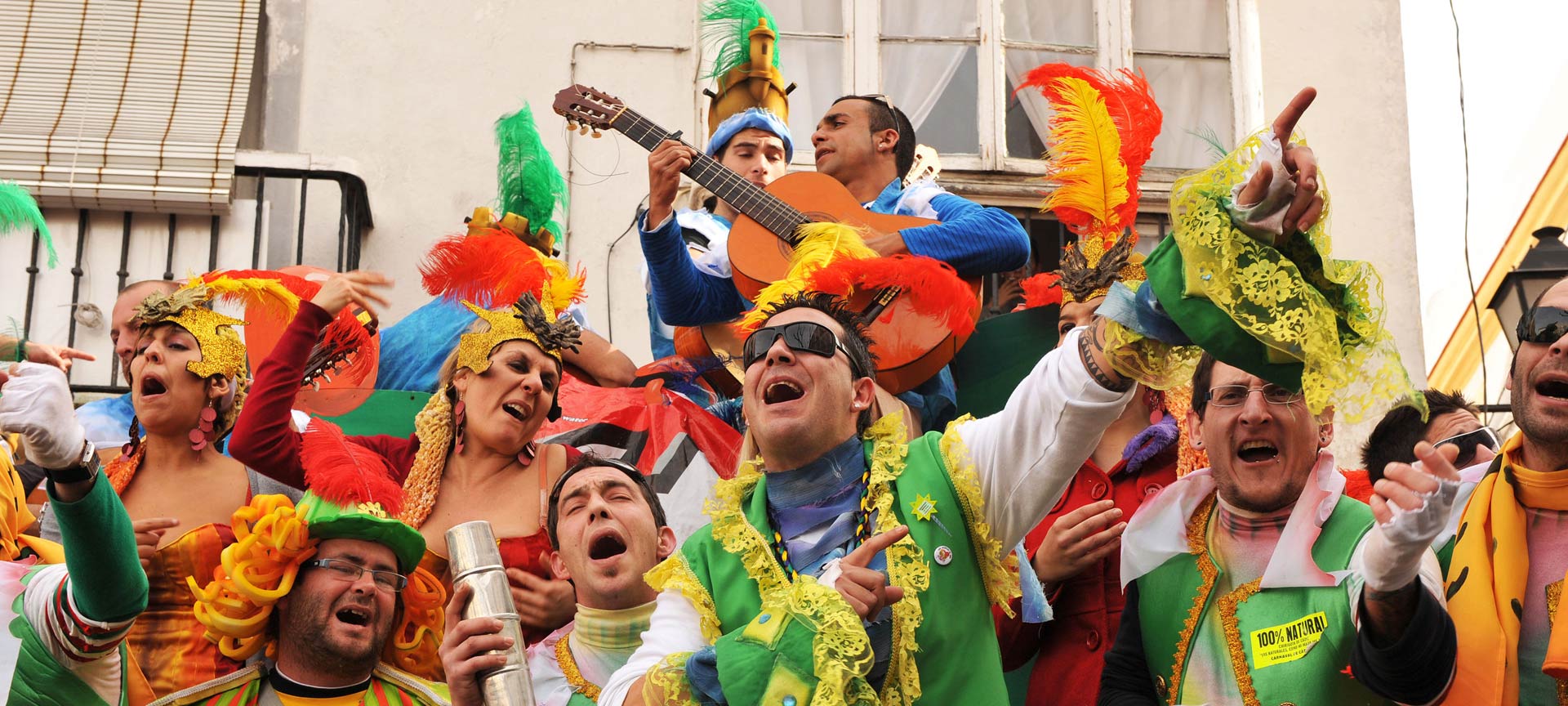
Carnival festivities in Cadiz
Carnival of Miguelturra
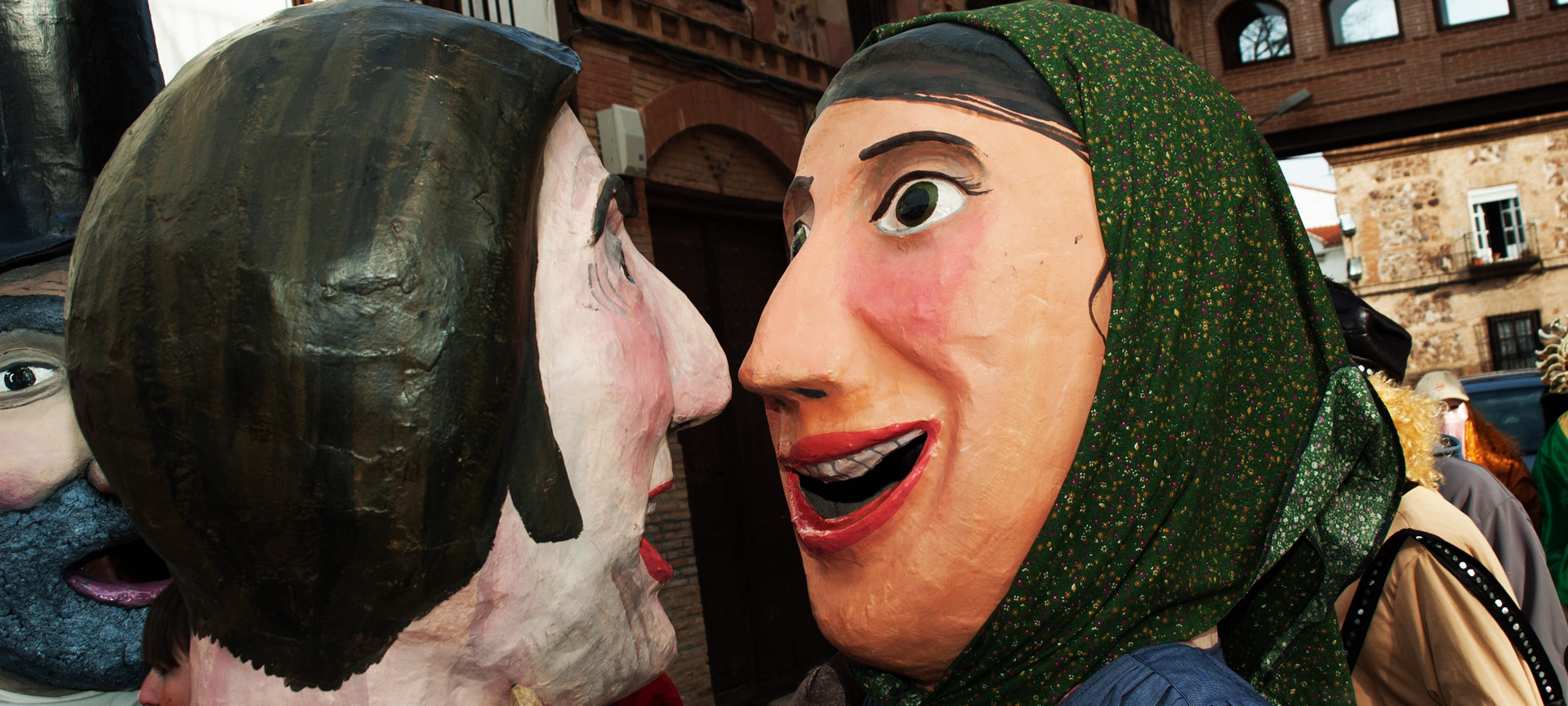
Carnival of Herencia

Animac. International Animated Film Festival

Spain in February
When we think of visiting southern European countries such as Spain, we often have high summer in mind. The blazing heat, sun-soaked beach days and often hoards of fellow tourists are what we imagine. Yet, visiting Spain in February turns this summer cliché on its head and opens a whole new world of possibilities.
Visiting Spain during this winter month allows you to see a whole other side of the country. Whether it’s attending some of the most captivating festivals, skiing in one of Europe’s most southerly resorts or seeing world-renowned landmarks without the need to wait in line.
Let’s take a closer look at Spain in February and how trips to Spain in the second month of the year will change your perception of what winter breaks in southwest Europe can be.
Post Contents
Where to Go in Spain in February
Jerez flamenco festival, lent carnival in madrid, las bodas de isabel segura, san cecilio festival in granada, the festival of santa agueda , weather in spain in february, things to know before you go.

Visiting Spain in February will involve travelling across the country during the coldest month of the year. Heading to the southern region of Andalucia will mean you are only a few miles across from North Africa, giving you the warmest weather in all of Spain. Southern destinations such as Cadiz, Málaga and the surrounding villages of Mijas, Ronda, and Frigiliana are perfect destinations for February in Spain.
Another region that is perfect for a February holiday in Spain is the southeast region of Almeria. Without the sweltering heat that rises in this region during the summer months, you can explore the Tabernas Desert, which is one of the only deserts in Europe. That’s why it was long used as a film set for many famous westerns, such as A Fistful of Dollars, Once Upon a Time in the West and even the 1962 epic Lawrence of Arabia.
It is not only the southern warmer regions of Spain that are great to visit in February. Cities such as the capital Madrid, Barcelona and Bilbao all have their own unique events and attractions during the month of February. Read on to find out about our favourite events in these cities!

What to Do / Best Places to Visit / Unique Experiences in Spain in February

One of the most famous cultural exports from Spain is the art form known as flamenco. Based on the historic folk traditions of Andalucia, the music, dance, and artistic expressions of flamenco are Spain at its best.
Throughout February, the city of Jerez plays host to the Flamenco Festival, a month-long celebration of flamenco. Performances are held within the Villamarta Theatre all month long, giving you the perfect opportunity to see the flamenco dances performed by professionals.
Along with the performances, the Flamenco Festival offers lessons ranging from total beginner to intermediate, which further adds to the festival’s allure.
Spain in February marks the beginning of carnival celebrations in honour of the beginning of lent. Although many cities across Spain have their own celebrations, it is the carnival in the capital Madrid that really takes first prize.
During this time, the streets are filled with music, colour and all-around celebrations. The city really comes alive and shows visitors just how vibrant the streets of Spain can be. As February is a quiet month for tourists, you are able to enjoy the fruits of the lent carnival without too many fellow tourists. This will give you a far more authentic experience of celebrations.
The city of Marbella on Spain’s southern Costa del Sol is a rewarding place to visit during the month of February. Although a highly popular city and region during the summer holiday season, Marbella, at the start of the year, has its own undeniable charm. Free from the summer crowds, taking a trip through the Costa del Sol in winter allows you to freely soak up the best of the city. With cooler temperatures, the hills and villages surrounding Marbella make for incredible hiking routes during February. Trekking past the idyllic villages of Istán, Serranía de Ronda and El Juanar is far less challenging at this time of the year.
Festivals / Special Events in Spain in February
Don’t miss our exclusive offers subscribe today.
For the ultimate travel inspiration, local insight straight from our expert Local Designers and exclusive offers you won’t find anywhere else from Designer Journeys, sign up today! Don’t miss out.

The festival of Las Bodas de Isabel Segura, which translates as The Weddings of Isabel Segura, is one of Spain’s oldest events. Taking place in the town of Teruel, the festival of Las Bodas de Isabel Segura celebrates the love story between Don Diego and Isabel during the early 13th century. Their mummified remains were found in the San Pedro Church and have sparked the imagination of locals ever since, resulting in the long celebrated festival of Las Bodas de Isabel Segura.
On the third Friday of the month, the town explodes into a three-day medieval festival. Medieval markets are set up, and crowds gather in medieval costumes, complete with battle reenactments and more.
Located in the foothills of the Sierra Nevada mountains, the city of Granada hosts the San Cecilio Festival on the first Sunday of February. This festival celebrates the local legend of Saint Caecilius, the patron saint of Granada, who was killed and martyred by the occupying Romans.
Taking place in the famous gipsy quarter of Sacramonte, the festival includes day-long celebrations. With lots of partying, food courts and live flamenco performances, San Cecilo is a feast for the senses.
The Festival of Santa Agueda takes place on the closest Sunday to the 5th of February in the town of Santa Agueda. The festival celebrations, known as the women’s festival, dating back to the 13th century, when the women of the town entertained invading Moors while the men reconquered the fortress.
The Festival of Santa Agueda includes a huge array of performances by the women of the town. These take the form of traditional singing, dancing and street-wide parades.
Planning to Visit Spain in February?
Designer Journeys’ network of in-destination Local Designers will use their expert knowledge, local insight and travel planning skills to design your ultimate Spanish experience. Begin designing your journey today!

Covering an area of nearly 200,000 square miles, the weather in Spain in February can vary depending on where you are in the country. Overall, the mainland’s temperature ranges, on average, between 4°C and 18°C.
In one of the highest capitals in all of Europe, Madrid in February will be dry, but winter snowfalls aren’t rare. During the early mornings and late nights, however, temperatures drop low, and it can become very cold. Barcelona, on the other hand, lies along the lowland coast and has the sea lapping its shores; this usually keeps temperatures relatively pleasant.
The southern region of Andalusia is mainland Spain’s warmest region in February and can feel pretty warm. Cities such as Seville and Malaga are some of Spain’s hottest cities in February, with average temperatures of around 18°C. For even higher temperatures in winter, head to the Canary Islands, the archipelago off the coast of northwestern Africa.
- The currency in Spain is the Euro. At the time of writing, USD$1 is equivalent to €0.93.
- Travellers from outside of the EU will require a short-stay visa: this is the general visa for tourists and allows you to stay and travel through Spain for 90 days.
- Eating practices in Spain usually happen quite late in the day. Lunch is eaten at around 2 pm, and dinner can be eaten as late as 9 pm.
- Most shops and businesses close between 2 pm and 4 pm; this is known as the siesta.
- Spanish isn’t the only language spoken in Spain. Catalan is the primary language in Catalonia, Basque is spoken in the northern Basque region and Galician is used in Galicia, northwestern Spain.
All in all, travelling through Spain in February is a fantastic time to visit the country. Whether it’s the chance to hike through the mountainous regions under a cooler sun, dodge the crowds of tourists in the major cities or take part in Carnival, February has it all. To see what Spain in February has to offer, book a customisable tour through Spain with Designer Journeys , perfectly curated to match your every need. To get the best tour customised to your own needs, contact our Local Designers in Spain .

Matthew Lewis
Hi! I’m Matt, a UK-based writer with a passion for travel, music and history. After spending my formative years in the world of music and drama, I set my sights on finally seeing what was beyond the horizon. Spending over a year exploring South East Asia and beyond, I've taken all that I've seen and experienced and aim to excite others to make the same plunge! When I'm not spinning the globe searching for my next adventure, you’ll find me in the studio with guitar in hand.
Greece in August
Travel to fiji from australia: the perfect itinerary, you may also like, a guide to the best food and....
From the beachside haunts of Barcelona to the tapas culture of Madrid, the hustle and bustle of the tourist capitals of Spain could be considered a bucket list essential. With thousands of…
Madrid Travel Guide
Trips you may like 4-Day Whistle-Stop Barcelona On this 4-day trip, you will discover Barcelona, the capital of Catalonia. This cosmopolitan, Mediterranean city is filled with Roman remains, medieval quarters and the…
Tapas: Your Next Best Reason to Tour...
Spain in june, these spanish cities will reveal the architecture....
While you may not identify as an ‘architecture buff’, if you are a lover of travel, then the appreciation of beautiful buildings goes hand-in-hand with exploring new destinations. Within each stone a…
Spain in July
Spain in december, spain in march.
As the winter frosts begin to thaw and spring is on the horizon, Spain in March is a time for looking ahead and capturing the best of both sides of Spain, both…
Spain in August
Discover all there is to know about Spain in August and connect to one of our Local Designers to plan your trip today.
Everything You Need to Know About Andalusia...

Unlock your next trip
- How it Works
- Become a Local Designer

All Destinations , Europe , Spain
18 epic places to visit in spain in winter.
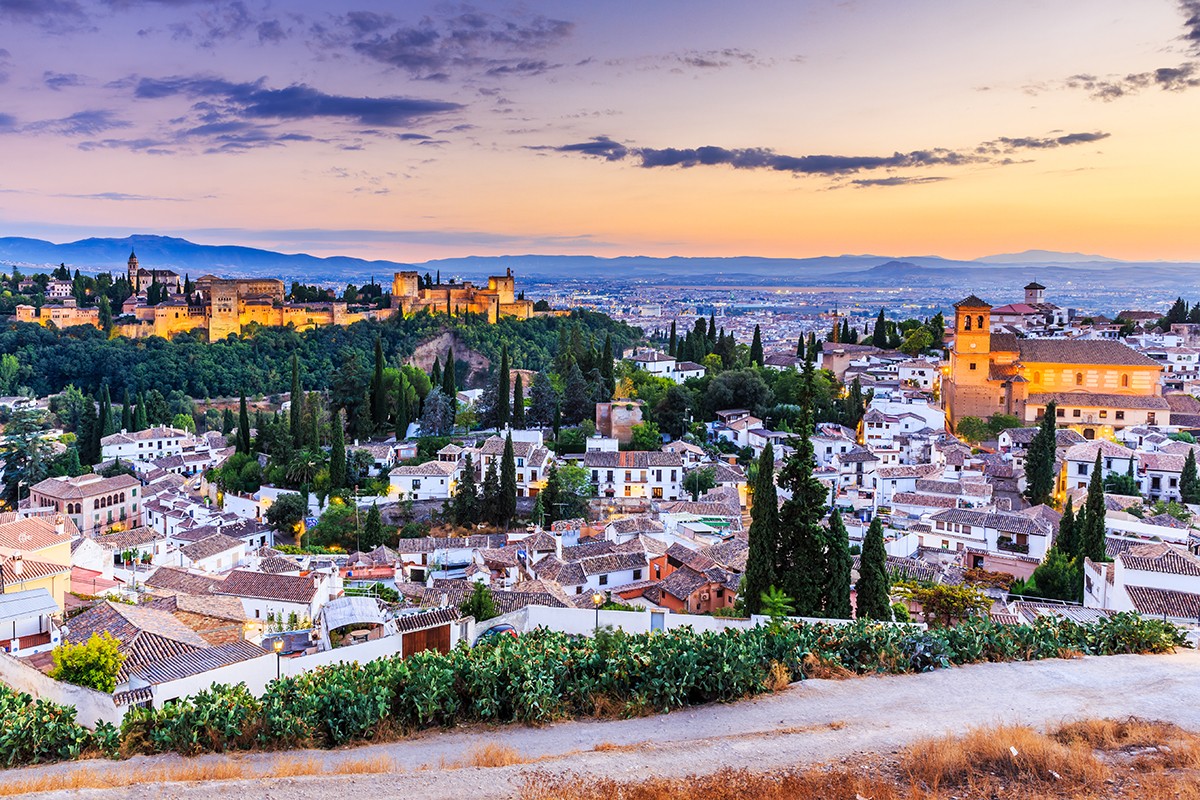
Spain in winter? You might think that it doesn’t sound quite right. Spain’s one of the world’s most popular destinations, but most people consider it solely a summertime place. It’s a country with beautiful beaches and a laid back culture, but holidays should only take place there from May to September, right?
Wrong. Spain in winter is a great idea. The country has ski slopes – they aren’t as big as those found in the Alps, but they’re certainly ski-able, and there are even some locations where you can enjoy the snowy mountains and temperatures in the mid to late teens in the same day.
There are also relatively warm places in Spain in winter – especially along the south coast and the islands. The Baleriac Islands (Ibiza, Menorca, Majorca) are about the same temperature as mainland Spain during winter, but the Canary Islands, off the coast of Africa, have year-round warm temperatures.
Another perk to Spain in winter? No crowds! The country gets very busy during the summer tourism season, so visiting when everybody else isn’t is a blessing.
A lot of Spain is still on my bucket list – but I did go to Andalusía last Autumn, and Madrid in February, and started to realise how lovely visiting Spain in the off-season was. So, I thought I’d ask some fellow travel bloggers to share some of their favourite places to visit in Spain during the winter months.
If you’re thinking of going on a Spanish holiday in winter, here are some destinations that you should consider…
Places to visit in Spain in winter
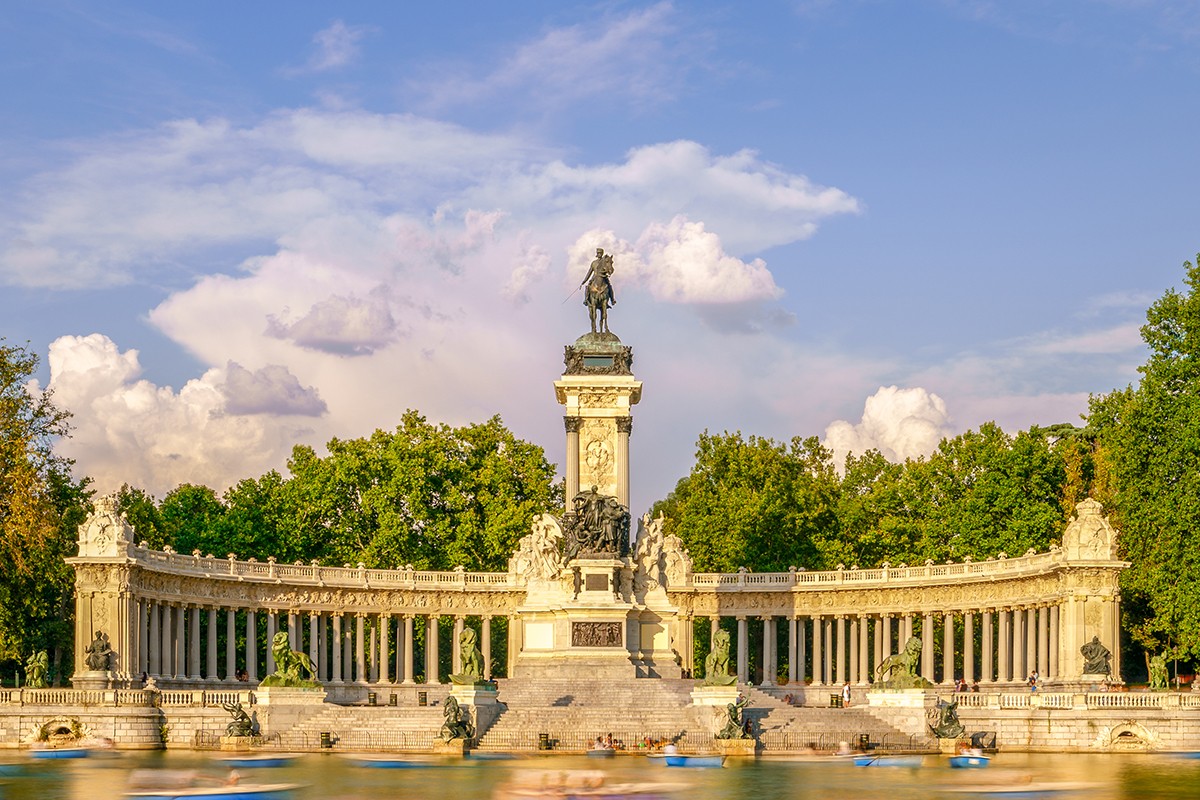
I’ll start with the capital, and somewhere that I experienced first-hand last winter.
Madrid in winter is warmer than northern Europe – I walked around wearing a coat in February, but no extra winter woollies were needed and I often found myself too hot. That being said, winter isn’t its finest weather – it was a bit grey during my stay in the city. Nighttime lows are around 3°C and highs are up to 12°C.
However, many of Madrid’s attractions are deeper than surface level, and to me, it really didn’t matter that it was a little bit grey. A Madrid walking tour details the entire history of the city, which is fascinating, and I also recommend a Spanish inquisition tour to learn more about this brutal period of history.
There are plenty of museums to visit in Madrid, and if you do have a sunny day, Retiro Park is lovely for a stroll. And then, of course, Spanish tapas and wine can be enjoyed year-round!
Most attractions in Madrid can be enjoyed in the winter just as much as the summer – and you have the added benefit of it not being sweltering hot for sightseeing!

If you’re searching for a winter getaway in Europe, look no further than Barcelona! The city has very mild weather in winter with temperatures ranging between 8-15°C, which is perfect for sightseeing. Since rain is not common during the winter months and most of the tourist crowds have already left, it’s easy to see why Barcelona is one of the best places to visit in Spain in winter!
The Basilica de la Sagrada Familia is one of the most famous landmarks in Barcelona, designed by Antonio Gaudí. Although the basilica is still unfinished, it’s possible to visit it, but due to its popularity, you should buy a ticket well in advance (even in winter, this is one of the most popular attractions in Europe). You can find many other amazing Gaudí buildings in Barcelona, such as Casa Batlló, Casa Milá and Parc Güell. If you have time, it’s worth seeing them all!
No visit to Barcelona is complete without strolling on Las Ramblas and visiting the Gothic Quarter. Apart from the famous sights, the local food is also one of the highlights of Barcelona. Having a delicious paella or some tapas with a glass of sangria is one of the best ways you can finish your day! 3 days in Barcelona is enough to see the main sights, but you can easily spend weeks in the city without getting bored.
By Krisztina from She Wanders Abroad
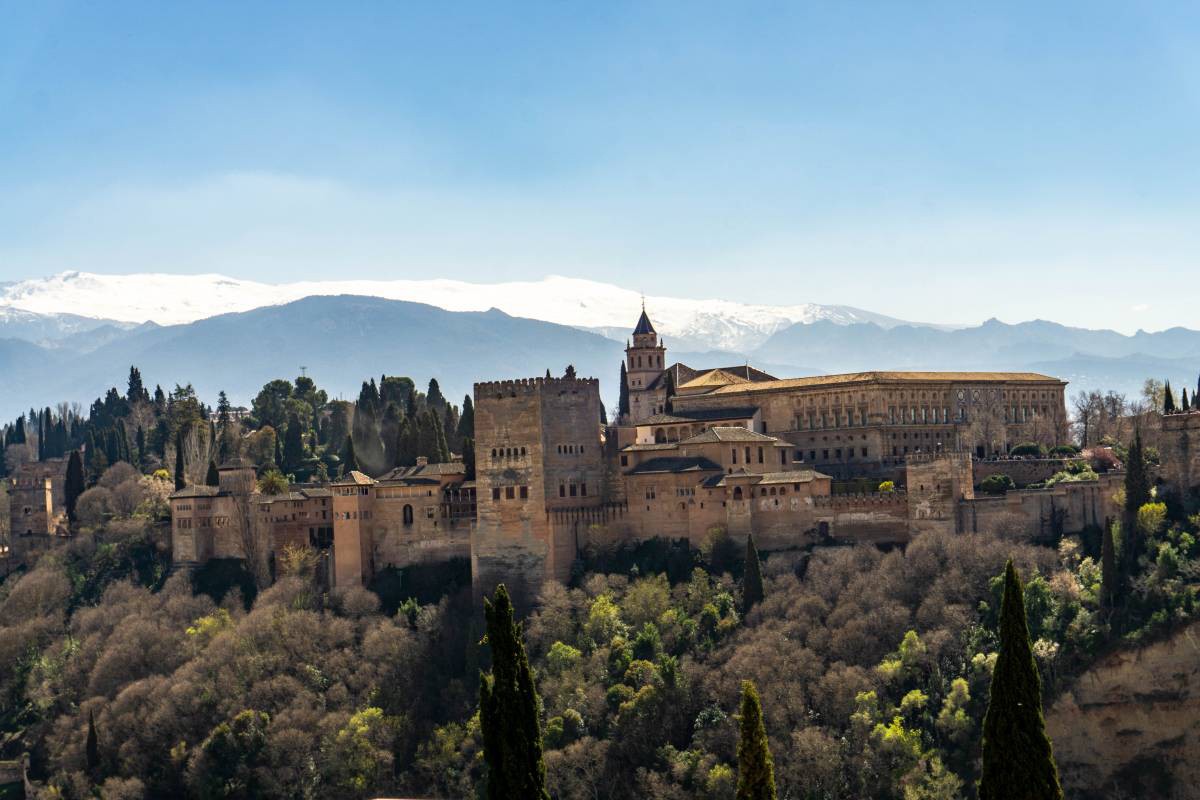
One of the best places to visit in Spain during the cooler winter months is the city of Granada located in the Andalusía region of the country.
Perfect as a standalone city break or as part of a longer trip through Southern Spain , Granada experiences high temperatures of around 13°C in December to February and low temperatures of around 3°C. This means that it’s quite pleasant to be out and about during the day, particularly compared with other destinations in Spain!
Granada is a great place to visit year-round with its unique tapas culture, the spectacular Alhambra complex, the cave houses and flamenco culture of Sacromonte and the incredibly interesting Moorish history, especially in the Albaicin – the historic Arab quarter.
During the winter months, you can combine a trip to Granada with skiing or other winter sports in the nearby Sierra Nevada Mountains or enjoy some of the Christmas markets that take place in the city.
Visiting in winter also means that some of the popular attractions like the Alhambra are not as busy as during the summer months and you are able to enjoy them with fewer people around.
Don’t forget to check out some of the coolest hotels in Granada when you’re booking your trip!
By Michael from The World Was Here First

Seville is the sunny capital of Andalusía, and one of the best spots to enjoy winter in Spain. Seville is amongst the warmest cities in Spain, and even in Europe during winter, with average temperatures ranging from 8°C – 17°C. Christmas is still very much celebrated here – so it’s a great city to enjoy festive vibes if you want to escape the cold weather!
When in Seville, don’t miss Plaza de España, an incredibly picturesque square. The beautiful bridges and ceramic tiles inside this square are absolutely captivating, and you can easily take hundreds of photos of the area. I recommend using some wide-angle lenses to get the best results – such as these lenses for Sony A6400 .
During your time in Seville, don’t forget to visit the Royal Alcázar, the historic Seville Cathedral, and the Giralda Tower. You’ll also see lots of gorgeous festive lights in the streets surrounding these landmarks! The Feria del Belén de Sevilla is another place not to be missed — it’s the biggest Christmas market in town, and an excellent place to learn about the local culture and traditions.
Lastly, if you visit in December , be sure to catch the magnificent Christmas concert performed by the Royal Orchestra of Seville and the Christmas parades in the city centre organized by the Royal Postmen (Reales Carteros)!
By Jiayi from The Diary of a Nomad
Sierra Nevada
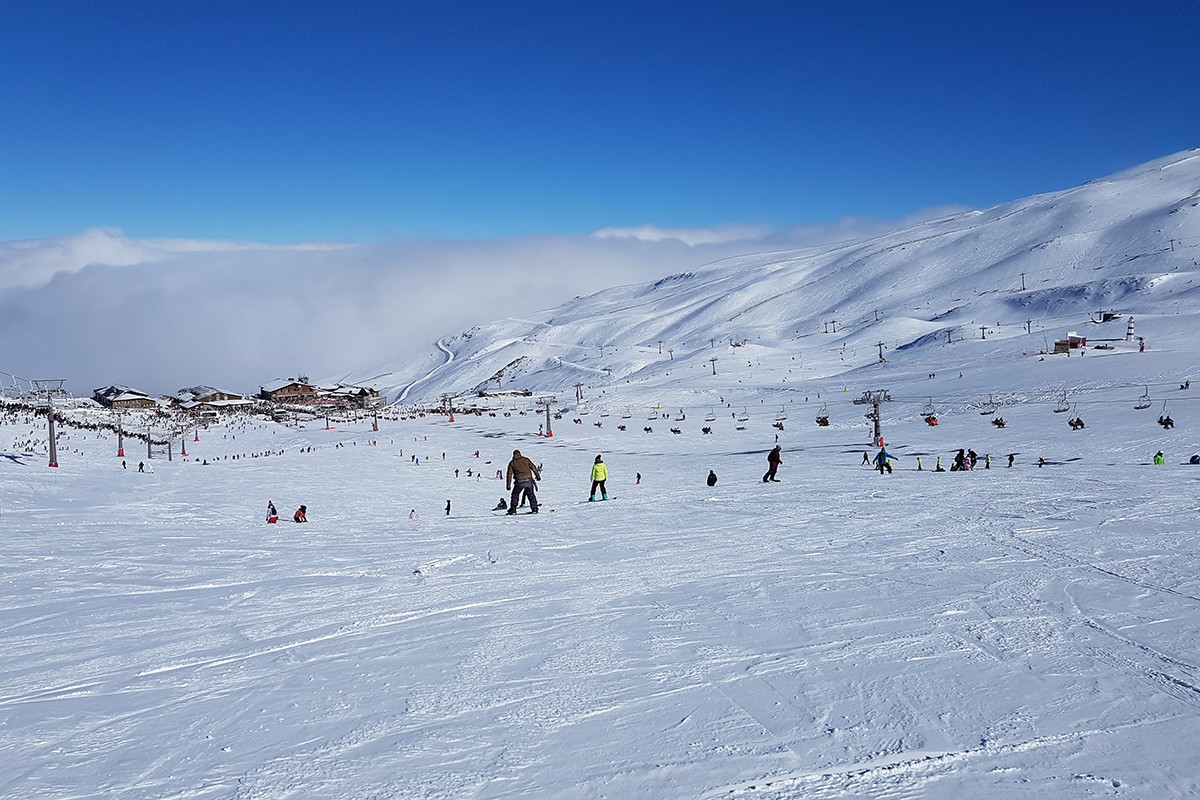
The Sierra Nevada is one of the ultimate places for winter in Spain, especially if you like a snowy winter. Home to the most southerly ski slopes on the continent, it’s popular among travellers and locals from southern Spain who visit to spend the weekends on the skiing slopes.
You’ll find some of the highest peaks in Spain here, and one ski lift goes almost to the top of the 2nd highest in the National Park (and 4th highest in Spain), Pico de Veleta (3398m). From there you can see over to Mulhacen, which is the highest peak in the Iberian Peninsula.
The village of Sierra Nevada is the perfect winter paradise with snow, restaurants, and mesmerizing views. No matter where you stay in the village you can walk around. It’s also a great base for a day trip to Granada – which we’ve got down as another Spain in winter destination!
Average temperatures in the Sierra Nevada are between 3 and 7°C, and sometimes you can see people skiing in t-shirts on sunny days.
By Linn from Andalucia Hiking
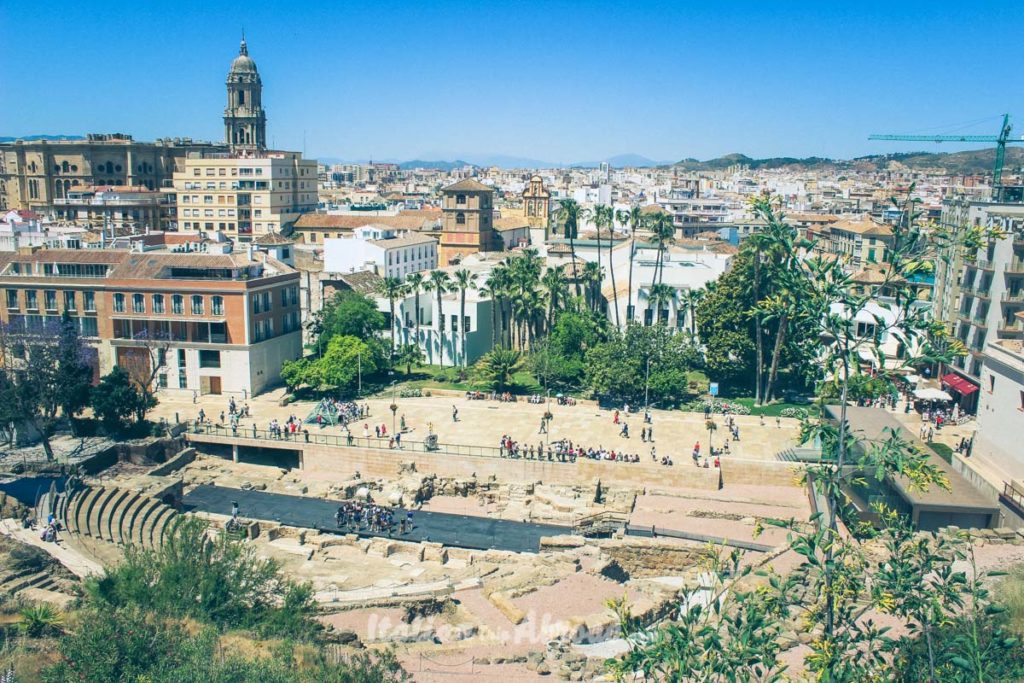
While much of Europe freezes, Malaga in the Andalusía region is the ideal Spanish city to chase the sun. With average temperatures about 18-20°C from November to February, you’ll be able to avoid winter here!
During the cold months, the sun warms up the city a lot and mitigates the temperature thanks to the sea breeze. Malaga gets over 300 days of sun per year, with not much rainfall. The coldest and relatively wettest months are January and February.
The warm weather makes Malaga perfect for a winter escape, but this isn’t the only appeal. In Spain, Christmas traditions are really important; Malaga city centre transforms over the festive period, with glam lights adorning all the streets. Enjoy the shopping in Calle Larios, the main street full of boutiques and cosy cafes. The Christmas markets in the city centre create the festive vibes and the concerts all around the squares entertain people while shopping.
If you want to visit Malaga in winter, you’ll also be able to enjoy a fantastic New Year’s Eve celebration. In Spain, it is tradition to eat 12 grapes, one for each chime of the midnight bells, to bring good luck for the next year. There is no better place where to celebrate it than Plaza de la Constitución.
Malaga could be the best sun destination in Europe for those who want to run away from the cold winter but stay in Europe. You can even enjoy the beaches and seaport over winter – or wait till March for an early swim in the Mediterranean Sea.
By Alessia and Toti from Italian Trip Abroad

The lively town of Marbella in Southern Spain is the perfect place to enjoy a warm winter break. During these months, Marbella’s daily temperatures range from around 17 to 23°C. This weather is certainly warm enough for some of the many activities on offer in and around Marbella !
Golfing is highly popular, but there are excellent hiking trails near the town, as well as opportunities to sail, play tennis or enjoy relaxing walks along the beach.
The nightlife is quieter than in the peak summer months, but each evening the charming 15th century Castilian Square in the heart of the Old Town still comes to life with local musicians and the chatter of other diners. The square, called Plaza de los Naranjos, is also the perfect place to catch early morning rays over fresh orange juice and hot churros.
The Old Town, known in Spanish as Casco Antiguo , is made up of tiny laneways, and there’s some fantastic boutique shopping on offer. The buildings are all traditional Moorish architecture and many of covered in tumbling bougainvillaea.
Marbella is perfectly positioned to explore other areas in Andalusía too, from the white-washed villages in the hills to the Sierra Nevada mountain range. In fact, you could spend the morning skiing there, before heading back to Marbella for the afternoon to catch some rays!
By Claire from Stoked to Travel
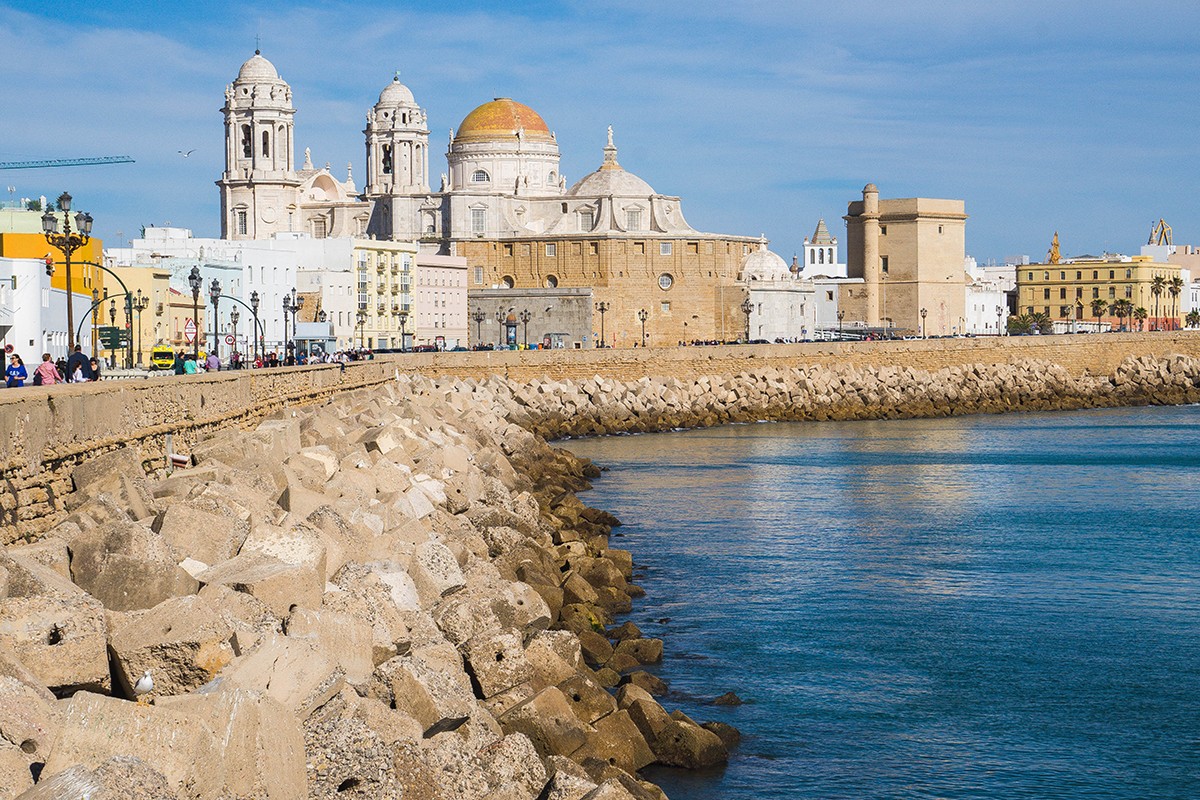
One of the best cities to visit during winter in Spain is the city of Cadiz, which has 300 sunny days a year on average. With temperatures staying above 10 degrees in winter (minimum of 10°C in January and maximum of 16-17 °C in all the other winter months), Cadiz is a great place to get some winter sun.
Cadiz is a historical town, the oldest attested in Europe, born in the 8th century BC. However, its spirit is very young. The best place to experience the buzz of the town is in the fish market where, in the morning, you can go and buy fresh fish and seafood at very competitive prices. At lunchtime, the same fish is cooked and served at the tapas bars and restaurants adjacent to the market. This makes it one of the prime spots to not only enjoy probably the best fish dishes in Cadiz, but also to interact with the locals.
Whilst Christmas markets are not that popular in the south of Spain, it is worth visiting Cadiz in winter for the annual carnival, which is considered to be the second-best in the world after Rio. Held in the second half of February, the celebration lasts for a week. During this time the city’s streets are filled with performers, parades, excellent street food and enthralling firework displays.
By Joanna from Andalucia in my Pocket
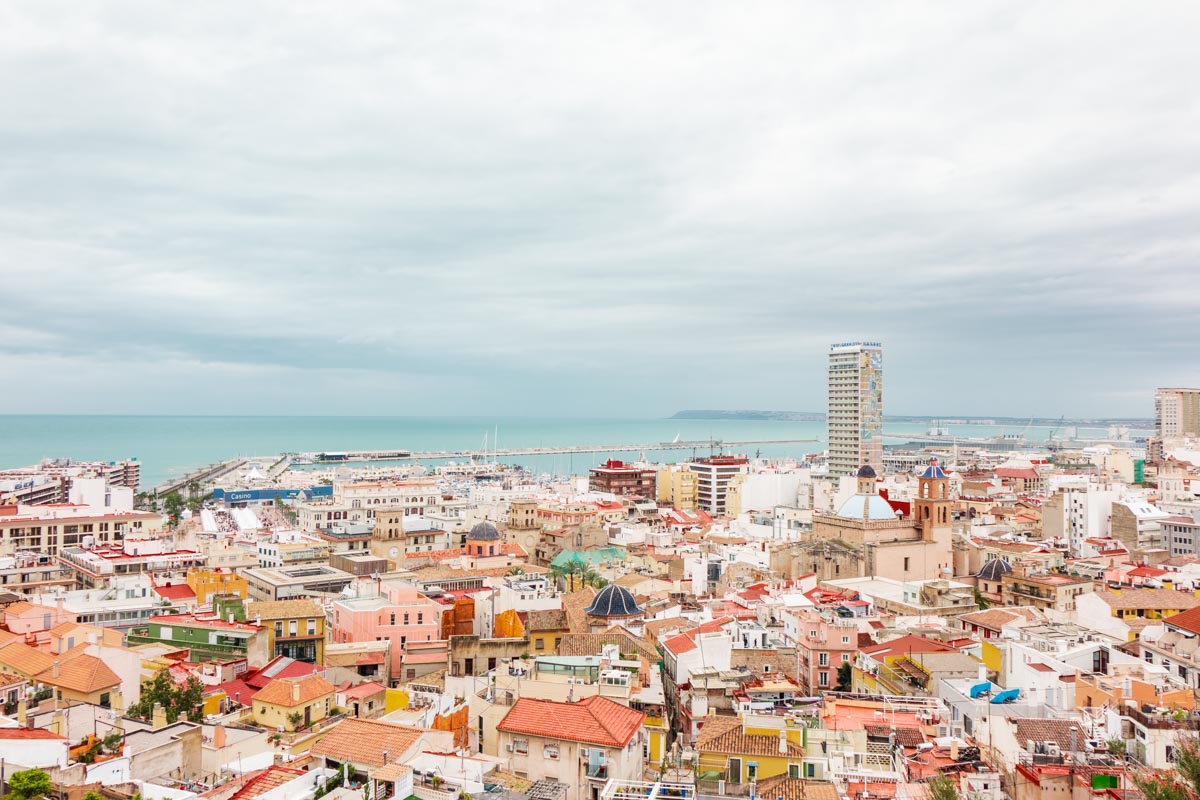
If you want to spend your winter in the Spanish sun, consider visiting Alicante.
This Mediterranean city nestled in the southeast of the Iberian Peninsula boasts 3,000 hours of sun each year with an average temperature rarely dropping below 18°C.
There are plenty of things to do in Alicante as the town is rich in history, has gorgeous sandy beaches to have a relaxing walk along the coastline, and get lost in its colourful streets.
The main attraction of Alicante is the Castle of Santa Barbara, which overlooks the sea and part of the town. Santa Cruz is a little neighbourhood adjoining the castle featuring white-coloured houses with colourful doors, balconies, and windows. You can also find many notable cathedrals, churches, and a couple of museums too.
Moreover, the perfect location of Alicante enables you to explore the charming little villages and towns in the Costa Blanca region, including the famous Benidorm, Altea, Villajoyosa, and Torrevieja, to name a few. Travelling to those towns is possible via a tram offering splendid views of the region.
By Baia from Red Fedora Diary

If you want to get into the festive spirit with a winter getaway but don’t fancy the freezing temperatures of places like Germany and Scandinavia, you might prefer a trip to the Spanish city of Valencia .
Christmas markets and winter illuminations still light up the city, but with daytime temperatures averaging somewhere between 10-15°C, you won’t have to wrap up quite so much. Take time to enjoy festive treats like turrón and roscón de reyes (king’s cake) or while away the hours in one of the city’s chic tapas and wine bars.
When you’re not inside eating delicious dishes, explore Valencia City Hall, La Lonja de la Seda, the City of Arts and Science, and Valencia Cathedral, or head to the annual Christmas funfair and circus.
Valencia is also renowned for throwing some pretty spectacular festivals in winter including The Three Kings Parade. This is held on the 5th of January in the evening each year. There’s also the San Vincente Mártir Festival on the morning of the 22nd of January.
Another great thing about visiting Valencia in winter is that there is hardly any rainfall. So, while it’s worth packing an umbrella just in case, it’s unlikely you’ll need it as there’s only an average of 10mm of rainfall per month throughout the whole of winter!
By Chrysoula from Travel Passionate
Baqueira Beret

Spain may not automatically spring to mind when you think of skiing in Europe. However, Spain’s premier resort, Baqueira Beret, can hold its own against any of the big ski resorts in the French Alps – making it one of the best places to visit in Spain in winter. As an additional bonus, skiing in Baqueira Beret is so much cheaper than the Alps. The resort is snow sure, and they have snowmaking facilities as well. There are definitely more skiers than snowboarders which is a plus for the skiers!
Located in the Spanish Pyrenees, Baqueira Beret attracts a well-heeled crowd from Barcelona and Madrid – the Spanish royals have a chalet in the resort! There are a handful of family-friendly hotels entered around the main ski lift area. Spanish speakers mostly populate the resort, but everyone working in the bars, hotels, restaurants and schools will speak excellent English.
The ski runs are best suited for intermediate skiing as there are only a handful of easy and advanced runs. Advanced skiers also have a wide range of heliski options. If you want some lessons, the Baqueira British ski school can provide them in English.
The hotels and the entire vibe is family-friendly. The Spanish generally sleep in in the mornings, so there is no jostling for space on the first ski runs like in the Alps. At our hotel, children’s dinner was set for 8pm and adult dining started at 10 pm. Needless to say, we were one of the earliest adult diners in the resort!
The nearest airport is either Barcelona or Toulouse in France. From Toulouse, the resort is an easy 2 hour drive into the Pyrenees mountains.
By Shobha from Just Go Places
San Sebastian

San Sebastian is an underrated place to visit in Spain during winter. The city is close to the French border and has some of the best scenery in the country! It also has some of the most beautiful weather during the winter months.
Although it may not be as warm as Andalusía, the average temperature is a reasonable 13°C. When I visited in December 2016, I was treated to 20-degree weather, which more like a summer’s day than the middle of winter!
When you visit San Sebastian , you’ll find there are lots of things to do. With high average temperatures, it’s worth checking out the beaches here. Yes, there are two! La Concha bay is the scenic beach with incredible views out into the Bay of Biscay, while Playa Zurriola is the surf beach.
To get a fantastic vista of La Concha and the city as a whole, a hike to the top of Monte Igeldo is well worth it. You’ll also find a 19th-century amusement park at the top too!
You can’t leave San Sebastian without trying the food here either. The city has the highest proportion of Michelin starred restaurants in the world! While they might be too expensive for most, the pintxos in most bars and cafes are reasonably priced and delicious!
By Tom from The Travelling Tom

Without the summer crowds, the island of Mallorca (Majorca), Spain is a perfect place to spend a stress-free winter holiday with family or friends. Palma, the capital city, comes alive with decorated streets and festivals during each winter holiday. Stroll Passeig del Born for the most impressive sights.
The average winter temperatures hover around 16°C. While it’s cool in the winter months, the brilliant Mallorcan sunshine still makes it feel quite pleasant. You could rent a car to take in the magnificent natural beauty of the mountains and coastline – the beaches are especially spectacular when you have them all to yourself.
Base in Palma to be close to everything or rent a historic villa in one of the charming villages to feel like a local – you’ll have a lot more choice in the winter. Valldemosa, with flower boxes lining its cobbled streets, is a favourite. If you’re here at the end of winter, the beginning of Lent brings parades in many small villages with live music, festive dress, and street parties.
The almond trees that dot Mallorca start blooming at the end of January. Pink, white and rose blossoms turn the island into a stunning kaleidoscope of colour. And the traditional Mallorcan almond cake is to die for!
By Karen from Outdoor Adventure Sampler

Ibiza located off the eastern coast of mainland Spain in the Balearic islands group. It’s famous for being a party place, but there are plenty of other things to do here – especially during the winter!
Winter temperatures in Ibiza vary from averages of 16°C in January and February to 20°C in April and November – perfect weather for exploring! There are fewer tourists in Ibiza in winter, and you can take advantage of no crowds to experience the traditional Ibizan culture.
Ibiza old town is a UNESCO world heritage site that includes the winding shopping streets of the old town and 16th-century walls built to protect Ibiza from pirates long ago. At the top of Dalt Vila, you’ll have panoramic views across Ibiza town towards Formentera island.
One of the best things to do in Ibiza during the winter is to take long walks along the beaches. During winter the sunbeds are removed, and the beach is flattened ready for the next tourist season. Locals come and walk their dogs along the beach – you can act like a local and join them!
The weather is still warm enough for a sit down to admire the views out to sea as well as the picturesque beaches. The best beach for a walk during winter is Cala Gracio although the beaches of Santa Eulalia and San Antonio are also wonderful.
By Sylvie from Travels with Eden
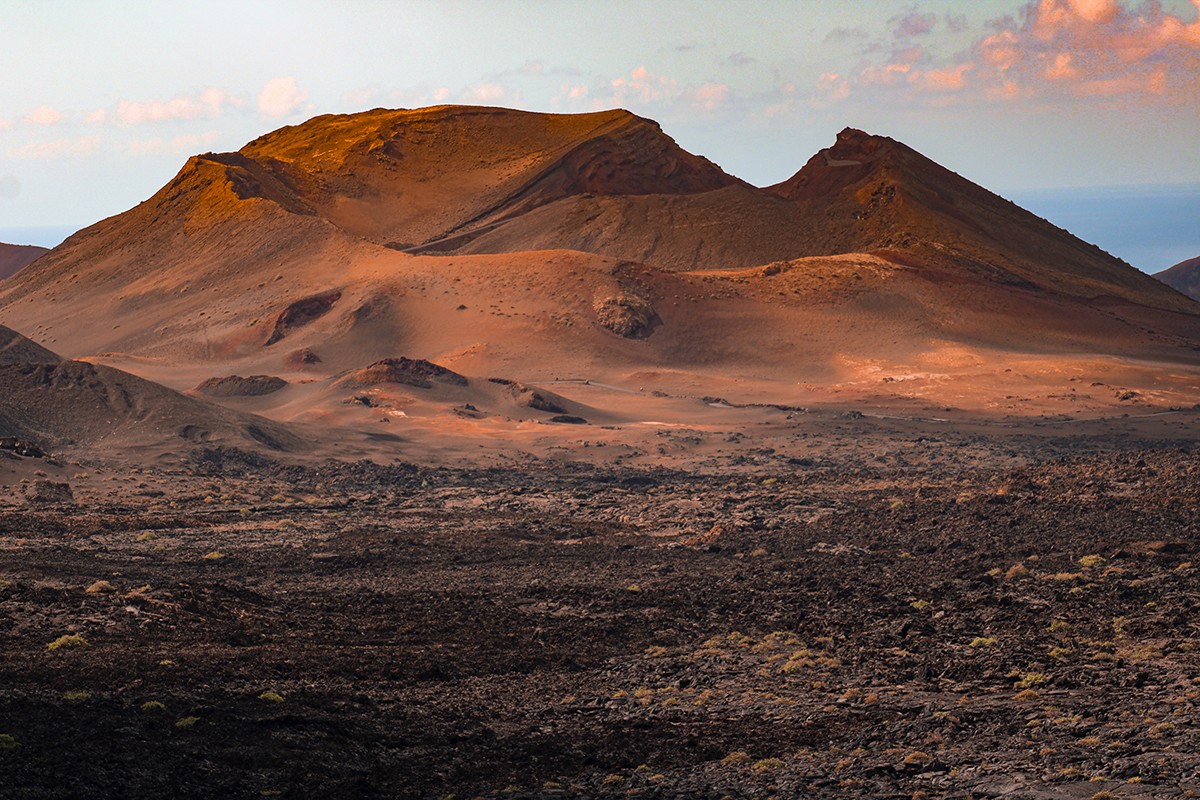
One of the best places to visit during winter in Spain is the island of Lanzarote in the Canary Islands. Renowned for its package tourism, the island is starting to change and is also beginning to attract adventurous travellers who venture there independently to gawk over the volcanic landscapes, mild weather, and delightful beaches.
Lanzarote is fantastic in winter, as it is the off-season but still somewhat warm. The average temperature during winter hovers around 20°C and while the average rainy days for this time of year are few and far between, the weather passes over the island rapidly and can bring very short rain showers throughout the day for mere minutes at a time.
Almost everything is open during the winter months, with the exception of some of the restaurants that will take a month or two off to recharge for the peak season.
Some of the best things to do in Lanzarote in winter are marvel at the volcanic, otherworldly landscapes of Timanfaya National Park, learn more about the island’s most famous resident (Cesar Manrique) and his life, and go to the Saborea Lanzarote Wine and Gastro Festival. You could also book a trip to nearby La Graciosa, the newest island in the Canaries!
There is something for everyone in Lanzarote and winter is the perfect time to experience it without the crowds and higher prices.
By Megan from Megan Starr
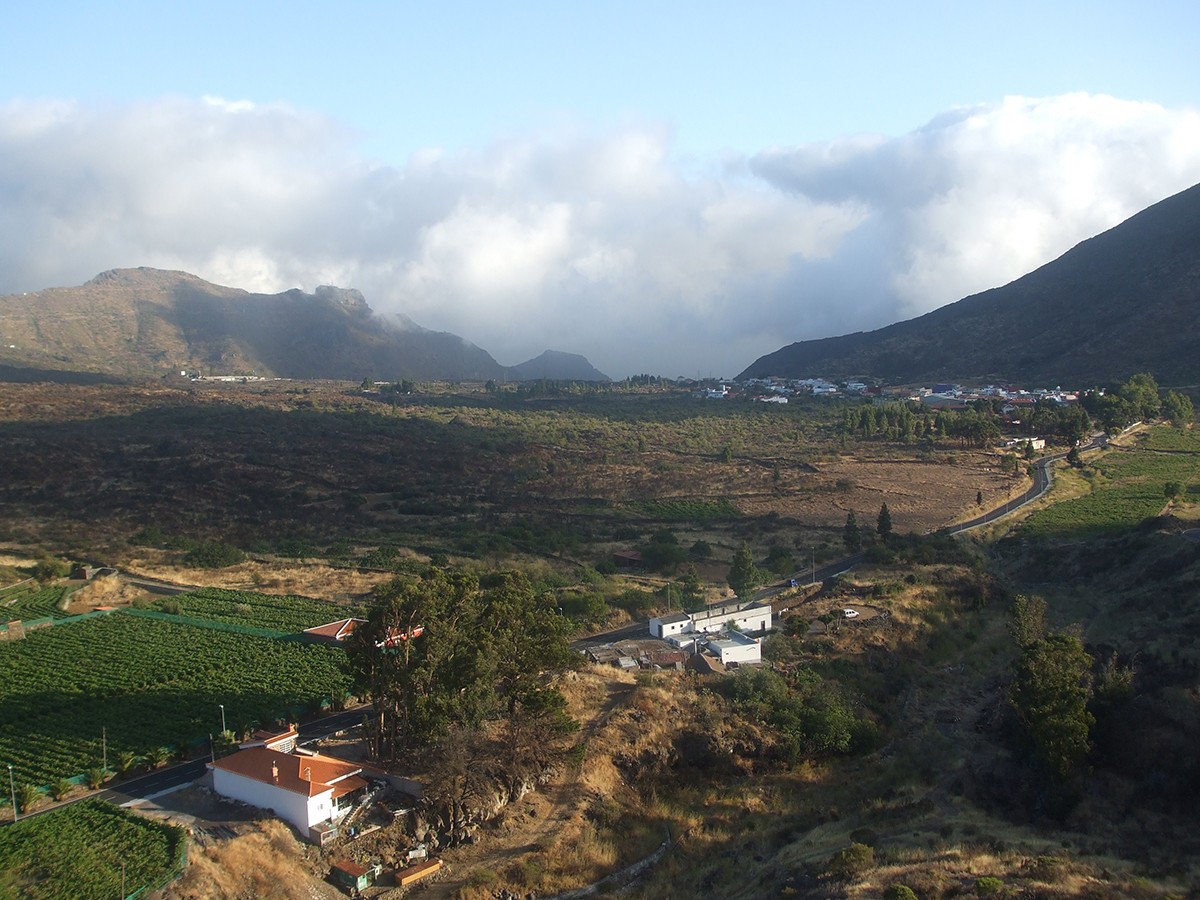
Tenerife in the Canary Islands is the ideal island destination for some winter sun. Tenerife has year-round sunshine with the temperature in winter staying around 20°C during the day. At night, the temperature drops to around 15°C, so you may need a light jacket especially by the coast.
Tenerife has many exciting things to do – it’s not all about the yellow and black sand beaches, even though they are spectacular! You can find tours for whale watching, jeep tours of Mount Teide, snorkelling with turtles or even scuba diving at one of the many dive sites on Tenerife . One awesome activity that requires pre-planning is getting the cable car to the summit of Mount Teide. This requires a permit as they only allow so many visitors per year.
Options for eating out are extensive and you can find restaurants to suit any taste, from traditional Spanish to Italian, Chinese and English cuisine. Many local restaurants offer a menu del dia which is excellent value for money. It includes three courses with tasty local dishes like tapas and paella, and some even include a free glass of wine.
The best way to get around on Tenerife is to rent a car as taxis can be expensive. Having your own wheels is a great way to see the island and its quaint mountainside villages.
By Steph and Lewis from Book It Let’s Go!

La Gomera is the second smallest Canary Island and is also named the island of the eternal spring. The temperatures are mild year-round, varying between 25C in August and 20C in January.
The winter months on La Gomera know lots of sunny days, however, when temperatures can easily rise to 23C. It’s lovely and mild, the perfect climate for an active day out and a long Spanish lunch on a terrace overlooking the sea. Another reason why La Gomera is such a great destination is that there’s no real mass tourism, the towns are authentic and quaint, the nature is stunning and the beaches are rugged and relaxed.
La Gomera is the perfect holiday destination for nature lovers as the island is home to the Garajonay national park, which is on the UNESCO World Heritage list and hosts the oldest natural forests in the world. When you see all the amazing flowers in full bloom, even in December and January, you’ll understand why La Gomera is called the island of the eternal spring. Don’t forget to visit the island’s capital, San Sebastian, with its authentic restaurants, quaint streets and lovely little church. Or drive to Valle Gran Rey for some fantastic mountain and sea views.
By Esther from Vakantie Karpathos
Gran Canaria

Gran Canaria is one of the seven main Canary Islands that are part of Spain, located in the Atlantic Ocean 840 miles off mainland Europe and only 62 miles off African Coast. Due to its proximity to the tropics, the island enjoys more than 320 sunny days, so Gran Canaria is a great choice of destination all through the year .
When most of Europe freezes in winter, Gran Canaria becomes a saviour for holidaymakers. The temperature of Gran Canaria in winter is still up an average of 22 degrees!
Gran Canaria is a miniature continent in itself. Picture yourself in Gran Canaria, and you can contemplate desert-style sand dunes, volcanic landscapes, whitewashed villages, stunning mountains and cliffs, dense forests and not to forget their azure blue flag beaches.
One of the best attractions in Gran Canaria is the famous Maspalomas dunes. Also, catch a glimpse of sunset near Faro de Maspalomas, a 19th century lighthouse and a distinctive landmark that sits next to the sand dunes.
Winter is a great time for hiking in Gran Canaria – one of the best spots that you can hike to is perhaps Roque Nublo. There’s also the photogenic Puerto de Morgan, and the mountain village of Fataga!
By Anuradha from Country Hopping Couple
Whether you want to laze on beaches or go for a ski, there’s something for everyone in Spain in winter! These destinations are all fairly easy to reach from airports in Europe. Don’t wait for summer to travel Spain – winter in Spain is just as incredible!
Pin it for later!

- New Zealand
- The Philippines
- The Netherlands
- United Kingdom
- Inspiration
- Overland Itineraries
- Packing Lists
- Travel Tips
- Working Abroad
- Accomodation Guides
- Overland Travel
- Preserving Cultures
- Protecting Animals
- Living Abroad

IMAGES
VIDEO
COMMENTS
Spain may be Europe's best-kept winter secret. This Mediterranean country enjoys a much more temperate climate compared to the rest of Europe, much of which is blanketed in snow throughout February. Spain is also the only European country that you can visit during this season where you can hit the ski slopes and lay out on the beach, so it truly has it all.
Average Temperature: Daytime temperatures range from 10°C to 15°C (50°F to 59°F), while nights can drop to 5°C to 8°C (41°F to 46°F). Precipitation: Northern Spain sees a fair amount of rain, with around 80-100mm of rainfall during February and approximately 10-12 rainy days.
Spain in February: Visit Smaller Towns . One of my favorite ways to embrace the true culture of a place is by visiting smaller towns, away from the commercialized big cities. Visiting smaller towns has a quaint charm that is really impossible to find inside the larger cities and more often represents the true culture of the area. 4. Cadiz
5. Get a thermal spa retreat. When in Spain in February, take the opportunity to pamper yourself into relaxation and spoils. Spain's thermal spas are perfect for winter cold weather. You can visit the famous hot springs of La Garriga near Barcelona, or if you love luxury, visit Hammam al Amdalus spa in Andalucia and be prepared to be pampered.
In Spain, the carnival is usually celebrated 40 days before Easter, so that it will take place by the end of February. You can visit three main carnivals while visiting Spain in February, one of which is one of the best and biggest in the world! Carnaval de Cádiz: 16 - 26 of February. Carnaval de Sitges: 16 - 22 of February.
Southern Spain, which includes Andalusia, Extremadura, Murcia and part of the Valencia region, offers the best weather in the Peninsula. Few rainy days and average temperatures that range from 57.1º F (14º C) in Málaga to 55.3º F (13º C) make the southern part of Spain a perfect destination to enjoy outdoor activities in February.
By February, Spain is still deep in winter, and the tourist crowds are sparse. Despite the often gloomy weather, there are regions like the Mediterranean coast that get little rain and avoid the chillier temps. Yes, there is sun to be had in Spain, even in February, and the lower ticket prices make it easy to book a quick winter getaway. Kathryn M.
Weather in Madrid in February. In February, Madrid experiences cold winter weather with moderate rainfall. You can expect average daytime temperatures to range between 10°C (50°F) and 15°C (59°F). Nighttime brings cooler temperatures, often dropping to around 2°C (35.6°F) to 5°C (41°F).
The average temperature for most of Spain in February is just over 5degC. Remember that those numbers are averaged out over a huge land area, however, so you'll want to find out more about the specific cities you're going to be visiting and what their climate is like in February. Although Christmas and New Years' are officially over by ...
Standing 3,718 meters above sea level, Teide National Park is a unique composition of craters, volcanoes, and rivers of petrified lava. In addition to numerous festivities, there are plenty of things to do in Spain in February. For instance, you can visit Granada and ski in the nearby mountains. The Sierra Nevada, which is close to this historic city, sees snow cover for the whole month ...
Temperature range: 7-16°C (45-60°F) Rainfall: 4 cm (1 inch) Rainy days: 5. Sunshine hours/day: 6. Humidity: around 67% (a little damp throughout Spain) February temperatures range between 7 and 16°C (45 and 60°F) on average throughout the country, slightly warmer in the south than in the north. There are around 6 hours of sunshine per ...
Northern Spain can still be cool in April. It experiences daytime temperatures from 54°F (12°C) to 61°F (16°C). You should expect occasional rain showers. Southern Spain enjoys warmer and sunnier weather. Daytime temperatures range from 63°F (17°C) to 72°F (22°C) (or even higher in some towns).
Top Destinations in February in Spain. To do lots of outdoor activities, it's best to visit coastal cities and towns with warmer weather conditions. The entire Mediterranean coast is a fantastic destination, with lesser gloomy weather and more sunny days. Going all the way up to Valencia, Barcelona, and Alicante is a top choice.
Yes, February is a good time to visit Spain as the weather remains cool and comfortable and the crowd is very less, giving you the chance to have a hassle-free tour of the famous attractions. The festivities are also at their peak if you visit Spain in February, and you can attend lively carnival parties in the Canary Islands, Madrid and Cadiz. ...
The Best Parts of Spain to Visit in February. As one of Europe's most diverse countries, Spain offers a wide range of destinations to match your February travel style. The Canary Islands are your best bet for warmth in February. Places like Tenerife and Gran Canaria enjoy a subtropical climate with temperatures often between 18°C to 24°C.
In January and February, the air temperature in Spain gradually decreases. However, in the Canary Islands, it is still warm - above 20 degrees Celsius. Overall, the weather in Spain in winter contributes to a comfortable journey throughout the country. Below is a detailed description of the weather each month.
The best time to visit Spain is either in late spring or early autumn - especially if you're going to Andalucia or the Mediterranean coastal areas. ... The weather in Spain in February is much like it is in January - some degree of chilly. Even in Andalucia, the highest temperature is about 60° F (16° C), and evenings can get down to the 40°s F.
Valencia in February offers a mild and comfortable climate. Maximum temperatures are reached around 2 pm and range roughly between 12ºC (54ºF) and 19ºC (66ºC). Minimum temperatures are reached early in the morning and are around 7ºC (44ºC). Valencia can also experience some rainfall during the month of February, so you may want to bring ...
Places to visit in Spain in February. Malaga. Canary Islands. Murcia & Cartagena. 1. Malaga. Image Source : Unsplash. Malaga is the capital of Costa del Sol, which actually translates to Coast of the Sun. It has the best beaches to offer and that's not even the best part !
Carnival is the star of the show on Spain's festival calendar in February, when processions, fancy dress, music, and fun fill the streets all over the country. As well as the famous Carnivals of Santa Cruz de Tenerife and Cádiz, there are great carnival festivities in other places that are also hugely popular, each with its own distinctive ...
March officially marks the beginning of spring which is one of the most beautiful times to visit Spain. Trees start to bud and blossom, there are flowers abound, and of course some rain to round things out. March is an awesome time to visit Spain as it's right before it starts getting busy.
Weather in Spain in February. Covering an area of nearly 200,000 square miles, the weather in Spain in February can vary depending on where you are in the country. Overall, the mainland's temperature ranges, on average, between 4°C and 18°C.
One of the best places to visit in Spain during the cooler winter months is the city of Granada located in the Andalusía region of the country. Perfect as a standalone city break or as part of a longer trip through Southern Spain, Granada experiences high temperatures of around 13°C in December to February and low temperatures of around 3°C ...
CGT-RATP union members announced a seven-month strike notice from 5 February to 9 September that could hit the Ile-de-France bus and metro network - including during this summer's Olympic Games.